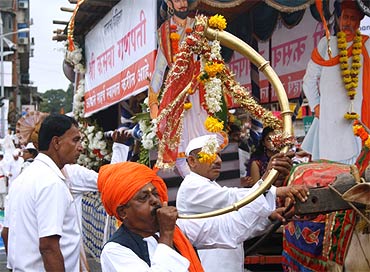Bos primigenius are signified on ANE cylinder seals, artefacts at Tell Hariri (Mari), Temple of Ninhurag Tell al Ubaid and on Indus Script hypertexts.
On Indus Script hypertexts, three forms of bulls are signified:
1. Bos primigenius (unicorns as young bulls with one horn): khōṇḍa m A young bull, a bullcalf. rebus: kunda, 'one of कुबेर's nine treasures', kundaṇa'fine gold'
2. Bos primigenius Indicus (zebu): पोळ [pōḷa], 'zebu, dewlap' rebus: पोळ [pōḷa], 'magnetite, ferrite ore''
3. Bos primigenius taurus (old bull or oax): ḍhangra 'bull'. Rebus: ḍhangar 'blacksmith'. barad, balad, 'ox' rebus: bharata 'metal alloy' (5 copper, 4 zinc and 1 tin
One-horned young bull is NOT a mythical species said to be 'unicorn' but in the genre of Inian aurochs (Bos primigenius).
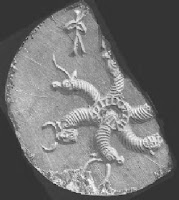 Mohenjo-daro seal m417 six heads from a core.śrēṇikā, 'ladder sãgaḍa 'joined animals' rebus: jangaḍa 'entrustment note (special mercantile transaction for sale or return';jangadiyo 'military guards carrying treasure into the treasury' (Gujarati); sangara 'tade'.
Mohenjo-daro seal m417 six heads from a core.śrēṇikā, 'ladder sãgaḍa 'joined animals' rebus: jangaḍa 'entrustment note (special mercantile transaction for sale or return';jangadiyo 'military guards carrying treasure into the treasury' (Gujarati); sangara 'tade'.Mohenjo-daro seal m417 six heads from a core.śrēṇikā -- f. ʻ tent ʼ lex. and mngs. ʻ house ~ ladder ʼ in *śriṣṭa -- 2, *śrīḍhi -- . -- Words for ʻ ladder ʼ see śrití -- . -- √śri]H. sainī, senī f. ʻ ladder ʼ; Si. hiṇi, hiṇa, iṇi ʻ ladder, stairs ʼ (GS 84 < śrēṇi -- ).(CDIAL 12685). Woṭ. Šen ʻ roof ʼ, Bshk. Šan, Phal. Šān(AO xviii 251) Rebus: seṇi (f.) [Class. Sk. Śreṇi in meaning “guild”; Vedic= row] 1. A guild Vin iv.226; J i.267, 314; iv.43; Dāvs ii.124; their number was eighteen J vi.22, 427; VbhA 466. ˚ -- pamukha the head of a guild J ii.12 (text seni -- ). — 2. A division of an army J vi.583; ratha -- ˚ J vi.81, 49; seṇimokkha the chief of an army J vi.371 (cp. Senā and seniya). (Pali)
This denotes a mason (artisan) guild -- seni -- of 1. brass-workers; 2. blacksmiths; 3. iron-workers; 4. copper-workers; 5. native metal workers; 6. workers in alloys.
The core is a glyphic ‘chain’ or ‘ladder’. Glyph: kaḍī a chain; a hook; a link (G.); kaḍum a bracelet, a ring (G.) Rebus: kaḍiyo [Hem. Des. kaḍaio = Skt. sthapati a mason] a bricklayer; a mason; kaḍiyaṇa, kaḍiyeṇa a woman of the bricklayer caste; a wife of a bricklayer (G.)
The glyphics are: bhaṭa 'warrior' rebus: bhaṭa 'furnace' (for)
1. Glyph: ‘one-horned young bull’: kondh ‘heifer’. kũdār ‘turner, brass-worker’.kundaṇa 'fine gold'
2. Glyph: ‘bull’: ḍhangra ‘bull’. Rebus: ḍhangar ‘blacksmith’.
3. Glyph: ‘ram’: meḍh ‘ram’. Rebus: meḍ ‘iron’
4. Glyph: ‘antelope’: mr̤eka ‘goat’. Rebus: milakkhu ‘copper’. Vikalpa 1: meluhha ‘mleccha’ ‘copper worker’. Vikalpa 2: meṛh ‘helper of merchant’.
5. पोळ [pōḷa], 'zebu, dewlap' rebus: पोळ [pōḷa], 'magnetite, ferrite ore'' Glyph: ‘zebu’: khũṭ ‘zebu’. Rebus: khũṭ ‘guild, community’ (Semantic determinant of the ‘jointed animals’ glyphic composition). kūṭa joining, connexion, assembly, crowd, fellowship (DEDR 1882) Pa. gotta ‘clan’; Pk. gotta, gōya id. (CDIAL 4279) Semantics of Pkt. lexeme gōya is concordant with Hebrew ‘goy’ in ha-goy-im (lit. the-nation-s). Pa. gotta -- n. ʻ clan ʼ, Pk. gotta -- , gutta -- , amg. gōya -- n.; Gau. gū ʻ house ʼ (in Kaf. and Dard. several other words for ʻ cowpen ʼ > ʻ house ʼ: gōṣṭhá -- , Pr. gūˊṭu ʻ cow ʼ; S. g̠oṭru m. ʻ parentage ʼ, L. got f. ʻ clan ʼ, P. gotar, got f.; Ku. N. got ʻ family ʼ; A. got -- nāti ʻ relatives ʼ; B. got ʻ clan ʼ; Or. gota ʻ family, relative ʼ; Bhoj. H. got m. ʻ family, clan ʼ, G. got n.; M. got ʻ clan, relatives ʼ; -- Si. gota ʻ clan, family ʼ ← Pa. (CDIAL 4279). Alternative: adar ḍangra ‘zebu or humped bull’; rebus: aduru ‘native metal’ (Ka.); ḍhangar ‘blacksmith’ (H.)
6. The sixth animal can only be guessed. Perhaps, a tiger (A reasonable inference, because the glyph ’tiger’ appears in a procession on some Indus script inscriptions. Glyph: ‘tiger?’: kol ‘tiger’.Rebus: kol ’worker in iron’. Vikalpa (alternative): perhaps, rhinoceros. gaṇḍa ‘rhinoceros’; rebus:khaṇḍ ‘tools, pots and pans and metal-ware’. Thus, the entire glyphic composition of six animals on the Mohenjodaro seal m417 is semantically a representation of a śrḗṇi, ’guild’, a khũṭ , ‘community’ of smiths and masons.
This guild,community of smiths and masons evolves into Harosheth Hagoyim, 'a smithy of nations'. A cognate word for harosheth is Kharoṣṭhī'an ancient writing system' (ca. 6th century BCE); a cognate word for hagoyim is goya, gotra 'community'. gōtrá n. ʻ cowpen, enclosure ʼ RV., ʻ family, clan ʼ ChUp., gōtrā -- f. ʻ herd of cows ʼ Pāṇ. 2. gōtraka -- n. ʻ family ʼ Yājñ. [gṓ -- ]1. Pa. gotta -- n. ʻ clan ʼ, Pk. gotta -- , gutta -- , amg. gōya -- n.; Gau. gū ʻ house ʼ (in Kaf. and Dard. several other words for ʻ cowpen ʼ > ʻ house ʼ: *gōśrayaṇa -- , gōṣṭhá -- , *gōstha -- (?), ghōṣa -- ); Pr. gūˊṭu ʻ cow ʼ; S. g̠oṭru m. ʻ parentage ʼ, L. got f. ʻ clan ʼ, P. gotar, got f.; Ku. N. got ʻ family ʼ; A. got -- nāti ʻ relatives ʼ; B. got ʻ clan ʼ; Or. gota ʻ family, relative ʼ; Bhoj. H. got m. ʻ family, clan ʼ, G. got n.; M. got ʻ clan, relatives ʼ; -- Si. gota ʻ clan, family ʼ ← Pa. 2. B. H. gotā m. ʻ relative ʼ. gōtrin -- ; sagōtra -- , *sāgōtriya -- ; *gōtragharaka -- ; mātr̥gōtra -- , *mātr̥ṣvasr̥gōtra -- . Addenda: gōtrá -- : Garh. got ʻ clan ʼ; -- A. goṭāiba ʻ to collect ʼ(CDIAL 4279).

Ishtar Gate detail. An aurochs above a flower ribbon with missing tiles filled in (Ishtar Gate bas-relief, housed in the Pergamon Museum in Berlin). A prominent characteristic of Neo-Babylonian art and architecture was the use of brilliantly colorful glazed bricks.
The flowers are Safflowers. करडी [ karaḍī ] f (See करडई) Safflower: also its seed. Rebus: karaḍa 'hard alloy' Rebus: fire-god: @B27990. #16671. Remo <karandi>E155 {N} ``
Thee auroch is: dhangar 'blacksmith' (Maithili) ḍhangra'bull'. Rebus: ḍhangar 'blacksmith'. Mth.ṭhākurʻ blacksmith ʼ (CDIAL 5488) N. ḍāṅroʻterm of contempt for blacksmith'. The artisan's workshop and the work of the engraver, lapidary infixing gems are signified by the hieroglyph components which are read: koḍ, 'workshop', kōnda ‘engraver', kōndaṇa, 'lapidary infixing gems', kundaṇa 'pure gold'
Sumerian cylinder seal impression. Dimensions :- Width - 11.5 cm / 4-1/2 inches Height - 4.5 cm - 1-3/4 inches
Priest King Feeding His Flock,Sumerian, Uruk IV period, ca. 3300–3100 B.C., Modern impression of a marble cylinder seal. Yale Babylonian Collection; NBC 2579.
Hieroglyph: kola 'tiger' Rebus: kol 'kolhe, smelters'; 'working in iron'
Hieroglyph: ibha 'elephant' Rebus: ib 'iron' (Santali) ibbo 'merchant' (Des'i)
Hieroglyph: zebu: पोळ [ pōḷa ] m A bull dedicated to the gods, marked with a trident and discus, and set at large. pōḷī, ‘dewlap, honeycomb’
Rebus: pola (magnetite)
tALa 'palm' rebus: dhALa 'large ingot'.
Skt. mūkaka- id. (DEDR 5023) Rebus: mū̃h 'ingot'. Muha. The quantity of iron produced at one time in a native smelting furnace'
arka 'sun' rebus: arka 'gold' eraka 'moltencast'
 Hình dáng trống đồng Làng Vạc 1
Hình dáng trống đồng Làng Vạc 1Zebu on a cire perdue inscription with Indus Script hieroglyphs on a Dong Son Bronze Drum

Dong Son drum from selayar? Note: hieroglyphs of elephant, trees and peacocks
Source: https://www.flickr.com/photos/doremon360/1528885793/in/album-72157621598852916/
Hieroglyph: mora 'peacock' moraa 'peafowl' (Hindi) Rebus: morakkhaka loha 'a kind of coper, grouped with pis'aacaloha' (Pali); moraka 'a kind of steel' (Samskritam)
Hình thuyền trên một trống đồng Điền (nguồn 1).
Dong Son Bronze artiface. Zebu and a rider.

The Hagia Triada Mycenaean sarcophagus, 14th century BC, depicting the earliest lyre with seven strings, held by a man with long robe, third from the left.

A lyrist on the Standard of Ur, believed to date to between 2600–2400 BCE. "There are several hypotheses as to the origin of the instrument. One suggests that it descended from the kopuz, a string instrument still in use among the Turkic peoples of Central Asia and the Caspian region.[1] The name itself derives from the tanbur (tunbur). Tanbur in turn might have descended from the Sumerian pantur." https://en.wikipedia.org/wiki/Turkish_tambur
Hieroglyph: kã̄ḍ reed Rebus: kāṇḍa 'tools, pots and pans, metal-ware'.
Hieroglyph: tanbūra 'lyre' Rebus: tam(b)ra 'copper'.

 Sumerian silverlyvr c. 2600-2400
Sumerian silverlyvr c. 2600-2400
 SUMERIAN STYLE STONE HUMAN-HEADED BULL. | A carved stone figure of a recumbent bull with human face and flowing beard, in the Sumerian style. https://www.pinterest.com/pin/406520303842287234/
SUMERIAN STYLE STONE HUMAN-HEADED BULL. | A carved stone figure of a recumbent bull with human face and flowing beard, in the Sumerian style. https://www.pinterest.com/pin/406520303842287234/
2600-2500 BCE. Mesopotamian Incised Shell Inlay; combat between a human-headed bull and a lion-headed eagle. Shell. Early Dynastic IIIa. The MET

Serpentine figurine of a human headed bison - Mesopotamian, Neo-sumerian period, 2080 BC. From Girsu. Metropolitan Museum.

Stamp seal with the head of a bearded bull-man. Sumerian. Early Dynastic Period
 Neo-Sumerian Statuette of an Androcephalous Bull, C. 2350-2000 BCE Made of Chlorite with inlays (now mostly missing) https://www.pinterest.com/pin/500603314813555767
Neo-Sumerian Statuette of an Androcephalous Bull, C. 2350-2000 BCE Made of Chlorite with inlays (now mostly missing) https://www.pinterest.com/pin/500603314813555767/![7 - Enkidu, Enki's creation, Gilgamesh's companion]() Enkidu, Enki's creation, Gilgamesh's companion
Enkidu, Enki's creation, Gilgamesh's companion
 Enkidu, Enki's creation, Gilgamesh's companion
Enkidu, Enki's creation, Gilgamesh's companion The aurochs was variously classified as Bos primigenius, Bos taurus, or, in old sources, Bos urus. International Commission on Zoological Nomenclature confirmed Bos primigenius for the aurochs....The oldest aurochs remains have been dated to about 2 million years ago, in India. The Indian subspecies was the first to appear. During the Pleistocene, the species migrated west into the Middle East (western Asia), as well as to the east. They reached Europe about 270,000 years ago. (van Vuure, Cis (2005). Retracing the Aurochs – History, Morphology and Ecology of an extinct wild Ox. ) The South Asian domestic cattle, or zebu, descended from Indian aurochs at the edge of the Thar Desert; the zebu is resistant to drought. Domestic yak, gayal, and Bali cattle do not descend from aurochs. The first complete mitochondrial genome (16,338 base pairs) DNA sequence analysis of Bos primigenius from an archaeologically verified and exceptionally well preserved aurochs bone sample was published in 2010. (Edwards, C.J.; Magee, D.A.; Park, S.D.E.; McGettigan, P.A.; Lohan, A.J.; et al. (2010). "A Complete Mitochondrial Genome Sequence from a Mesolithic Wild Aurochs (Bos primigenius)"". PLoS ONE. 5 (2): e9255.)

Cups, depicting a domestic bull, found in the royal tomb of Vaphio, Sparta, late Minoan I, c.1500 BCE (gold) (Ajmone-Marsan, P.; Garcia, J.F.; Lenstra, J.A. (2010). "On the Origin of Cattle: How Aurochs Became Cattle and Colonized the World". Evolutionary Anthropology. 19(4): 148–157) One of the bulls throws one hunter on the ground while attacking the second with its horns. The cup despite the older perception of being Minoan seems to be Mycenaean. (Davis, E.N. (1974). "The Vapheio Cups: One Minoan and One Mycenean?". The Art Bulletin. 56 (4): 472–487. .(De Grummond, W.W. (1980). "Hands and Tails on the Vapheio Cups". American Journal of Archaeology. 84(3): 335–337.) The Hebrew Bible contains numerous references to the untameable strength of re'em, translated as "bullock" or "wild-ox" in Jewish translations and translated rather poorly in the King James Version as "unicorn", but recognised from the last century by Hebrew scholars as the aurochs. (The identification was first made by Johann Ulrich Duerst, Die Rinder von Babylonian, Assyrien und Ägypten(Berlin, 1899:7-8), and was generally accepted, as by Salo Jonas, "Cattle Raising in Palestine" Agricultural History 26.3 (July 1952), pp. 93-104; The International Standard Bible Encyclopedia, Entry for 'Wild Ox'. Wm. B. Eerdmans Publishing Co. 1939.)_






Vaso de Vafio tallado en oro (h.1500 a.C.) Museo Nacional de Atenas. It's an elaborate cup made out of gold and has great attention to detail.
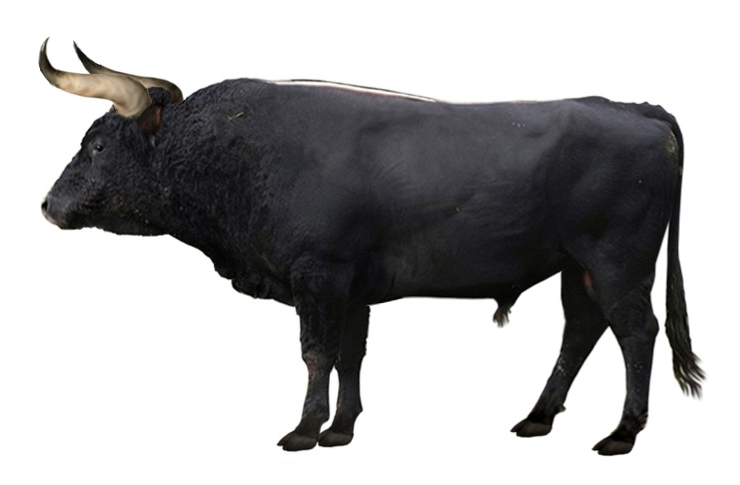

Life restoration of an aurochs bull found in Braunschweig, Germany; Speculative life restoration of the enigmatic Indian aurochs (B. p. namadicus)
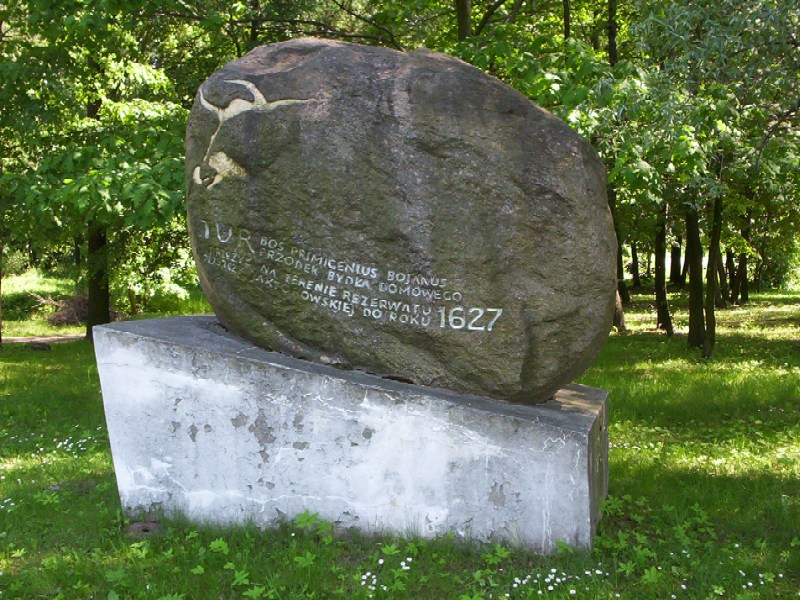
The inscription reads: "The Aurochs – Bos primigenius bojanus, the ancestor of domestic cattle, lived in this forest Jaktorów until the year 1627."

Cro-Magnon graffito of Bos primigenius in Grotta del Romito, Papasidero, Italy
in South India.(Shanyuan Chen, et al, "Zebu Cattle Are an Exclusive Legacy of the South Asia Neolithic", Mol Biol Evol (2010) 27(1): 1-6 ).
Indian zebu, although domesticated eight to ten thousand years ago, are related to aurochs that diverged from the Near Eastern ones some 200,000 years ago. African cattle are thought to have descended from aurochs more closely related to the Near Eastern ones. The Near East and African aurochs groups are thought to have split some 25,000 years ago, probably 15,000 years before domestication. The "Turano-Mongolian" type of cattle now found in northern China, Mongolia, Korea, and Japan may represent a fourth domestication event (and a third event among B. taurus–type aurochs). This group may have diverged from the Near East group some 35,000 years ago. Whether these separate genetic populations would have equated to separate subspecies is unclear. (Hideyuki Mannen; et al. (August 2004). "Independent mitochondrial origin and historical genetic differentiation in North Eastern Asian cattle" (PDF). Molecular Phylogenetics and Evolution, Volume 32, issue 2. pp. 539–544.)
The maximum range of the aurochs was from Europe (excluding Ireland and northern Scandinavia), to northern Africa, the Middle East, India, and Central Asia.("History, Morphology And Ecology Of The Aurochs"(PDF) (McKenzie, Steven (17 February 2010). "Ancient giant cattle genome first". BBC News.) Until at least 3,000 years ago, the aurochs was also found in eastern China, where it is recorded at the Dingjiabao Reservoir in Yangyuan County. Most remains in China are known from the area east of 105°E, but the species has also been reported from the eastern margin of the Tibetan plateau, close to the Heihe River.(Zong, G (1984). A record of Bos primigenius from the Quaternary of the Aba Tibetan Autonomous Region, Volume XXII No. 3. Vertebrata PalAsiatica. pp. 239–245.)In Japan, excavations in various locations such as in Iwate and Tochigi prefectures have found aurochs which may have herded with steppe bisons.(HASEGAWA Y.,OKUMURA Y., TATSUKAWA H. (2009). "First record of Late Pleistocene Bison from the fissure deposits of the Kuzuu Limestone, Yamasuge,Sano-shi,Tochigi Prefecture,Japan" (pdf). Bull.Gunma Mus.Natu.Hist.(13). Gunma Museum of Natural History and Kuzuu Fossil Museum: 47–52.).

The Vig-aurochs, one of two very well-preserved aurochs skeletons found in Denmark. The circles indicate where the animal was wounded by arrows.

Mounted skeleton of a bull found in Vig, Denmark, National Museum of Denmark

Charles Hamilton Smith's copy of a painting possibly dating to the 16th century![]()
Restoration of the aurochs based on a bull skeleton from Lund and a cow skeleton from Cambridge, with chart of characteristic external features of the aurochs
![]()
![phantasmagoricaldreams: Detail of a Mushussu, symbol of the god Marduk, from the Ishtar gate. Babylon (575 BC)]()
![]()
![]() Handbuch der altorientalischen Geisteskultur von Jeremias, Alfred. Leipzig 1913. Seite 283. Anshar standing on a bull. Excavated from one of the ancient capitals of Assyria, Assur. "Ashur (also, Assur, Aššur; cuneiform: 𒀭𒀸𒋩 dAš-šur) is an East Semitic god, and the head of the Assyrian pantheon in Mesopotamian religion, worshipped mainly in the northern half of Mesopotamia, and parts of north-east Syria and south east Asia Minor which constituted old Assyria. He may have had a solar iconography.Aššur was a deified form of the city of Assur, which dates from the mid 3rd millennium BC and was the capital of the Old Assyrian kingdom."https://en.wikipedia.org/wiki/Ashur_(god)
Handbuch der altorientalischen Geisteskultur von Jeremias, Alfred. Leipzig 1913. Seite 283. Anshar standing on a bull. Excavated from one of the ancient capitals of Assyria, Assur. "Ashur (also, Assur, Aššur; cuneiform: 𒀭𒀸𒋩 dAš-šur) is an East Semitic god, and the head of the Assyrian pantheon in Mesopotamian religion, worshipped mainly in the northern half of Mesopotamia, and parts of north-east Syria and south east Asia Minor which constituted old Assyria. He may have had a solar iconography.Aššur was a deified form of the city of Assur, which dates from the mid 3rd millennium BC and was the capital of the Old Assyrian kingdom."https://en.wikipedia.org/wiki/Ashur_(god)
खोंड (p. 122) khōṇḍa m A young bull, a bullcalf. 2 A variety of जोंधळा. जोंधळा (p. 187) jōndhaḷā m A cereal plant or its grain, Holcus sorghum. Eight varieties are reckoned, viz. उता- वळी, निळवा, शाळू, रातडी, पिवळा जोंधळा, खुंडी, काळबोंडी जोंधळा, दूध मोगरा. There are however many others as केळी, अरगडी, डुकरी, बेंदरी, मडगूप &c. Rebus: kundār 'turner' kunda 'gold, nidhi' Ta. kuntaṉam interspace for setting gems in a jewel; fine gold (< Te.). Ka. kundaṇa setting a precious stone in fine gold; fine gold; kundana fine gold. Tu. kundaṇa pure gold. Te. kundanamu fine gold used in very thin foils in setting precious stones; setting precious stones with fine gold.(DEDR 1725)
kāṇḍa 'reeds' rebus: kaṇḍa 'fire-altar'. khaṇḍa 'implements' (Santali)
![Image result for mari standard]() Standard of Mari. The standard-bearer has a shaven face and head. The staff upholding the one-horned young bull is
Standard of Mari. The standard-bearer has a shaven face and head. The staff upholding the one-horned young bull is खोंड a variety of jōndhaḷā Holcus sorghum; the hieroglyph signifies karba 'culm of millet' rebus: karba 'iron'.
The standard bearer looks like the priest shown on the Tell al Ubaid temple architectural frieze.
![]() Baghdad. Iraq. ca. 2002: Sumerian frieze with inlay of cows. Part of a pastoral scene. Temple of Ninhursag, Tell al Ubaid c 2475 BCE. National Museum of Iraq before it was looted in the Gulf War. https://tinyurl.com/ycwaqgcb Two calves are seen to emerge out of bot sides of the doorway (reed posts).
Baghdad. Iraq. ca. 2002: Sumerian frieze with inlay of cows. Part of a pastoral scene. Temple of Ninhursag, Tell al Ubaid c 2475 BCE. National Museum of Iraq before it was looted in the Gulf War. https://tinyurl.com/ycwaqgcb Two calves are seen to emerge out of bot sides of the doorway (reed posts).![Image result for british museum mudhif byre]()
![Image result for british museum mudhif byre]()
![Libation Offered to a Vegetation Goddess (Claude Valette)]()
![LYRE Sumerian stela National Museum of Iraq]()
![Image result for british museum mudhif byre]()
"The sculpture was discovered in 1919 at the base of a temple foundation made from mud and brick at the isolated Sumerian site of Tell al-`Ubaid, close to the ancient city of Ur in southern Iraq. Archaeologistshave determined from extant inscriptions and sculptures that the temple was dedicated to the goddess Ninhursag. Based on where it was originally found, it has been suggested that the copper panel was located above the temple door, in full view of the congregation...The central figure in the restored lintel shows the lion-headed eagle Imdugud who is the symbol of the god Ningirsu. Flanking either side of the god are two stags, one of whose heads has been restored. The relief was beaten out of a very large piece of copper and almost seems to stand apart from the background." https://en.wikipedia.org/wiki/Tell_al-%60Ubaid_Copper_Lintel

Restoration of the aurochs based on a bull skeleton from Lund and a cow skeleton from Cambridge, with chart of characteristic external features of the aurochs
The aurochs (/ˈɔːrɒks/ or /ˈaʊrɒks/; pl. aurochs, or rarely aurochsen, aurochses), also urus, ure (Bos primigenius), is an extinct species of large wild cattle that inhabited Europe, Asia, and North Africa. It is the ancestor of domestic cattle and the European bison, crossbred with Steppe bison...During the Neolithic Revolution, which occurred during the early Holocene, at least two aurochs domestication events occurred: one related to the Indian subspecies, leading to zebu cattle, and the other one related to the Eurasian subspecies, leading to taurine cattle. Other species of wild bovines were also domesticated, namely the wild water buffalo, gaur, wild yak and banteng. In modern cattle, numerous breeds share characteristics of the aurochs, such as a dark colour in the bulls with a light eel stripe along the back (the cows being lighter), or a typical aurochs-like horn shape. https://en.wikipedia.org/wiki/Aurochs
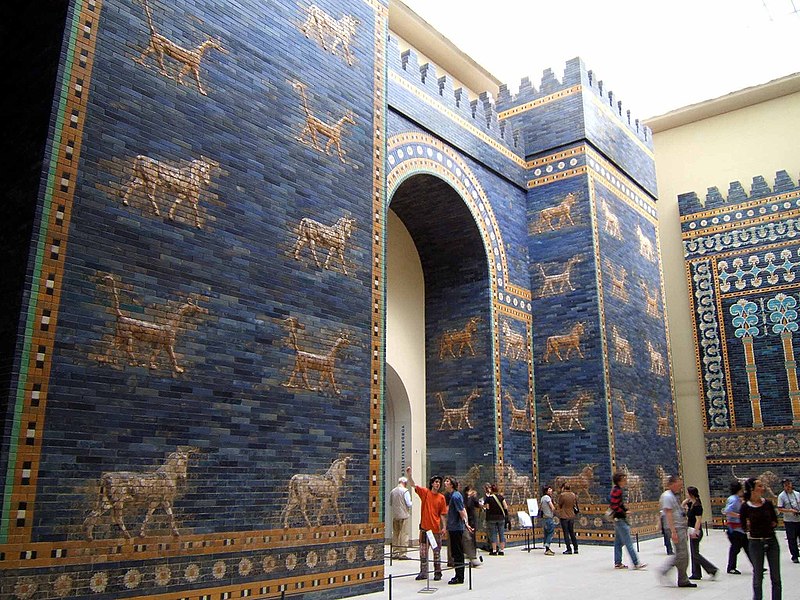
The reconstruction of the Ishtar Gate in the Pergamon Museum in Berlin. The Ishtar Gate was the eighth gate to the inner city of Babylon. It was constructed in about 575 BCE, and edicated to the Babylonian goddess Ishtar

Detail of a Mushussu, symbol of the god Marduk, from the Ishtar gate. Babylon (575 BCE) built on the instructions of King Nebuchadnezzar II

Marduk and his dragon Mušḫuššu, from a Babylonian cylinder seal (Willis, Roy (2012). World Mythology. New York: Metro Books. p. 62. )
kāṇḍa 'reeds' rebus: kaṇḍa 'fire-altar'. khaṇḍa 'implements' (Santali)
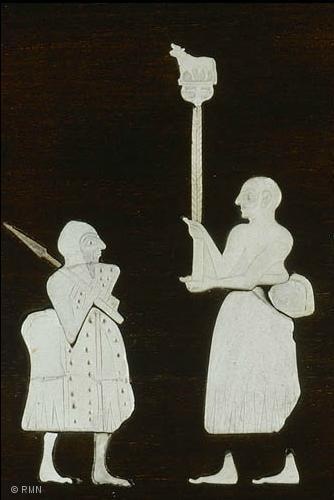 Standard of Mari. The standard-bearer has a shaven face and head. The staff upholding the one-horned young bull is
Standard of Mari. The standard-bearer has a shaven face and head. The staff upholding the one-horned young bull is The standard bearer looks like the priest shown on the Tell al Ubaid temple architectural frieze.


Statue of Kurlil. Found next to the Temple of Ninhursag in Tell al-Ubaid. Southern Iraq. 2500 BC. British Museum. http://www.alamy.com/stock-photo-mesopotamia-early-dynastic-period-statue-of-kurlil-found-next-to-the-78771104.html
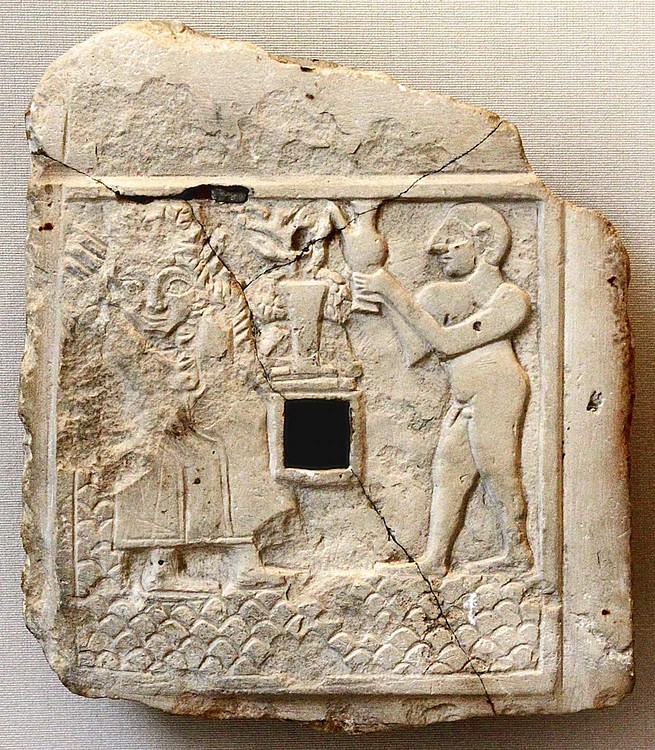
Libation offered to vegetation divinity. Temple of Ninhursag. https://www.ancient.eu/Ninhursag/

Lyre Sumerian stela National Museum of Iraq https://www.pinterest.com/pin/366691594637065820/

Figure 15.6. Tell al Ubaid, Temple of Ninhursag. Tridacna shell inlaid architectural frieze with bitumen and black shale. Early Dynastic period (ca. 2600 b.c.) (Hall and Woolley 1927)
Figure 15.5. Tell al Ubaid, Temple of Ninhursag. Tridacna shell-inlaid architectural frieze with bitumen and black shale. Early Dynastic period (ca. 2600 b.c.e.) (© The Trustees of the British Museum)
 The Copper Bull on display | |
| Material | Copper |
|---|---|
| Size | Length: 60.96 cm Height: 60.96 cm |
| Created | 2600 BCE |
| Discovered | 1923 Tell al-`Ubaid |
| Discovered by | Leonard Woolley |
| Present location | British Museum, London |
| Identification | ME 116740 |
 Tell al-`Ubaid Copper Lintel on display in the British Museum | |
| Material | Copper |
|---|---|
| Size | Length 2.59 metres, Height 1.07 metres |
| Created | 2600-2400 BC |
| Present location | British Museum, London |
| Identification | ME 114308 |
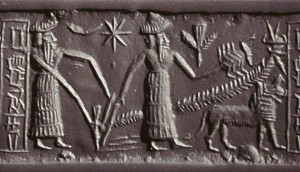 Cylinder seal impression. Plough. Star. Culm of millet. Bull? Source of picture: http://www.mesopotamiangods.com/tag/mans-spirit/
Cylinder seal impression. Plough. Star. Culm of millet. Bull? Source of picture: http://www.mesopotamiangods.com/tag/mans-spirit/
| Akkadian cylinder seal impression depicting a vegetation goddess, possibly Ninhursag, sitting on a throne surrounded by worshippers (circa 2350-2150 BC) | |
| Symbol | Omega-like symbol omega Ω, |
|---|---|
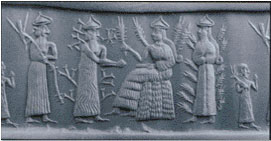 Cyliner seal impression. Person at the rightmost register is a Meluhha, holds a goat. A person with plough is introduced. Source of picture: http://www.mesopotamiangods.com/category/ur/page/3/
Cyliner seal impression. Person at the rightmost register is a Meluhha, holds a goat. A person with plough is introduced. Source of picture: http://www.mesopotamiangods.com/category/ur/page/3/In Sumerian religion, Ninḫursaĝ (𒀭𒊩𒌆𒉺𒂅 DNIN-ḪUR.SAG)[2][3][4][5][6][7][8][9] was a mother goddess of the mountains, and one of the seven great deities of Sumer.
Image: branch of tree: dhamkara 'leafless tree' Rebus: dhangar '
कोंडी (p. 102) kōṇḍī f (कोंडणें) A confined place gen.; a lockup house, a pen, fold, pound; a receiving apartment or court for Bráhmans gathering for दक्षिणा; a prison at the play of आट्यापाट्या; a dammed up part of a stream &c. &c. कोंडवाडकोंडण (p. 102) kōṇḍaṇa f A fold or pen. कोंडमार (p. 102) kōṇḍamāra or -मारा m (कोंडणें & मारणें) Shutting up in a confined place and beating. Gen. used in the laxer senses of Suffocating or stifling in a close room; pressing hard and distressing (of an opponent) in disputation; straitening and oppressing (of a person) under many troubles or difficulties; कोंडाळें (p. 102) kōṇḍāḷēṃ n (कुंडली S) A ring or circularly inclosed space. 2 fig. A circle made by persons sitting round. कोंड (p. 102) kōṇḍa m C A circular hedge or field-fence. 2 A circle described around a person under adjuration. 3 The circle at marbles. 4 A circular hamlet; a division of a मौजा or village, composed generally of the huts of one caste. 5 Grounds under one occupancy or tenancy. 6 f R A deep part of a river. 7 f (Or कोंडी q. v.) A confined place gen.; a lock-up house &c.
कोंडण kōṇḍaṇa, 'cattlepen', Mesopotamia Rebus: kundaṇa 'fine gold'
Mudhif and three reed banners
![08-02-14/62 Fragment of a stele,...]()
![Image result for bharatkalyan97 mudhif]() A cow and a stable of reeds with sculpted columns in the background. Fragment of another vase of alabaster (era of Djemet-Nasr) from Uruk, Mesopotamia.Fragment of a stele, raised standards. From Tello.Hieroglyphs: Quadrupeds exiting the mund (or mudhif) are pasaramu, pasalamu ‘an animal, a beast, a brute, quadruped’ (Telugu) పసరము [ pasaramu ] or పసలము pasaramu. [Tel.] n. A beast, an animal.
A cow and a stable of reeds with sculpted columns in the background. Fragment of another vase of alabaster (era of Djemet-Nasr) from Uruk, Mesopotamia.Fragment of a stele, raised standards. From Tello.Hieroglyphs: Quadrupeds exiting the mund (or mudhif) are pasaramu, pasalamu ‘an animal, a beast, a brute, quadruped’ (Telugu) పసరము [ pasaramu ] or పసలము pasaramu. [Tel.] n. A beast, an animal. గోమహిషహాతి .
Omur Harmansah, 2012, The cattlepen and the sheepfold: cities, temples, and pastoral power in Ancient Mesopotamia, in:Deena Ragavan (ed.), Heaven on earth, temples, ritual, and cosmic symbolism in the ancient world, Oriental Institute, Univ. of Chicago, 2012, pp. 374-394
![ancient relief of reed huts in Mesopotamia; columns of bound reeds like quansut huts https://www.youtube.com/watch?t=3&v=3TIcVJGfjLU]() ancient relief of reed huts in Mesopotamia; columns of bound reeds like quansut huts https://www.youtube.com/watch?t=3&v=3TIcVJGfjLU
ancient relief of reed huts in Mesopotamia; columns of bound reeds like quansut huts https://www.youtube.com/watch?t=3&v=3TIcVJGfjLU
![]()
One side (m1431B) of a four-sided tablet shows a procession of a tiger, an elephant and a rhinoceros (with fishes (or perhaps, crocodile) on top?).
![tammuz: One of two Babylonian lions at the Oriental Institute Museum in Chicago, dating back to 575 BCE. In the equivalent of Babylon’s Time Square, 120 life-size lions symbolizing the goddess Ishtar lined the walls of the Processional Street, where the entire city celebrated the New Year: the Resurrection of Tammuz, the Babylonian god of harvest. The Oriental Institute Museum at the University of Chicago, Chicago, IL. Photo by Babylon Chronicle]() tammuz: One of two Babylonian lions at the Oriental Institute Museum in Chicago, dating back to 575 BCE. In the equivalent of Babylon’s Time Square, 120 life-size lions symbolizing the goddess Ishtar lined the walls of the Processional Street, where the entire city celebrated the New Year: the Resurrection of Tammuz, the Babylonian god of harvest. The Oriental Institute Museum at the University of Chicago, Chicago, IL
tammuz: One of two Babylonian lions at the Oriental Institute Museum in Chicago, dating back to 575 BCE. In the equivalent of Babylon’s Time Square, 120 life-size lions symbolizing the goddess Ishtar lined the walls of the Processional Street, where the entire city celebrated the New Year: the Resurrection of Tammuz, the Babylonian god of harvest. The Oriental Institute Museum at the University of Chicago, Chicago, IL![Aurochs from Ishtar gate (Illustration) - Ancient History Encyclopedia]() Aurochs from Ishtar Gate at Babylon, constructed in about 575 BCE by order of King Nebuchadnezzar II. On display in Istanbul Archaeology Museum in Istanbul, Turkey.
Aurochs from Ishtar Gate at Babylon, constructed in about 575 BCE by order of King Nebuchadnezzar II. On display in Istanbul Archaeology Museum in Istanbul, Turkey.![]()
![]()
![]()
![]() The cuneiform inscription of the Ishtar Gate in the Pergamon Museum in Berlin
The cuneiform inscription of the Ishtar Gate in the Pergamon Museum in Berlin![“Ishtar Gate,” Iraq from Matson Collection, 1932]()
![]()
![A Sumerian sculpture housed in the British Museum. The statue is that of a ram with glorious curved horns. The Sumerians used the ram as a symbol of their culture.]()
![Couple de musiciens Vers 2500 - 2400 avant J.-C. Mari, temple d'Ishtar Albâtre | Site officiel du musée du Louvre]()
![KNEELING FIGURE BOUND WITH SERPENTS Circa 2600 BC-Circa 2400 BC Early Dynastic/Sumerian Tell es-Sukhairi/Iraq]()
Parrot André, Tello, vingt campagnes de fouilles, 1877-1933, Paris, Albin Michel, 1948, pp. 174-176, pl. 20a.
Rutten Marguerite-Maggie, "Scènes de musique et de danse", in Revue des arts asiatiques, Paris, École française d'Extrême-Orient, 1935, p. 220, fig. 8.
Sarzec Édouard de, Découvertes en Chaldée, Paris, Leroux, 1884-1912, pp. 36 et 219-221, pl. 23.
Sillamy Jean-Claude, La Musique dans l'ancien Orient ou la théorie musicale suméro-babylonienne, Villeneuve d'Ascq, Presses universitaires du Septentrion, 1998, p. 160.
![Cylinder seal and imprint from Mari, Archaic Dynasties. Top register: agricultural scene, milking cows, goats. Bottom register: Human-headed bull between two heroes with maces;eagle with lion-head. H: 4,3 cm AO 10920 Louvre, Departement des Antiquites Orientales, Paris, France]()
Cylinder seal and imprint from Mari, Archaic Dynasties. Top register: agricultural scene, milking cows, goats. Bottom register: Human-headed bull between two heroes with maces;eagle with lion-head. H: 4,3 cm AO 10920 Louvre, Departement des Antiquites Orientales, Paris, France
https://www.pinterest.com/pin/496662665130957573/
![AN ELAMITE GREEN STONE CYLINDER SEAL CIRCA 3000 B.C. With the figure of a striding bull, head raised, with large curling horns and dotted eyes, a stylized flowering tree in front, two conjoined scrolling lines in the field 1 in. (2.5 cm.) high]()
AN ELAMITE GREEN STONE CYLINDER SEAL CIRCA 3000 B.C.E With the figure of a striding bull, head raised, with large curling horns and dotted eyes, a stylized flowering tree in front, two conjoined scrolling lines in the field 1 in. (2.5 cm.) high https://www.pinterest.com/pin/191966002839912556/
![AN ELAMITE CHALCEDONY CYLINDER SEAL CIRCA 3000-2800 B.C. With recumbent bull and ibex one behind the other, stylized branch and bird in the field, an eagle with outstretched wings above with a U-shaped design between, with remains of bronze pin 1¼ in. (3.2 cm.) high]()
AN ELAMITE CHALCEDONY CYLINDER SEAL CIRCA 3000-2800 B.C.E With recumbent bull and ibex one behind the other, stylized branch and bird in the field, an eagle with outstretched wings above with a U-shaped design between, with remains of bronze pin 1¼ in. (3.2 cm.) high https://www.pinterest.com/pin/137641332334231619/
![Proto Elamite, Jedmet Nasr, 3100BC-3000BC. Streaked pale yellow-brown steatite or calcite cylinder seal with blue-grey patches; two goats; in field - 'Maltese' cross, circled dots.]()
Proto Elamite, Jedmet Nasr, 3100BC-3000BC. Streaked pale yellow-brown steatite or calcite cylinder seal with blue-grey patches; two goats; in field - 'Maltese' cross, circled dots.
https://www.pinterest.com/pin/360288038911890117/
![2700 BCE Early Dynastic. Abu Habba, Sippar Iraq. Aragonite cylinder seal; contest scene; in the centre - a bearded nude male with 6 roundels around his head termed a "crested head-dress", holds a bull in each hand.]()
2700 BCE Early Dynastic. Abu Habba, Sippar Iraq. Aragonite cylinder seal; contest scene; in the centre - a bearded nude male with 6 roundels around his head termed a "crested head-dress", holds a bull in each hand. https://www.pinterest.com/pin/229402174741114484/
![lira de Ur]() lira de Ur
lira de Ur
https://www.pinterest.com/pin/587367976373653903/
![]()
![Iku-shamagan, King of Mari. Detail of 08-02-08/8. Steatit statuette (2650 BCE) Early dynastic period II, from the temple of Ishtar at Mari, Syria National Museum Damasco,Syria]()
![MARI SCULPTURE 3RD-2ND MILL.BCE Man carrying a sacrificial lamb (upper part of body) Steatite statuette Akkade dynasty (2460-2290 BCE) from the Anonymous Temple, Mari, Syria Height 23 cm National Museum, Aleppo, Syria]()
![Ebih-Il DA, 2400 BC Mari, temple d'Ishtar Gypse, lapis, coquille 52,5 x 20,6 x 30 cm Musée du Louvre]()
![Statue of Ebih-Il, superintendent of Mari Material: Gypsum, schist, shells, lapis lazuli. c. 2400 BC]()
![]() Soldier at Mari carrying weapons and implements.
Soldier at Mari carrying weapons and implements.!["The Standard of Ur" is a Sumerian artifact excavated from the Royal Cemetery in the ancient city of Ur (modern-day Iraq south of Baghdad). It is approximately 4,500 years old. It was found next to the skeleton of a ritually sacrificed man who may have been its bearer. It is now on display, in reconstructed form, in the British Museum in London.]()
![Standard of Ur- Both sides- Sumerian]()
![Once de cien]()
![The Royal lyre: Several lyres were found in the Royal Tombs of Ur, along with the bodies of the women who played them. Woolley reports that one woman lay with her arm draped across her lyre, with the bones of her hand where the strings had been, as if playing it.]()
![This lyre was found in the 'Great Death-Pit', one of the graves in the Royal Cemetery at Ur. From Ur, southern Mesopotamia, Iraq. Early dynastic period, 2600-2400 BCE. (The British Museum, London)]() This lyre was found in the 'Great Death-Pit', one of the graves in the Royal Cemetery at Ur. From Ur, southern Mesopotamia, Iraq. Early dynastic period, 2600-2400 BCE. (The British Museum, London)
This lyre was found in the 'Great Death-Pit', one of the graves in the Royal Cemetery at Ur. From Ur, southern Mesopotamia, Iraq. Early dynastic period, 2600-2400 BCE. (The British Museum, London) ![Harpiste sumer]()
![Lyres from The Royal Tombs of Ur]()
![Bull's head of the famous Gold lyre of Ur found in the royal cemetery of Ur, early dynastic 2600- 2400 BCE, Mesopotamia. Iraq]()
!["Woman With Folded Hands" Mesopotamian, Sumerian, Early Dynastic c. 2650-2250 BCE woman wearing what both men and women wore, the Kaunakes garment in the form of a wrapped skirt. Her hair seems to be pulled into a Chignon held in place with a Fillet, and the date could possibly assume that she is wearing her hair confined in a net also.]() "Woman With Folded Hands" Mesopotamian, Sumerian, Early Dynastic c. 2650-2250 BCE woman wearing what both men and women wore, the Kaunakes garment in the form of a wrapped skirt. Her hair seems to be pulled into a Chignon held in place with a Fillet, and the date could possibly assume that she is wearing her hair confined in a net also.
"Woman With Folded Hands" Mesopotamian, Sumerian, Early Dynastic c. 2650-2250 BCE woman wearing what both men and women wore, the Kaunakes garment in the form of a wrapped skirt. Her hair seems to be pulled into a Chignon held in place with a Fillet, and the date could possibly assume that she is wearing her hair confined in a net also. ![Sumerian Standing Female found in Dayala khafaji about 2600 B.C.]() Found in Dayala khafaji about 2600 B.C.E
Found in Dayala khafaji about 2600 B.C.E![SUMERIAN ART: Statues from the Abu Temple c. 2700 - 2500 B.C. Stone sculptures of deities. Tallest is 30" high. Colored inlayed eyes. Bodies and faces simplified in order to avoid distracting attention from eyes. Arms and legs have roundness of pipes. Frontal, rigid and symmetrical like Egyptian art. LOCATION: IRAQ MUSEUM, BAGHDAD & THE ORIENTAL INSTITUTE, THE UNIVERSITY OF CHICAGO]()
![Image result for idi narum cuneiform tell hariri]() Head of a woman wearing a polos, found in the Temple of Ishtar at Mari https://www.pinterest.com/pin/294352525618311086/?lp=true
Head of a woman wearing a polos, found in the Temple of Ishtar at Mari https://www.pinterest.com/pin/294352525618311086/?lp=true
![]() A schematic representation of some key Arabian Sea-Savannah zone biotic transfers of prehistory (the “Bronze Age horizon”). The question of how precisely African crops reached India beginning around 2000 BCE has now attracted the attention of archaeologists and botanists for decades...First, there was an earlier circum-Arabia or Arabian Sea phase of the Middle Bronze Age (from 2000 BCE), in which domesticates were transferred between the northern African savannahs and the savannah zones of India (Figure 1). Then there was a later mid-Indian Ocean phase that may be regarded as generally Iron Age (late centuries BCE to early centuries CE), which began to draw South India, South-east Asia and East Africa into the wider remit of trade/contact, setting the stage for a genuinely Indian Ocean world. In addition, we would like to draw attention to the significance of transfers of commensal animals and weeds, a largely unstudied but potentially revealing body of evidence for early human contacts across the Arabian Sea and the Indian Ocean."”We will suggest that there are two broad phases and sets of processes in intercontinental transfers. First, there was an earlier circum-Arabia or Arabian Sea phase of the Middle Bronze Age (from 2000 BCE), in which domesticates were transferred between the northern African savannahs and the savannah zones of India (Figure 1). Then there was a later mid-Indian Ocean phase that may be regarded as generally Iron Age (late centuries BCE to early centuries CE), which began to draw South India, South-east Asia and East Africa into the wider remit of trade/contact, setting the stage for a genuinely Indian Ocean world.” "About twenty years ago Cleuziou and Tosi (1989: 15) referred to the prehistoric Arabian peninsula as a “conveyor belt between the two continents, channelling an early dispersal of domestic plants and animals.”
A schematic representation of some key Arabian Sea-Savannah zone biotic transfers of prehistory (the “Bronze Age horizon”). The question of how precisely African crops reached India beginning around 2000 BCE has now attracted the attention of archaeologists and botanists for decades...First, there was an earlier circum-Arabia or Arabian Sea phase of the Middle Bronze Age (from 2000 BCE), in which domesticates were transferred between the northern African savannahs and the savannah zones of India (Figure 1). Then there was a later mid-Indian Ocean phase that may be regarded as generally Iron Age (late centuries BCE to early centuries CE), which began to draw South India, South-east Asia and East Africa into the wider remit of trade/contact, setting the stage for a genuinely Indian Ocean world. In addition, we would like to draw attention to the significance of transfers of commensal animals and weeds, a largely unstudied but potentially revealing body of evidence for early human contacts across the Arabian Sea and the Indian Ocean."”We will suggest that there are two broad phases and sets of processes in intercontinental transfers. First, there was an earlier circum-Arabia or Arabian Sea phase of the Middle Bronze Age (from 2000 BCE), in which domesticates were transferred between the northern African savannahs and the savannah zones of India (Figure 1). Then there was a later mid-Indian Ocean phase that may be regarded as generally Iron Age (late centuries BCE to early centuries CE), which began to draw South India, South-east Asia and East Africa into the wider remit of trade/contact, setting the stage for a genuinely Indian Ocean world.” "About twenty years ago Cleuziou and Tosi (1989: 15) referred to the prehistoric Arabian peninsula as a “conveyor belt between the two continents, channelling an early dispersal of domestic plants and animals.”
![]()
![]() As a proclamation of a metallurgical achievement, this composition of a culm of millet upholding kōnda ‘engraver', kōndaṇa, 'lapidary infixing gems' is a signifier of the competence to create a ferrite alloy with kundaṇa 'pure gold'. The idea of a ferrite metal alloy or cementite (with perhaps gold) is explained by the Mari proclamation procession carrying a one-horned young bull atop a culm-of-millet flagstaff, as a process of hardening metal alloy: "Mild steel (carbon steel with up to about 0.2 wt% C) consist mostly of ferrite and increasing amounts of cementite (iron carbide) in a laminar structure called pearlite. Since bainite and pearlite each have ferrite as a component, any iron-carbon alloy will contain some amount of ferrite if it is allowed to reach equilibrium at room temperature. The exact amount of ferrite will depend on the cooling process the iron-carbon alloy undergoes as it cools."
As a proclamation of a metallurgical achievement, this composition of a culm of millet upholding kōnda ‘engraver', kōndaṇa, 'lapidary infixing gems' is a signifier of the competence to create a ferrite alloy with kundaṇa 'pure gold'. The idea of a ferrite metal alloy or cementite (with perhaps gold) is explained by the Mari proclamation procession carrying a one-horned young bull atop a culm-of-millet flagstaff, as a process of hardening metal alloy: "Mild steel (carbon steel with up to about 0.2 wt% C) consist mostly of ferrite and increasing amounts of cementite (iron carbide) in a laminar structure called pearlite. Since bainite and pearlite each have ferrite as a component, any iron-carbon alloy will contain some amount of ferrite if it is allowed to reach equilibrium at room temperature. The exact amount of ferrite will depend on the cooling process the iron-carbon alloy undergoes as it cools."
https://en.wikipedia.org/wiki/Ferrite_(iron)
The arrival of the 'unicorn' motif is heralded in a Frise d'un panneau de mosaïque Vers 2500 - 2400 avant J.-C. Mari, temple d'Ishtar. The priest who proclaims the flagstaff carrying 'unicorn' is comparable to the Mohenjo-daro priest who has been deciphered as Potr̥ पोतृ,'purifier' priest of dhā̆vaḍ 'iron-smelters'.
![Inline image 3]()
![Soldiers with battle-axes. Detail of a victory parade. From the temple of Ishtar, Mari, Syria. 2400 BCE Schist panel inlaid with mother-of-pearl plaques. Louvre Museum]()
![Inline image 4]()
![Image result for Frieze of a mosaic panel Circa 2500-2400 BCE Temple of Ishtar, Mari (Tell Hariri), Syria Shell and shale André Parrot excavations, 1934-36 AO 19820]()
Parrot A., Les fouilles de Mari, première campagne (hiver 1933-1934), Extr. de : Syria, 16, 1935, paris : P. Geuthner, pp. 132-137, pl. XXVIII
Parrot A., Mission archéologique de Mari : vol. I : le temple d'Ishtar, Bibliothèque archéologique et historique, LXV, Paris : Institut français d'archéologie du Proche-Orient, 1956, pp. 136-155, pls. LVI-LVII
Rebus 1: सांगड (p. 495) sāṅgaḍa That member of a turner's apparatus by which the piece to be turned is confined and steadied. सांगडीस धरणें To take into linkedness or close connection with, lit. fig.
Three-headed: elephant, buffalo, bottom jaw of a feline. NS 91.02.32.01.LXXXII. Dept. of Archaeology, Karachi. EBK 7712
![]() Mohenjo-daro seal. A bull with a human face: A buffalo-horned, old woman with hanging breasts, wearing a scarf as a pigtail, is ligatured to the hindpart of a bull; she stands next to a leafless tree, and raises a hand against a leaping tiger looking back, ligatured with zebu horns. A similar image of a woman ligatured to a bull also occurs on a Dholavira tablet:
Mohenjo-daro seal. A bull with a human face: A buffalo-horned, old woman with hanging breasts, wearing a scarf as a pigtail, is ligatured to the hindpart of a bull; she stands next to a leafless tree, and raises a hand against a leaping tiger looking back, ligatured with zebu horns. A similar image of a woman ligatured to a bull also occurs on a Dholavira tablet:
![]()
![]() Inscribed Tablets. Pict-91 (Mahadevan) m0490At m0490B Mohenjodaro Tablet showing Meluhha combined standard of three standards carried in a procession, comparable to Tablet m0491. sãgaṛh, 'fortification' (Meluhha). Hieroglyph: sãgaḍ, 'lathe' (Meluhha) The settlements within the fortifications of hundreds of archaeological sites of Sarasvati-Sindhu civilization are evocative of गण 'guilds' of artisans/traders working together as a cooperative enterprise. This is perceived by a Gujarati gloss: jangadiyo 'military guards carrying treasure into the treasury'; this gloss is an elaboration of the gloss: sãgaṛh, 'fortification'.
Inscribed Tablets. Pict-91 (Mahadevan) m0490At m0490B Mohenjodaro Tablet showing Meluhha combined standard of three standards carried in a procession, comparable to Tablet m0491. sãgaṛh, 'fortification' (Meluhha). Hieroglyph: sãgaḍ, 'lathe' (Meluhha) The settlements within the fortifications of hundreds of archaeological sites of Sarasvati-Sindhu civilization are evocative of गण 'guilds' of artisans/traders working together as a cooperative enterprise. This is perceived by a Gujarati gloss: jangadiyo 'military guards carrying treasure into the treasury'; this gloss is an elaboration of the gloss: sãgaṛh, 'fortification'.
![Related image]() Harappa seal (h330). Seal. National Museum: 135 The rebus readings of the hieroglyphs are: koDe, koDiya 'young bull' rebus: koTiya 'dhow,s seafaring vessel' aya 'fish'; rebus: aya 'cast metal' (G.). barad, balad 'ox' rebus: bharata 'alloy of pewter, copper, tin' sangaDa 'joined animals' rebus: sAngaDa 'double-canoe, seafaring vessel'. khambhaṛā 'fish fin' rebus: kammaTa 'mint, coiner, coinage'. Thus, seafaring merchant's cargo of copper alloy (from) mint.
Harappa seal (h330). Seal. National Museum: 135 The rebus readings of the hieroglyphs are: koDe, koDiya 'young bull' rebus: koTiya 'dhow,s seafaring vessel' aya 'fish'; rebus: aya 'cast metal' (G.). barad, balad 'ox' rebus: bharata 'alloy of pewter, copper, tin' sangaDa 'joined animals' rebus: sAngaDa 'double-canoe, seafaring vessel'. khambhaṛā 'fish fin' rebus: kammaTa 'mint, coiner, coinage'. Thus, seafaring merchant's cargo of copper alloy (from) mint.
The variety of mythological scenes increased dramatically during the Akkadian period. In this seal, a seated vegetation goddess is greeted by three other deities. Stalks of grain sprout from the females, while tree branches grow from the two males, perhaps referring to a specific myth.
“…on the façade of the temple of Ninhursag at Tell al Ubaid, an inlaid narrative relief panel represents the temple as a cattlepen (Figs. 15.5-6). The narrative sequence made with injlaid Tridacna shells and limestone on a bitumen and black shale back-ground, depicts a milking scene with the dominance of human figures on the left and cattle on the right, while the composition is centered on the image of the temple. The vertical linear features in the representation of the temple most likely allude to the reed construction (upright reed bundles fastened together with bands of rope). The scene of cattle emerging from agate is also known from Late Uruk cylinder seal designs and low relief decoration on an alabaster trough (see discussion in Hall and Woolley 1927, pp. 113-14; and Winter 2010, p.203). The architecture of this temple may be considered as an archaizing representation of an archetypal enclosure of a reed structure as cattle pen, as one would associate with the long-term building practices in the marshy landscape of the south. In light of the above discussion of Mesopotamian cities and temples as cattlepen and sheepfold, this scene becomes not just symbolically linked to Ninhursag, ‘lady of the steppes,’ but evocative from a political point of view as well.” (p.383)
कोंडण kōṇḍaṇa, 'cattlepen', Mesopotamia Rebus: kundaṇa 'fine gold'
Mudhif and three reed banners
Sealing with representations of reed structures with cows, calves, lambs, and ringed
bundle “standards” of Inana (drawing by Diane Gurney. After Hamilton 1967, fig. 1) Cylinder seal impression, Uruk period, Uruk?, 3500-2900 BCE. Note a load of livestock (upper), overlapping greatly (weird representation), and standard 'mudhif' reed house form common to S. Iraq (lower).
Six rings on each reed: bhaṭa 'six' rebus: bhaṭa'furnace'
Six rings on each reed: bhaṭa 'six' rebus: bhaṭa'furnace'
Three rings on ther
On either side of reed posts are three dotted circles: dāya 'dotted circle' on dhā̆vaḍ priest of 'iron-smelters', signifies tadbhava from Rigveda dhāī ''a strand (Sindhi) (hence, dotted circle shoring cross section of a thread through a perorated bead);rebus: dhāū, dhāv ʻa partic. soft red ores'. dhāˊtu n. ʻ substance ʼ RV., m. ʻ element ʼ MBh., ʻ metal, mineral, ore (esp. of a red colour) ʼ Mn., ʻ ashes of the dead ʼ lex., ʻ *strand of rope ʼ (cf. tridhāˊtu -- ʻ threefold ʼ RV., ayugdhātu -- ʻ having an uneven number of strands ʼ KātyŚr.). [√dhā ]Pa. dhātu -- m. ʻ element, ashes of the dead, relic ʼ; KharI. dhatu ʻ relic ʼ; Pk. dhāu -- m. ʻ metal, red chalk ʼ; N. dhāu ʻ ore (esp. of copper) ʼ; Or. ḍhāu ʻ red chalk, red ochre ʼ (whence ḍhāuā ʻ reddish ʼ; M. dhāū, dhāv m.f. ʻ a partic. soft red stone ʼ (whence dhā̆vaḍ m. ʻ a caste of iron -- smelters ʼ, dhāvḍī ʻ composed of or relating to iron ʼ); -- Si. dā ʻ relic ʼ; -- S. dhāī f. ʻ wisp of fibres added from time to time to a rope that is being twisted ʼ, L. dhāī˜ f.(CDIAL 6773
Cattle Byres c.3200-3000 B.C. Late Uruk-Jemdet Nasr period. Magnesite. Cylinder seal. In the lower field of this seal appear three reed cattle byres. Each byre is surmounted by three reed pillars topped by rings, a motif that has been suggested as symbolizing a male god, perhaps Dumuzi. Within the huts calves or vessels appear alternately; from the sides come calves that drink out of a vessel between them. Above each pair of animals another small calf appears. A herd of enormous cattle moves in the upper field. Cattle and cattle byres in Southern Mesopotamia, c. 3500 BCE. Drawing of an impression from a Uruk period cylinder seal. (After Moorey, PRS, 1999, Ancient mesopotamian materials and industries: the archaeological evidence, Eisenbrauns.)

 A cow and a stable of reeds with sculpted columns in the background. Fragment of another vase of alabaster (era of Djemet-Nasr) from Uruk, Mesopotamia.Fragment of a stele, raised standards. From Tello.Hieroglyphs: Quadrupeds exiting the mund (or mudhif) are pasaramu, pasalamu ‘an animal, a beast, a brute, quadruped’ (Telugu) పసరము [ pasaramu ] or పసలము pasaramu. [Tel.] n. A beast, an animal.
A cow and a stable of reeds with sculpted columns in the background. Fragment of another vase of alabaster (era of Djemet-Nasr) from Uruk, Mesopotamia.Fragment of a stele, raised standards. From Tello.Hieroglyphs: Quadrupeds exiting the mund (or mudhif) are pasaramu, pasalamu ‘an animal, a beast, a brute, quadruped’ (Telugu) పసరము [ pasaramu ] or పసలము pasaramu. [Tel.] n. A beast, an animal. - A cow and a stable of reeds with sculpted columns in the background. Fragment of another vase of alabaster (era of Djemet-Nasr) from Uruk, Mesopotamia. Limestone 16 X 22.5 cm. AO 8842, Louvre, Departement des Antiquites Orientales, Paris, France. Six circles decorated on the reed post are semantic determinants of Glyphआर [ āra ] A term in the play of इटीदांडू,--the number six. (Marathi) आर [ āra ] A tuft or ring of hair on the body. (Marathi) Rebus: āra ‘brass’. काँड् । काण्डः m. the stalk or stem of a reed, grass, or the like, straw. In the compound with dan 5 (p. 221a, l. 13) the word is spelt kāḍ. The rebus reading of the pair of reeds in Sumer standard is: khānḍa ‘tools, pots and pans and metal-ware’. Rebus: pasra = a smithy, place where a black-smith works, to work as a blacksmith; kamar pasra = a smithy; pasrao lagao akata se ban:? Has the blacksmith begun to work? pasraedae = the blacksmith is at his work (Santali.lex.) pasra meṛed, pasāra meṛed = syn. of koṭe meṛed = forged iron, in contrast to dul meṛed, cast iron (Mundari.lex.) పసారము [ pasāramu ] or
పసారు pasārdmu. [Tel.] n. A shop.అంగడి . http://bharatkalyan97.blogspot.in/2014/01/meluhha-standard-compares-with-nahal.html Both hieroglyphs together may have read rebus: *kāṇḍāra: *kāṇḍakara ʻ worker with reeds or arrows ʼ. [kāˊṇḍa -- , kará --1 ] L. kanērā m. ʻ mat -- maker ʼ; H. kãḍerā m. ʻ a caste of bow -- and arrow -- makers ʼ.(CDIAL 3024). Rebus: kaṇḍa 'fire-altar'. khaṇḍa 'implements' (Santali)लोखंड (p. 423) lōkhaṇḍa n (लोह S) Iron.लोखंडकाम (p. 423) lōkhaṇḍakāma n Iron work; that portion (of a building, machine &c.) which consists of iron. 2 The business of an ironsmith.लोखंडी (p. 423) lōkhaṇḍī a (लोखंड) Composed of iron; relating to iron.
Figure 15.4. Tell al Ubaid, Temple of Ninhursag. Copper bull sculpture from the frieze. Early Dynastic period (ca. 2600 b.c.e.) (© The Trustees of the British Museum)
The sculpture signifies: dhangar 'bull' rebus: dhangar 'blacksmith'.
The sculpture signifies: dhangar 'bull' rebus: dhangar 'blacksmith'.
“…on the façade of the temple of Ninhursag at Tell al Ubaid, an inlaid narrative relief panel represents the temple as a cattlepen (Figs. 15.5-6). The narrative sequence made with injlaid Tridacna shells and limestone on a bitumen and black shale back-ground, depicts a milking scene with the dominance of human figures on the left and cattle on the right, while the composition is centered on the image of the temple. The vertical linear features in the representation of the temple most likely allude to the reed construction (upright reed bundles fastened together with bands of rope). The scene of cattle emerging from agate is also known from Late Uruk cylinder seal designs and low relief decoration on an alabaster trough (see discussion in Hall and Woolley 1927, pp. 113-14; and Winter 2010, p.203). The architecture of this temple may be considered as an archaizing representation of an archetypal enclosure of a reed structure as cattle pen, as one would associate with the long-term building practices in the marshy landscape of the south. In light of the above discussion of Mesopotamian cities and temples as cattlepen and sheepfold, this scene becomes not just symbolically linked to Ninhursag, ‘lady of the steppes,’ but evocative from a political point of view as well.” (Omur Harmansah, 2012, The cattlepen and the sheepfold: cities, temples, and pastoral power in Ancient Mesopotamia, in:Deena Ragavan (ed.), Heaven on earth, temples, ritual, and cosmic symbolism in the ancient world, Oriental Institute, Univ. of Chicago, 2012, p.383)
Omur Harmansah, 2012, The cattlepen and the sheepfold: cities, temples, and pastoral power in Ancient Mesopotamia, in:Deena Ragavan (ed.), Heaven on earth, temples, ritual, and cosmic symbolism in the ancient world, Oriental Institute, Univ. of Chicago, 2012, pp. 374-394
Mudhif is a cattle pen.
![]()
![Image result for bharatkalyan97 mudhif]() 284 x 190 mm. Close up view of a Toda hut, with figures seated on the stone wall in front of the building. Photograph taken circa 1875-1880, numbered 37 elsewhere. Royal Commonwealth Society Library. Cambridge University Library. University of Cambridge.
284 x 190 mm. Close up view of a Toda hut, with figures seated on the stone wall in front of the building. Photograph taken circa 1875-1880, numbered 37 elsewhere. Royal Commonwealth Society Library. Cambridge University Library. University of Cambridge.![]()
![]() Rebus Meluhha readings: kōṭhā 'warehouse' kuṭhāru 'armourer, PLUS kole.l'temple' rebus: kole.l 'smithy, forge' PLUS ḍhāla 'flagstaff' rebus: ḍhālako 'large ingot'. Thus, the message is: armoury, smithy, forge ingots.
Rebus Meluhha readings: kōṭhā 'warehouse' kuṭhāru 'armourer, PLUS kole.l'temple' rebus: kole.l 'smithy, forge' PLUS ḍhāla 'flagstaff' rebus: ḍhālako 'large ingot'. Thus, the message is: armoury, smithy, forge ingots.
![]() Field symbol is zebu (bos indicus). pōḷa 'zebu, bos indicus' rebus: pōḷa 'magnetite, ferrite ore' [pōlāda] 'steel'.
Field symbol is zebu (bos indicus). pōḷa 'zebu, bos indicus' rebus: pōḷa 'magnetite, ferrite ore' [pōlāda] 'steel'.
कोंडण kōṇḍaṇa, 'cattlepen', Mesopotamia Rebus: kundaṇa 'fine gold'
One-horned young bulls and calves are shown emerging out ofकोंडण kōṇḍaṇa cattlepens heralded by Inana standards atop the mudhifs. The Inana standards are reeds with three rings. The reed standard is the same which is signified on Warka vase c. 3200–3000 BCE. Ring on a standard is also shown on Jasper cylinder seal with four standardd bearers holding aloft Indus Script hypertexts. See:
![]()
![]()
![]() Reed PLUS ring on Inanna standard on Warka vase.
Reed PLUS ring on Inanna standard on Warka vase.
Hypertexts of goat and tiger atop fire-altars (with ore pellets) mlekh 'goat' rebus: milakkhu, mleccha'copper' kola 'tiger' rebus: kol 'working in iron' kolhe 'smelter'. Products (offerings) carried by worshippers in baskets and large storage jars and dedicated to Divinity Inanna clearly include metal ingots, as signified by the Indus Script hypertexts: copper ingots, iron (smelted) ingots.
One etyma cluster refers to 'iron' exemplified by meD (Ho.). The alternative suggestion for the origin of the gloss med 'copper' in Uralic languages may be explained by the word meḍ (Ho.) of Munda family of Meluhha language stream. It is significant that the word med in Slavic languages signifies copper.
![]()
Sumerian mudhif (reedhouse) http://www.laputanlogic.com/articles/2004/01/24-0001.html
and modern mudhif structure (Iraq) compare with the Toda mund (sacred hut)

A Toda temple in Muthunadu Mund near Ooty, India.http://en.wikipedia.org/wiki/Toda_people
 284 x 190 mm. Close up view of a Toda hut, with figures seated on the stone wall in front of the building. Photograph taken circa 1875-1880, numbered 37 elsewhere. Royal Commonwealth Society Library. Cambridge University Library. University of Cambridge.
284 x 190 mm. Close up view of a Toda hut, with figures seated on the stone wall in front of the building. Photograph taken circa 1875-1880, numbered 37 elsewhere. Royal Commonwealth Society Library. Cambridge University Library. University of Cambridge.
 Rebus Meluhha readings: kōṭhā 'warehouse' kuṭhāru 'armourer, PLUS kole.l'temple' rebus: kole.l 'smithy, forge' PLUS ḍhāla 'flagstaff' rebus: ḍhālako 'large ingot'. Thus, the message is: armoury, smithy, forge ingots.
Rebus Meluhha readings: kōṭhā 'warehouse' kuṭhāru 'armourer, PLUS kole.l'temple' rebus: kole.l 'smithy, forge' PLUS ḍhāla 'flagstaff' rebus: ḍhālako 'large ingot'. Thus, the message is: armoury, smithy, forge ingots.m0702 Text 2206 showing Sign 39, a glyph which compares with the Sumerian mudhif structure.
- ढालकाठी [ ḍhālakāṭhī ] f ढालखांब m A flagstaff; esp.the pole for a grand flag or standard.
ढाल [ ḍhāla ] 'flagstaff' rebus: dhalako 'a large metal ingot (Gujarati) ḍhālakī = a metal heated and poured into a mould; a solid piece of metal; an ingot (Gujarati). The mudhif flag on the inscription is read rebus: xolā 'tail' Rebus: kole.l 'smithy, temple'. The structure is goṭ 'catttle-pen' (Santali) rebus: koṭṭhaka 'warehouse'. [kōṣṭhāgāra n. ʻ storeroom, store ʼ Mn. [kṓṣṭha -- 2 , agāra -- ]Pa. koṭṭhāgāra -- n. ʻ storehouse, granary ʼ; Pk. koṭṭhāgāra -- , koṭṭhāra -- n. ʻ storehouse ʼ; K. kuṭhār m. ʻ wooden granary ʼ, WPah. bhal. kóṭhār m.; A. B. kuṭharī ʻ apartment ʼ, Or. koṭhari; Aw. lakh. koṭhārʻ zemindar's residence ʼ; H. kuṭhiyār ʻ granary ʼ; G. koṭhār m. ʻ granary, storehouse ʼ, koṭhāriyũ n. ʻ small do. ʼ; M. koṭhār n., koṭhārẽ n. ʻ large granary ʼ, -- °rī f. ʻ small one ʼ; Si. koṭāra ʻ granary, store ʼ.WPah.kṭg. kəṭhāˊr, kc. kuṭhār m. ʻ granary, storeroom ʼ, J. kuṭhār, kṭhār m.; -- Md. kořāru ʻ storehouse ʼ ← Ind.(CDIAL 3550)] Rebus: kuṭhāru 'armourer,
 Field symbol is zebu (bos indicus). pōḷa 'zebu, bos indicus' rebus: pōḷa 'magnetite, ferrite ore' [pōlāda] 'steel'.
Field symbol is zebu (bos indicus). pōḷa 'zebu, bos indicus' rebus: pōḷa 'magnetite, ferrite ore' [pōlāda] 'steel'.Text 1330 (appears with Zebu glyph) showing Sign 39. Pictorial motif: Zebu (Bos indicus) This sign is comparable to the cattle byre of Southern Mesopotamia dated to c. 3000 BCE. Rebus Meluhha readings of gthe inscription are from r. to l.: kole.l 'temple' rebus: kole.l 'smithy, forge' PLUS goṭ 'cattle-pen' rebus: koṭṭhāra 'warehouse' PLUS sal 'splinter' rebus: sal 'workshop' PLUS aya 'fish' rebus: aya 'iron' ayas 'alloy metal' PLUS kuṭika— 'bent' MBh. Rebus: kuṭila, katthīl = bronze (8 parts copper and 2 parts tin) PLUS kanka, karṇika कर्णिक 'rim of jar' rebus: karṇī 'supercargo, a representative of the ship's owner on board a merchant ship, responsible for overseeing the cargo and its sale'. Read together with the fieldsymbol of the zebu,the message is: magnetite ore smithy, forge, warehouse, iron alloy metal, bronze merchandise (ready for loading as cargo).
goṭ = the place where cattle are collected at mid-day (Santali); goṭh (Brj.)(CDIAL 4336). goṣṭha (Skt.); cattle-shed (Or.) koḍ = a cow-pen; a cattlepen; a byre (G.) कोठी cattle-shed (Marathi) कोंडी [ kōṇḍī ] A pen or fold for cattle. गोठी [ gōṭhī ] f C (Dim. of गोठा) A pen or fold for calves. (Marathi)
koṭṭhaka1 (nt.) "a kind of koṭṭha," the stronghold over a gateway, used as a store -- room for various things, a chamber, treasury, granary Vin ii.153, 210; for the purpose of keeping water in it Vin ii.121=142; 220; treasury J i.230; ii.168; -- store -- room J ii.246; koṭthake pāturahosi appeared at the gateway, i. e. arrived at the mansion Vin i.291.; -- udaka -- k a bath -- room, bath cabinet Vin i.205 (cp. Bdhgh's expln at Vin. Texts ii.57); so also nahāna -- k˚ and piṭṭhi -- k˚, bath -- room behind a hermitage J iii.71; DhA ii.19; a gateway, Vin ii.77; usually in cpd. dvāra -- k˚ "door cavity," i. e. room over the gate: gharaŋ satta -- dvāra -- koṭṭhakapaṭimaṇḍitaŋ "a mansion adorned with seven gateways" J i.227=230, 290; VvA 322. dvāra -- koṭṭhakesu āsanāni paṭṭhapenti "they spread mats in the gateways" VvA 6; esp. with bahi: bahi -- dvārakoṭṭhakā nikkhāmetvā "leading him out in front of the gateway" A iv.206; ˚e thiṭa or nisinna standing or sitting in front of the gateway S i.77; M i.161, 382; A iii.30. -- bala -- k. a line of infantry J i.179. -- koṭṭhaka -- kamma or the occupation connected with a storehouse (or bathroom?) is mentioned as an example of a low occupation at Vin iv.6; Kern, Toev. s. v. "someone who sweeps away dirt." (Pali)
कोंडण kōṇḍaṇa, 'cattlepen', Mesopotamia Rebus: kundaṇa 'fine gold'
One-horned young bulls and calves are shown emerging out of
Ancient Near East jasper cylinder seal, Warka vase hieroglyphs: crucible iron, zinc, lead, copper kāṇḍa metalwork implements http://tinyurl.com/o5sozfv
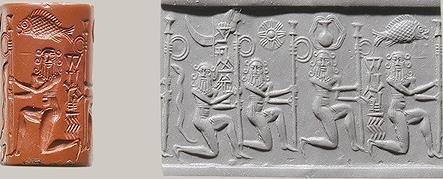

 Reed PLUS ring on Inanna standard on Warka vase.
Reed PLUS ring on Inanna standard on Warka vase.Scarf on the reeds: dhaṭu 'scarf' Rebus: dhatu 'mineral' (Santali) *dhaṭa2 , dhaṭī -- f. ʻ old cloth, loincloth ʼ lex. [Drav., Kan. daṭṭi ʻ waistband ʼ etc., DED 2465]Ku. dhaṛo ʻ piece of cloth ʼ, N. dharo, B. dhaṛā; Or. dhaṛā ʻ rag, loincloth ʼ, dhaṛi ʻ rag ʼ; Mth. dhariā ʻ child's narrow loincloth ʼ.Addenda: *dhaṭa-- 2 . 2. †*dhaṭṭa -- : WPah.kṭg. dhàṭṭu m. ʻ woman's headgear, kerchief ʼ, kc. dhaṭu m. (also dhaṭhu m. ʻ scarf ʼ, J. dhāṭ(h)u m. Him.I 105).(CDIAL 6707)
Hypertexts of goat and tiger atop fire-altars (with ore pellets) mlekh 'goat' rebus: milakkhu, mleccha'copper' kola 'tiger' rebus: kol 'working in iron' kolhe 'smelter'. Products (offerings) carried by worshippers in baskets and large storage jars and dedicated to Divinity Inanna clearly include metal ingots, as signified by the Indus Script hypertexts: copper ingots, iron (smelted) ingots.
One etyma cluster refers to 'iron' exemplified by meD (Ho.). The alternative suggestion for the origin of the gloss med 'copper' in Uralic languages may be explained by the word meḍ (Ho.) of Munda family of Meluhha language stream. It is significant that the word med in Slavic languages signifies copper.
Sa. <i>mE~R~hE~'d</i> `iron'. ! <i>mE~RhE~d</i>(M). Ma. <i>mErhE'd</i> `iron'.Mu. <i>mERE'd</i> `iron'.~ <i>mE~R~E~'d</i> `iron'. ! <i>mENhEd</i>(M).Ho <i>meD</i> `iron'.Bj. <i>merhd</i>(Hunter) `iron'.KW <i>mENhEd</i>@(V168,M080) http://www.ling.hawaii.edu/austroasiatic/AA/Munda/ETYM/Pinnow&Munda
— Slavic glosses for 'copper'
Мед [Med]Bulgarian
Bakar Bosnian
Медзь [medz']Belarusian
Měď Czech
Bakar Croatian
KòperKashubian
Бакар [Bakar]Macedonian
Miedź Polish
Медь [Med']Russian
Meď Slovak
BakerSlovenian
Бакар [Bakar]Serbian
Мідь [mid'] Ukrainian[unquote]
http://www.vanderkrogt.net/elements/element.php?sym=Cu
Miedź, med' (Northern Slavic, Altaic) 'copper'.
One suggestion is that corruptions from the German "Schmied", "Geschmeide" = jewelry. Schmied, a smith (of tin, gold, silver, or other metal)(German) result in med ‘copper’.

गोटी [ gōṭī ] f (Dim. of गोटा) A roundish stone or pebble. गोदा [ gōdā ] m A circular brand or mark made by actual cautery (Marathi)गोटा [ gōṭā ] m A roundish stone or pebble. 2 A marble (of stone, lac, wood &c.) 2 A marble. 3 A large lifting stone. Used in trials of strength among the Athletæ. 4 A stone in temples described at length underउचला 5 fig. A term for a round, fleshy, well-filled body. 6 A lump of silver: as obtained by melting down lace or fringe. गोटुळा or गोटोळा [ gōṭuḷā or gōṭōḷā ] a (गोटा) Spherical or spheroidal, pebble-form. (Marathi)
Rebus: krvṛi f. ‘granary (WPah.); kuṛī, kuṛo house, building’(Ku.)(CDIAL 3232) कोठी [ kōṭhī ] f (कोष्ट S) A granary, garner, storehouse, warehouse, treasury, factory, bank. (Marathi)
कोठी The grain and provisions (as of an army); the commissariatsupplies. Ex. लशकराची कोठी चालली-उतरली- आली-लुटली. कोठ्या [ kōṭhyā ] कोठा [ kōṭhā ] m (कोष्ट S) A large granary, store-room, warehouse, water-reservoir &c. 2 The stomach. 3 The chamber of a gun, of water-pipes &c. 4 A bird's nest. 5 A cattle-shed. 6 The chamber or cell of a hunḍí in which is set down in figures the amount. कोठारें [ kōṭhārēṃ ] n A storehouse gen (Marathi)![]()

Sumerian mudhif facade, with uncut reed fonds and sheep entering, carved into a gypsum trough from Uruk, c. 3200 BCE (British Museum WA 12000). Photo source.
See also: Expedition 40:2 (1998), p. 33, fig. 5b Life on edge of the marshes.
Fig. 5B. Carved gypsum trough from Uruk. Two lambs exit a reed structure identifical to the present-day mudhif on this ceremonial trough from the site of Uruk in northern Iraq. Neither the leaves or plumes have been removed from the reds which are tied together to form the arch. As a result, the crossed-over, feathered reeds create a decorative pattern along the length of the roof, a style more often seen in modern animal shelters built by the Mi'dan. Dating to ca. 3000 BCE, the trough documents the extraordinry length of time, such arched reed buildings have been in use. (The British Museum BCA 120000, acg. 2F2077)
End of the Uruk trough. Length: 96.520 cm Width: 35.560 cm Height: 15.240 cm.
The Uruk trough. From Uruk (Warka), southern Iraq. Late Prehistoric period, about 3300-3000 BC
A cult object in the Temple of Inanna?
This trough was found at Uruk, the largest city so far known in southern Mesopotamia in the late prehistoric period (3300-3000 BC). The carving on the side shows a procession of sheep approaching a reed hut (of a type still found in southern Iraq) and two lambs emerging. The decoration is only visible if the trough is raised above the level at which it could be conveniently used, suggesting that it was probably a cult object, rather than of practical use. It may have been a cult object in the Temple of Inana (Ishtar), the Sumerian goddess of love and fertility; a bundle of reeds (Inanna's symbol) can be seen projecting from the hut and at the edges of the scene. Later documents make it clear that Inanna was the supreme goddess of Uruk. Many finely-modelled representations of animals and humans made of clay and stone have been found in what were once enormous buildings in the centre of Uruk, which were probably temples. Cylinder seals of the period also depict sheep, cattle, processions of people and possibly rituals. Part of the right-hand scene is cast from the original fragment now in the Vorderasiatisches Museum, Berlin
J. Black and A. Green, Gods, demons and symbols of -1 (London, The British Museum Press, 1992)
H.W.F. Saggs, Babylonians (London, The British Museum Press, 1995)
D. Collon, Ancient Near Eastern art (London, The British Museum Press, 1995)
H. Frankfort, The art and architecture of th (London, Pelican, 1970)
P.P. Delougaz, 'Animals emerging from a hut', Journal of Near Eastern Stud-1, 27 (1968), pp. 186-7 http://www.britishmuseum.org/explore/highlights/highlight_objects/me/t/the_uruk_trough.aspx


Cattle gather around a byre, distinguished by its poles with rings. From a cylinder seal of the Late Uruk period. Black and Green, Gods Demons and Symbols of Ancient Mesopotamia. Figure 127 (p. 155)
The following glyphics of m1431 prism tablet show the association between the tiger + person on tree glyphic set and crocile + 3 animal glyphic set.
Mohenjo-daro m1431 four-sided tablet. Row of animals in file (a one-horned bull, an elephant and a rhinoceros from right); a gharial with a fish held in its jaw above the animals; a bird (?) at right. Pict-116: From R.—a person holding a vessel; a woman with a platter (?); a kneeling person with a staff in his hands facing the woman; a goat with its forelegs on a platform under a tree. [Or, two antelopes flanking a tree on a platform, with one antelope looking backwards?]
One side (m1431B) of a four-sided tablet shows a procession of a tiger, an elephant and a rhinoceros (with fishes (or perhaps, crocodile) on top?).
koḍe ‘young bull’ (Telugu) खोंड [ khōṇḍa ] m A young bull, a bullcalf. Rebus: kõdā ‘to turn in a lathe’ (B.)कोंद kōnda ‘engraver, lapidary setting or infixing gems’ (Marathi) कोंडण [kōṇḍaṇa] f A fold or pen. (Marathi) ayakāra ‘ironsmith’ (Pali)[fish = aya (G.); crocodile = kāru (Te.)] baṭṭai quail (N.Santali) Rebus: bhaṭa = an oven, kiln, furnace (Santali)
ayo 'fish' Rebus: ayas 'metal'. kaṇḍa 'arrow' Rebus: khāṇḍa ‘tools, pots and pans, and metal-ware’. ayaskāṇḍa is a compounde word attested in Panini. The compound or glyphs of fish + arrow may denote metalware tools, pots and pans.kola 'tiger' Rebus: kol 'working in iron, alloy of 5 metals - pancaloha'. ibha 'elephant' Rebus ibbo 'merchant'; ib ‘iron'. Alternative: కరటి [ karaṭi ] karaṭi. [Skt.] n. An elephant. ఏనుగు (Telugu) Rebus: kharādī ‘ turner’ (Gujarati) kāṇḍa 'rhimpceros' Rebus:khāṇḍa ‘tools, pots and pans, and metal-ware’. The text on m0489 tablet: loa 'ficus religiosa' Rebus: loh 'copper'. kolmo 'rice plant' Rebus: kolami 'smithy, forge'. dula 'pair' Rebus: dul 'cast metal'. Thus the display of the metalware catalog includes the technological competence to work with minerals, metals and alloys and produce tools, pots and pans. The persons involved are krammara 'turn back' Rebus: kamar 'smiths, artisans'. kola 'tiger' Rebus: kol 'working in iron, working in pancaloha alloys'. పంచలోహము pancha-lōnamu. n. A mixed metal, composed of five ingredients, viz., copper, zinc, tin, lead, and iron (Telugu). Thus, when five svastika hieroglyphs are depicted, the depiction is of satthiya 'svastika' Rebus: satthiya 'zinc' and the totality of 5 alloying metals of copper, zinc, tin, lead and iron.
Glyph: Animals in procession: खांडा [khāṇḍā] A flock (of sheep or goats) (Marathi) கண்டி¹ kaṇṭi Flock, herd (Tamil) Rebus: khāṇḍā ‘tools, pots and pans, and metal-ware’.
Sacred animal of the Babylonian god Adad, god of thunder, but the Achaemenid version adds wings and Frilled with colors. Hadad (Ugaritic: 𐎅𐎄 Haddu), Adad, Haddad (Akkadian) or Iškur (Sumerian) was the storm and rain god in the Northwest Semitic and ancient Mesopotamian religions. He was attested in Ebla as "Hadda" in c. 2500 BCE. From the Levant, Hadad was introduced to Mesopotamia by the Amorites, where he became known as the Akkadian (Assyrian-Babylonian) god Adad.
![OLYMPUS DIGITAL CAMERA]() Storm god Adad. Atop aurochs. Source of picture: http://www.mesopotamiangods.com/category/ur/page/3/
Storm god Adad. Atop aurochs. Source of picture: http://www.mesopotamiangods.com/category/ur/page/3/
![2j - Teshub in a chariot pulled by Taurus]()
![6-twin-temples-to-anu-and-adad-in-uruk]() (Adad; Adad’s & grandfather King Anu’stwin houses in Uruk)
(Adad; Adad’s & grandfather King Anu’stwin houses in Uruk)
![Image result for storm god adad aleppo]()
![Tablet from Syria. Two bulls facing each other, a large deity, followed by a smaller, winged deity, is adored by an orant. Late Bronze. Terracotta, 7,9 x 7,1 cm AO 28362]()
![2f-hadad-warrior-upon-a-bull-taurus]()
![]() http://www.mesopotamiangods.com/wp-content/uploads/2014/08/2e-Adad-war-god-upon-Taurus-the-bull-1.jpg
http://www.mesopotamiangods.com/wp-content/uploads/2014/08/2e-Adad-war-god-upon-Taurus-the-bull-1.jpg
http://www.mesopotamiangods.com/sin-iddinam-and-ishkur-sin-iddinam-e-translation/
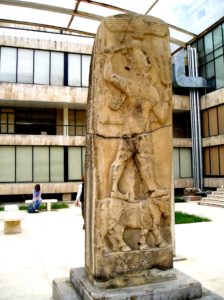 Storm god Adad. Atop aurochs. Source of picture: http://www.mesopotamiangods.com/category/ur/page/3/
Storm god Adad. Atop aurochs. Source of picture: http://www.mesopotamiangods.com/category/ur/page/3/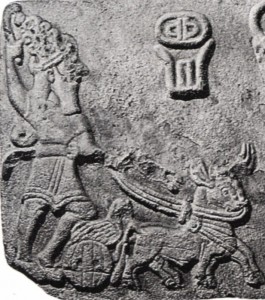
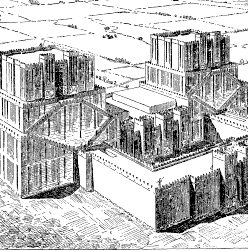 (Adad; Adad’s & grandfather King Anu’stwin houses in Uruk)
(Adad; Adad’s & grandfather King Anu’stwin houses in Uruk)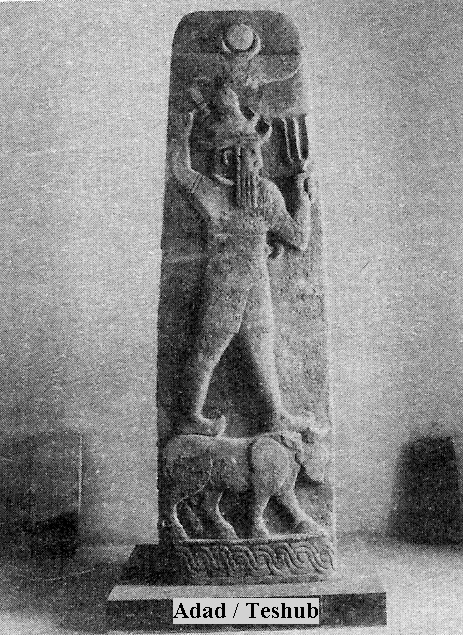
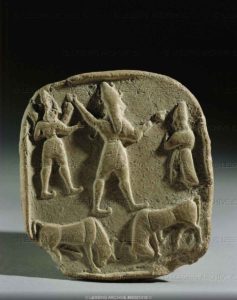
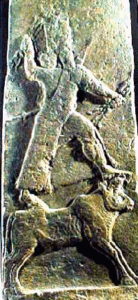
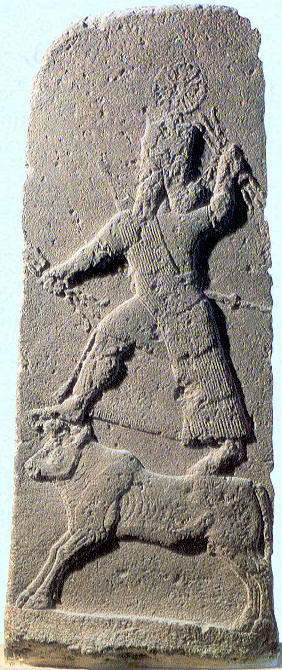 http://www.mesopotamiangods.com/wp-content/uploads/2014/08/2e-Adad-war-god-upon-Taurus-the-bull-1.jpg
http://www.mesopotamiangods.com/wp-content/uploads/2014/08/2e-Adad-war-god-upon-Taurus-the-bull-1.jpghttp://www.mesopotamiangods.com/sin-iddinam-and-ishkur-sin-iddinam-e-translation/
 tammuz: One of two Babylonian lions at the Oriental Institute Museum in Chicago, dating back to 575 BCE. In the equivalent of Babylon’s Time Square, 120 life-size lions symbolizing the goddess Ishtar lined the walls of the Processional Street, where the entire city celebrated the New Year: the Resurrection of Tammuz, the Babylonian god of harvest. The Oriental Institute Museum at the University of Chicago, Chicago, IL
tammuz: One of two Babylonian lions at the Oriental Institute Museum in Chicago, dating back to 575 BCE. In the equivalent of Babylon’s Time Square, 120 life-size lions symbolizing the goddess Ishtar lined the walls of the Processional Street, where the entire city celebrated the New Year: the Resurrection of Tammuz, the Babylonian god of harvest. The Oriental Institute Museum at the University of Chicago, Chicago, IL Aurochs from Ishtar Gate at Babylon, constructed in about 575 BCE by order of King Nebuchadnezzar II. On display in Istanbul Archaeology Museum in Istanbul, Turkey.
Aurochs from Ishtar Gate at Babylon, constructed in about 575 BCE by order of King Nebuchadnezzar II. On display in Istanbul Archaeology Museum in Istanbul, Turkey.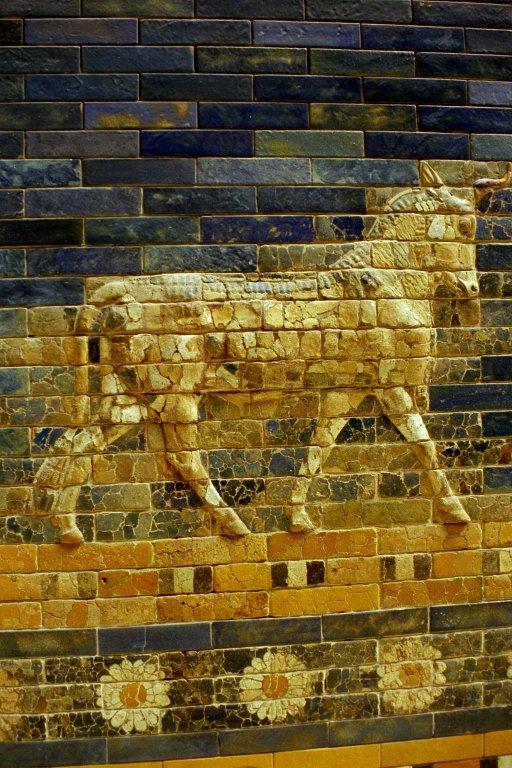
An aurochs above a flower ribbon; missing tiles are replaced

Close-up of an aurochs from the Ishtar Gate

Model of the main procession street (Aj-ibur-shapu) towards Ishtar Gate
 The cuneiform inscription of the Ishtar Gate in the Pergamon Museum in Berlin
The cuneiform inscription of the Ishtar Gate in the Pergamon Museum in Berlin
“Ishtar Gate,” Iraq from Matson Collection, 1932 https://www.pinterest.com/pin/813884963878965033/

Head of a statue of ishtar, with a headdress, from the temple of ushtar at mari syrian 2800-2300 BCE

A Sumerian sculpture housed in the British Museum. The statue is that of a ram with glorious curved horns. The Sumerians used the ram as a symbol of their culture.https://www.pinterest.com/pin/417990409136379101/
Proto-Elamite tablet with seal mark.
- Grande tablette de comptabilité avec empreinte représentant les figures mythologiques du lion et du taureau, en attitude humaine et se domptant alternativementTell de l'Acropole
- ArgileH. 21 cm; L. 26 cm; H. of seal mark: 4.2 cm
- Fouilles J. de Morgan, 1901 , 1901Sb 2801
- [quote]The invention of writing corresponded to the economical needs of a society at a time when the development of cities was giving rise to increasing number of exchanges and transactions. This form of writing was inscribed on a soft material, clay. The first tablets date from the Late Uruk period, in Mesopotamia, and the Proto-Elamite period in Iran. They often bear the mark of one or two cylinder seals, proof that an administrative check or an agreement between two parties had taken place.
A large tablet
This tablet is the largest from the Proto-Elamite period, corresponding to the earliest urban development in the late 4th millennium BC, in the Fars region (southwestern Iran), the present regional capital of which is Shiraz. It bears traces of three different types of administrative tools: writing, accounting and glyptics, a major art form of the period, corresponding to the use of seals. There are inscriptions of both writing and numeral signs on both sides of the tablet.The emergence of a new writing system in the Fars region
Writing emerged in Iran nearly three centuries after being invented in southern Mesopotamia. This writing system, developed in the Fars region and called Proto-Elamite for this reason, is totally independent from the writing in use at Uruk. As no bilingual text exists that would enable us to establish an equivalence between the two systems, Proto-Elamite writing remains undecipherable. However, the reading direction (right to left) and its horizontality have been detected.An accounting document sealed with images of animals in human poses
These Proto-Elamite tablets are accounting documents. Three different numerical systems are used on the tablet: a decimal system, a sexagesimal system and a mixed system known as SE. The various operations are listed on the front side of the tablet, recapitulated, with totals, on the back at the top. New figures appear: crescent-shaped notches and dots circled with a constellation of tiny points, some of which represent fractions. A pictographical sign resembling a fringed triangle, known as the "hairy triangle," often appears, but its meaning remains unclear. A single seal was used on the document, a cylinder-seal that was rolled twice across the width of the tablet, covering most of the back of the tablet. The scene shows a bull symmetrically restraining two seated felines, alternating with a lion dominating two rearing bulls, each topped with a "hairy triangle." The animals stand on their hindlegs as if they were bipeds, a technique characteristic of the Proto-Elamite period in which animals were often depicted in a human pose. The choice of bulls and lions was deliberate, for these animals appear to personify cosmic forces, decisive in the balance of power in the world. In the scene, there is no durable winner or loser, but alternating, opposing forces that appear equal.Bibliography
Amiet Pierre, Élam, Auvers-sur-Oise, Archée, 1966, p. 101, n 56.
Amiet Pierre, La Glyptique mésopotamienne archaïque, Paris, Éditions du Centre national de la recherche scientifique, 1980, pp. 107-110 et pl. 38, n 585.
Stolper Matthew W., The Royal City of Susa. Ancient Near Eastern Treasures in the Louvre, Exposition, New York, Metropolitan Museum of Art, 1992, n 49. - [unquote]

Couple de musiciens Vers 2500 - 2400 avant J.-C. Mari, temple d'Ishtar Albâtre | Site officiel du musée du Louvre https://www.pinterest.com/pin/354799276865378416/

KNEELING FIGURE BOUND WITH SERPENTS, Fish pair Circa 2600 BC-Circa 2400 BC Early Dynastic/Sumerian Tell es-Sukhairi/Iraq https://www.pinterest.com/pin/508343876661177488/
- "Music" stele
- Second dynasty of Lagash, reign of Gudea, c. 2120 BCTello (ancient Girsu)
- LimestoneH. 1.20 m; W. 0.63 m; D. 0.25 m
- E. de Sarzec excavations, 1881 , 1881AO 52
[quote]The stele of music shows the foundation rites - performed to the sound of the lyre - of the temple built by Prince Gudea (c. 2100 BC) at his capital of Telloh (ancient Girsu), for Ningirsu, god of the state of Lagash in the Land of Sumer. The stele thus accords with the tradition of Neo-Sumerian art, which unlike that of the preceding period that focused on the warlike exploits of the rulers of Akkad, tends to show the king engaged in pious activities.
The building of Ningirsu's temple
In the Neo-Sumerian Period (c. 2100 BC), the rulers Gudea and Ur-Nammu had themselves depicted taking part in the foundation rites of temples, notably on steles, as statues, and as figurines. On the stele of music, Gudea, carrying a peg and cord and followed by figures probably representing his princely heir and two priests, prepares to lay out the plan of Ningirsu's sanctuary. The ceremony is punctuated by music, which accompanies the chanting or singing of liturgical poems. Behind the cantor, a musician plays on a lyre whose sound box is decorated with a bull. The deep tones of the instrument evoked the bellowing of a bull, and by poetic identification, within the temple of Ningirsu "the room of the lyre was a noisily breathing bull." The making of the god's lyre gave its name to the third year of Gudea's reign, called "the year in which was made the lyre [called] Ushumgalkalamma [the dragon of the land of Sumer]."
Music in temple foundation ceremonies
The spirit embodied by the lyre played a part in the events leading to the building of the temple, for it appears in the dream in which the god reveals to Gudea the task he is to accomplish (Gudea Cylinders, Louvre, MNB 1512 and MNB 1511): "When, together with Ushumgalkalamma, his well-beloved lyre, that renowned instrument, his counselor, you bring him gifts [...] the heart of Ningirsu will be appeased, he will reveal the plans of his temple."
When the work was complete, Ushumgalkalamma went before Gudea, leading all the musical instruments, to mark the arrival of the god in his new abode. Ushumgalkalamma is the god's counselor because its song calms the emotions that disturb the spirit, allowing the return of the reason indispensable to good judgement. Among the divine servants of Ningirsu, it is the lyre's duty to charm his master, a god of changeable mood. It is assisted by the spirit of another lyre that brings consolation in times of darkness: "So that the sweet-toned tigi-drum should play, so that the instruments algar and miritum should resound for Ningirsu, [...] his beloved musician Ushumgalkalamma accomplished his duties to the lord Ningirsu. To soothe the heart and calm the liver [the seat of thought], to dry the tears of weeping eyes, to banish grief from the grieving heart, to cast away the sadness in the heart of the god that rises like the waves of the sea, spreads wide like the Euphrates, and drowns like the flood of the storm, his lyre Lugaligihush accomplished his duties to his lord Ningirsu."
When the work was complete, Ushumgalkalamma went before Gudea, leading all the musical instruments, to mark the arrival of the god in his new abode. Ushumgalkalamma is the god's counselor because its song calms the emotions that disturb the spirit, allowing the return of the reason indispensable to good judgement. Among the divine servants of Ningirsu, it is the lyre's duty to charm his master, a god of changeable mood. It is assisted by the spirit of another lyre that brings consolation in times of darkness: "So that the sweet-toned tigi-drum should play, so that the instruments algar and miritum should resound for Ningirsu, [...] his beloved musician Ushumgalkalamma accomplished his duties to the lord Ningirsu. To soothe the heart and calm the liver [the seat of thought], to dry the tears of weeping eyes, to banish grief from the grieving heart, to cast away the sadness in the heart of the god that rises like the waves of the sea, spreads wide like the Euphrates, and drowns like the flood of the storm, his lyre Lugaligihush accomplished his duties to his lord Ningirsu."
Representations of musicians in Mesopotamia
Representations of musicians are not uncommon in Near-Eastern iconography. They are found from the early 3rd millennium BC in the banquet scenes that appear on perforated plaques and cylinder seals. Early in the next millennium, they would appear on molded terracotta plaques, such as the example with the harpist in the Louvre (AO 12454). Very few examples of musical instruments have survived until today (among them the lyres from the royal tombs of Ur, c. 2550 BC); these representations are therefore particularly valuable.
Bibliography
André-Salvini Béatrice, "Stèle de la musique", in Musiques au Louvre, Paris, Éditions de la Réunion des musées nationaux, 1994, pp. 10-11.Parrot André, Tello, vingt campagnes de fouilles, 1877-1933, Paris, Albin Michel, 1948, pp. 174-176, pl. 20a.
Rutten Marguerite-Maggie, "Scènes de musique et de danse", in Revue des arts asiatiques, Paris, École française d'Extrême-Orient, 1935, p. 220, fig. 8.
Sarzec Édouard de, Découvertes en Chaldée, Paris, Leroux, 1884-1912, pp. 36 et 219-221, pl. 23.
Sillamy Jean-Claude, La Musique dans l'ancien Orient ou la théorie musicale suméro-babylonienne, Villeneuve d'Ascq, Presses universitaires du Septentrion, 1998, p. 160.
[unquote]
- Eye idol
- Idole aux yeuxChalcolithique (vers 3500 avant J.-C.)Syrie du Nord
- Terre cuiteH. 25 cm
- Don des Amis du Louvre 1991 , 1991 AO 30002
- [quote]With its bell-shaped body and cylindrical neck topped with two perforated circles, this strange object was long known as the "eye idol" or "idol with spectacles." Such idols date from the Late Uruk period (3300-3000 BC) and are found mainly in northern Mesopotamia and Syria. They were first thought to be votive objects, but may have been used in spinning.
An eye idol?
This relatively large pottery object has a bell-shaped body and a cylindrical neck topped by two perforated circles. Its flat base shows that it was meant to be freestanding. The beige clay is covered with a thick orange-red slip, which is still shiny under the concretions. Max Mallowan coined the conventional name of "eye idols" in 1937-38 during excavations at Tell Brak in Syria, where hundreds of small anthropomorphic plaques with huge eyes were found in a richly decorated building. The archaeologist extended the name to other objects, this time called "idols with spectacles" because they were surmounted by two circles that were disproportionately large compared with the total size of the object. They were regarded as prototypes of the first objects found. The building in which they were found was called the "Temple of the Eyes" because of its rich decor of cone mosaics and gold plating, as well as for the eye idols that were unearthed there. However, the building was altered several times and remains stratigraphically unreliable. There is nothing to prove that it had a religious function.A multitude of eye idols
Eye idols are scattered over a vast region bounded by southeast Turkey (Arslantepe) to the north, Syria (Hama) to the west, and southern Mesopotamia (Telloh, Uruk, Ur) and Iranian Khuzistan (Susa) to the south. These objects are characteristic of the Proto-urban period in Uruk (3700-3100 BC) during which the first cities appeared. The many different contexts in which they were discovered (domestic, ritual, funerary, dumps) cast doubt on the strictly religious function of these objects, which vary greatly in shape, material, and style.
In 1996, Catherine Bréniquet suggested dividing the idols into three types. Type 1, from Tell Brak, known as "eye idols," covers all the small engraved alabaster plaques evoking the upper part of a human body with the face reduced to the eyes and sometimes adorned with jewelry and headdresses. Type 2, the "large idols with spectacles," covers quite large bell- or trumpet-shaped pottery objects with a neck supporting two perforated circles. Some have been carefully shaped, smoothed and glazed, while others are quite summarily made. Our idol belongs to this type of "large idols with spectacles," present in northern Mesopotamia and Syria. Type 3, which groups "small idols with spectacles" shows strong similarities with Type 2, but these objects are much smaller and are all made of stone.Various interpretations
Max Mallowan interpreted all these objects as belonging to one and the same series, evolving in shape over time. The group would have made a set of votive objects dedicated to an "eye god" venerated in the "temple" of Tell Brak. Other scholars have thought Types 2 and 3 to be lids (H. Frankfort), a set of standard weights or weights for a loom, or even firedogs to be set around a hearth. Catherine Bréniquet believes that Type 1 models - the only ones that really deserve to be called "eye idols" - should be distinguished from Types 2 and 3. The latter could well be instruments used in spinning, placed in front of the seated operator. The holes were used to separate two or three single threads, which were then twisted together. On cylinder seals from the Uruk period, such objects seem to be shown in association with spinners at work.Bibliography
Les Antiquités orientales : guide du visiteur, Paris, Éditions de la Réunion des musées nationaux, 1993, p. 188.
Bréniquet Catherine, "Du Fil à retordre : réflexions sur les idoles aux yeux et les fileuses de l'époque d'Uruk", in Collectanea Orientalia, 1996.
Caubet Annie, "L'Idole aux yeux du IVe millénaire", in La Revue du Louvre, février 1991, Paris, Éditions de la Réunion des musées nationaux, 1991, pp. 6-9. - Seated godMiddle Bronze Age, c. 1600 BCTell el-Mishrife (ancient Qatna), Syria?
- Bronze
- Acquired in 1902 , 1902AO 3992
- [quote]Bronze figurines are found in most Bronze Age urban sites in the Near East, especially those on the Levant coast. This statuette, one of the finest examples of seated gods from this period, was purchased in the Homs region of Syria. It probably came from the city of Katna, which maintained a flourishing trade with the coast.
A statuette of a seated god
Decorated with four rows of horns, the headdress of this statuette indicates that it depicted a high-ranking god in the pantheon. The conical headdress is similar to that worn by the basalt god brought back from Jabbul, southeast of Aleppo, and now in the Louvre (ao10831). The god had inlaid eyes in another material, and his beard is indicated by a sinuous chiseled plane cutting across the temples, cheeks, and chin. He is wearing a long tunic or coat trimmed with heavy braid, ending in a fringed border lying on his knees. In the Bronze Age, this type of garment was often found on bronze statuettes in the Levant, particularly those from Ugarit (Louvre, ao19397). It can also be seen on Syrian cylinder seals made in the Middle Bronze Age (18th-17th century BC). The feet are carefully chiseled and fitted with two studs, which - with the four round feet of the backless seat - would have been used to fit the statuette into a wooden or stone base, or into miniature stone altars. At Byblos, Lebanon, where many figurines have been unearthed in temple deposits, stone bases were found in the courtyard of the Temple of the Obelisks. The god must have been holding something in his right hand, while his left is laid on the braid of his garment.Bronze figurines of gods
Bronze statuettes are found in most Bronze Age urban sites in the Near East. They are mainly found on the coast of the Levant, but some have been found further inland. They appear towards the end of the third millennium BC and mostly date from the second half of the 2nd millennium BC. These figurines were placed in temples and no doubt dedicated to the gods. Some were completely or partly covered with a thin leaf of gold or silver inserted in grooves made on the figure.
Although the details vary widely, the statues can be divided into types. Most are shown wearing a high Egyptian crown or a horned tiara, in a dynamic walking pose, sometimes with an arm lifted to brandish a weapon (statuette of the god Baal from Ugarit, Louvre, ao11598). Several of the Byblos statues are standing on an animal, probably a bull. Armed female figures are extremely rare. They are usually standing or sitting, some holding a child in their arms, others with their arms by their sides or under their breasts. Some statuettes depict gods or goddesses draped in long robes, standing or sitting on a seat with a footrest, with one hand stretched out in a gesture interpreted as a blessing (Ugarit statues, Louvre, ao19397 and ao19407; Byblos statuette, Beirut, Antiquities Department).The Katna site
This statuette may come from Katna (present-day Al-Mashrafah), a very important site that carried on a flourishing trade with the sea coast via the Homs Gap, which linked the sea to the interior. This city in the region of the Orontes, was excavated in 1926 by Robert du Mesnit du Buisson. New research is currently being undertaken on the site.Bibliography
Amiet Pierre (sous la dir. de), Au Pays de Baal et d'Astarté : 10 000 ans d'art en Syrie, Exposition, Paris, musée du Petit Palais, 26 octobre 1983-8 janvier 1984, Paris, Éditions du musée du Petit Palais, 1983, p. 131, n 165.
Dussaud René, "L'Art syrien du deuxième millénaire avant notre ère", in Syria, t. VII, 1926, p. 339.
Negbi Ora, Canaanite Gods in Metal. An Archeological Study of Ancient Syro-Palestinian Figurines, Tel Aviv, Tel Aviv university, Institute of archaeology, 1976, pp. 46-59, pl. 35.
Pharaonen und Fremde. Dynastien im Dunkel, Exposition, Vienne, Musées de la ville de Vienne, 8 septembre-23 octobre 1994, Vienne, Wienkultur, 1994, cat. n 60.
Spycket Agnès, La Statuaire du Proche-Orient ancien, Leyde-Köln, E. J. Brill, Handbuch der Orientalistik, Kunst und Archäelogie, Band 1, 1981, p. 285, n 272, pl. 182.
Seeden Helga, "Peace Figurines from the Levant", in Archéologie au Levant. Recueil à la mémoire de Roger Saidah, Lyon, Maison de l'Orient, Collection de la Maison de l'Orient méditerranéen ancien, coll. "Série archéologique", n 12, 1982, pp. 107-121. - [unquote]
Gold band with sphinxes and stylized tree
Department of Near Eastern Antiquities: Levant
- Pectoral decorated with a sphinx and a stylised treeLate Bronze Age II (1400-1230 BC)Tomb 2, Enkomi
- Repoussé gold leaf
- C. Schaeffer excavations, 1949 , 1949AM 2164
- [quote]In Late Bronze Age Cyprus (1600-1050 BC), the dead were often adorned with jewelry of fine sheet gold with repoussé decoration sewn onto cloth through small holes in the gold and then placed on the hair, the face, or the chest. This broad gold band is decorated with a pair of winged sphinxes facing a stylized tree, showing both Aegean and Levantine influences.
An "international" art
This thin sheet of beaten gold has repoussé decoration. Within a central rectangular panel are two winged sphinxes with elongated bodies, angular wings, and tails curled upwards; in their hair, they wear aigrettes like those depicted in paintings from Crete or Thera. The sphinxes are symmetrically arranged on either side of a stylized tree composed of a fleuron and a palmette with curling fronds. The whole is surrounded by a border of raised dots, within which, on the long sides, are circles of the same. The symmetrical winged sphinxes on either side of an ornamental plant element are a motif of Near Eastern inspiration, also found in Mycenaean Greece and through the 1st millennium. This type of composition is often found in the decorative arts of the Levant, on ivories, cylinder seals, and goldwork. The Louvre has a ring from Enkomi with a winged sphinx, for example. The stylized sapling or tree found in the middle of these symmetrical compositions certainly has a symbolic significance, and is sometimes called a "sacred tree" or "tree of life."Funerary jewelry
The gold is pierced at the middle of the short sides. From the same tomb at Enkomi comes another, elliptical band with decoration from the same die, which must have been of wood. These two pectorals, found at chest level on the remains in Tomb 2, particularly well-provided with funerary equipment, were probably sewn to pieces of fabric through the holes. Bands of this kind found in the Enkomi tombs adorned the forehead, hair, or chest of the deceased. The rosettes and spiral motifs of the decoration are part of the Near Eastern repertoire adopted in the Mediterranean.Enkomi, a prosperous port
In the late 2nd millennium, Enkomi was a prosperous port that owed its wealth to the development of the copper mines and the growth of maritime trade. Founded in the 2nd millennium, this city, with its dense urban fabric, was surrounded by stone ramparts. Family tombs were dug beneath the houses, as in the Levant. Their plentiful funerary equipment, consisting of cosmetics jars in ivory, faience, or Egyptian alabaster, jewelry, and imported Mycenaean and Levantine pottery, testifies to Cyprus's involvement with the international art of the Late Bronze Age.Bibliography
Caubet Annie, Karageorghis Vasos, Yon Marguerite (sous la dir. de),
Les Antiquités de Chypre : âge du bronze, musée du Louvre, département des Antiquités orientales, Paris, Éditions de la Réunion des musées nationaux, 1981, coll. "Notes et documents des musées de France, 2", p. 53, CKY89.
Caubet Annie, Hermary Antoine, Karageorghis Vasos (sous la dir. de),
Art antique de Chypre au musée du Louvre : du chalcolithique à l'époque romaine, Paris, Éditions de la Réunion des musées nationaux, 1992, Athènes, Kapon, 1992, p. 64, n 60.
L'Acrobate au taureau, les découvertes de Tell el-Dab´a, Égypte et l'archéologie de la Méditerranée orientale : 1800-1400 av. J.-C.,
Actes du colloque organisé au musée du Louvre par le Service culturel
le 3 décembre 1994 sous la direction d'Annie Caubet, Paris,
La Documentation française, musée du Louvre, 1999, (Conférences et colloques), p. 25, fig. 14.
Schaeffer Claude, Enkomi-Alasia : nouvelles missions en Chypre,
1946-1950, avec une note préliminaire de René Dussaud et des contributions de H. J. Plenderleith et O. Masson, Paris, Klincksieck,1952, Publications de la mission archéologique française et de la mission du gouvernement de Chypre à Enkomi, t. I, pp. 127-128.
Schaeffer Claude, "La coupe en argent incrustée d'or d'Enkomi-Alasia", Syria, n 30, Paris, Geuthner, 1953, pp. 51-64. - [unquote]

Cylinder seal and imprint from Mari, Archaic Dynasties. Top register: agricultural scene, milking cows, goats. Bottom register: Human-headed bull between two heroes with maces;eagle with lion-head. H: 4,3 cm AO 10920 Louvre, Departement des Antiquites Orientales, Paris, France
https://www.pinterest.com/pin/496662665130957573/

AN ELAMITE GREEN STONE CYLINDER SEAL CIRCA 3000 B.C.E With the figure of a striding bull, head raised, with large curling horns and dotted eyes, a stylized flowering tree in front, two conjoined scrolling lines in the field 1 in. (2.5 cm.) high https://www.pinterest.com/pin/191966002839912556/

AN ELAMITE CHALCEDONY CYLINDER SEAL CIRCA 3000-2800 B.C.E With recumbent bull and ibex one behind the other, stylized branch and bird in the field, an eagle with outstretched wings above with a U-shaped design between, with remains of bronze pin 1¼ in. (3.2 cm.) high https://www.pinterest.com/pin/137641332334231619/

Proto Elamite, Jedmet Nasr, 3100BC-3000BC. Streaked pale yellow-brown steatite or calcite cylinder seal with blue-grey patches; two goats; in field - 'Maltese' cross, circled dots.
https://www.pinterest.com/pin/360288038911890117/

2700 BCE Early Dynastic. Abu Habba, Sippar Iraq. Aragonite cylinder seal; contest scene; in the centre - a bearded nude male with 6 roundels around his head termed a "crested head-dress", holds a bull in each hand. https://www.pinterest.com/pin/229402174741114484/
 lira de Ur
lira de Ur https://www.pinterest.com/pin/587367976373653903/
Miller named Idi Narum Top of statue, front and back views. Tell Hariri (Mari)
Statue d'Idi-Narum et statue du couple enlacé (Mari, Syrie)
2010
Description : Plaque de verre (13x18) Statue d'Idi-Narum : n° 176, temple d'Ishtar ; biblio : - Syria XVI (1935) p. 27, pl. IX - PARROT, A., Le temple d'Ishtar, BAHB LXV, Paris, Geuthner, 1956, pp. 71-74, pl. XXXIX statue du couple enlacé : n° 147, temple d'Ishtar ; biblio : - Syria XVI (1935) pp. 118-120, pl. XX - PARROT, A., Le temple d'Ishtar, BAHB LXV, Paris, Geuthner, 1956, pp. 102-104, pl. XIII https://medihal.archives-ouvertes.fr/medihal-00486683

Iku-shamagan, King of Mari. Detail of 08-02-08/8. Steatit statuette (2650 BCE) Early dynastic period II, from the temple of Ishtar at Mari, Syria National Museum Damasco,Syria https://www.pinterest.com/pin/354799276864230608/
Damage Reported at Mari in Syria
The French archaeologist André Parrot (1901-1980) carried out several excavations at Mari between 1933 and 1960. Having read about recent damage to the ancient buildings of Mari, I wanted to share a couple of photos of artifacts from the site.
The first statue is of the Iku-Shamagan, King of Mari. It dates to about 2650 B.C. and is from the temple of Ishtar in Mari. The statue is about 47 inches high and was displayed in the Damascus Museum in 2002 when I made this photograph.
The small (about 20 inches high) statue of Ebih-II, the superintendent of Mari, was discovered in the temple of Ishtar. It dates to the period of about 2900-2750 B.C. and is made of gypsum, with eyes of shells and lapis lazuil. This artifact, along with several others, is displayed in the Louvre.
Statue of King of Mari, Lamgi-Mari with dedication to Ishtar
Statue. Head. Ebih-Il dedicated to Ishtar
Mari is located far east in Syria near the Euphrates River. The city was located on the main route between Assyria and Babylon. If Abraham first lived in south Mesopotamia then he might have passed this way on the trip to Haran (Genesis 11:27 – 12:5).
Project Syrian Archaeology has some photos of poor quality showing damage to historical sites at their Facebook page here. https://ferrelljenkins.wordpress.com/2013/11/20/damage-reported-at-mari-in-syria/

MARI SCULPTURE 3RD-2ND MILL.BCE Man carrying a sacrificial lamb (upper part of body) Steatite statuette Akkade dynasty (2460-2290 BCE) from the Anonymous Temple, Mari, Syria Height 23 cm National Museum, Aleppo, Syria

Ebih-Il DA, 2400 BC Mari, temple d'Ishtar Gypse, lapis, coquille 52,5 x 20,6 x 30 cm Musée du Louvre
https://www.pinterest.com/pin/430867889341711524/

Statue of Ebih-Il, superintendent of Mari Material: Gypsum, schist, shells, lapis lazuli. c. 2400 BCE. https://www.pinterest.com/pin/483151866254829570/
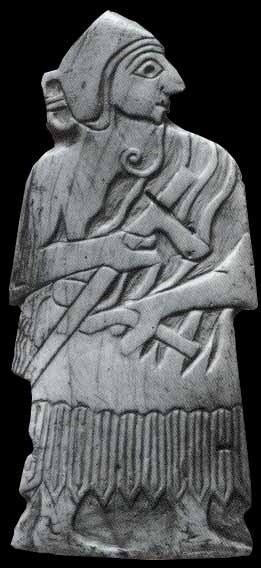 Soldier at Mari carrying weapons and implements.
Soldier at Mari carrying weapons and implements.
"The Standard of Ur" is a Sumerian artifact excavated from the Royal Cemetery in the ancient city of Ur (modern-day Iraq south of Baghdad). It is approximately 4,500 years old. It was found next to the skeleton of a ritually sacrificed man who may have been its bearer. It is now on display, in reconstructed form, in the British Museum in London. https://www.pinterest.com/pin/134334001357537512/


Standard of Ur- Both sides- Sumerian https://www.pinterest.com/pin/506162445595181627/

The Royal lyre: Several lyres were found in the Royal Tombs of Ur, along with the bodies of the women who played them. Woolley reports that one woman lay with her arm draped across her lyre, with the bones of her hand where the strings had been, as if playing it.
 This lyre was found in the 'Great Death-Pit', one of the graves in the Royal Cemetery at Ur. From Ur, southern Mesopotamia, Iraq. Early dynastic period, 2600-2400 BCE. (The British Museum, London)
This lyre was found in the 'Great Death-Pit', one of the graves in the Royal Cemetery at Ur. From Ur, southern Mesopotamia, Iraq. Early dynastic period, 2600-2400 BCE. (The British Museum, London) 
Harpist. Sumer. https://www.pinterest.com/pin/618541330043959965/


Bull's head of the famous Gold lyre of Ur found in the royal cemetery of Ur, early dynastic 2600- 2400 BCE, Mesopotamia. Iraq https://www.pinterest.com/pin/57350595230486210/
 "Woman With Folded Hands" Mesopotamian, Sumerian, Early Dynastic c. 2650-2250 BCE woman wearing what both men and women wore, the Kaunakes garment in the form of a wrapped skirt. Her hair seems to be pulled into a Chignon held in place with a Fillet, and the date could possibly assume that she is wearing her hair confined in a net also.
"Woman With Folded Hands" Mesopotamian, Sumerian, Early Dynastic c. 2650-2250 BCE woman wearing what both men and women wore, the Kaunakes garment in the form of a wrapped skirt. Her hair seems to be pulled into a Chignon held in place with a Fillet, and the date could possibly assume that she is wearing her hair confined in a net also.  Found in Dayala khafaji about 2600 B.C.E
Found in Dayala khafaji about 2600 B.C.E
SUMERIAN ART: Statues from the Abu Temple c. 2700 - 2500 B.C.E Stone sculptures of deities. Tallest is 30" high. Colored inlayed eyes. Bodies and faces simplified in order to avoid distracting attention from eyes. Arms and legs have roundness of pipes. Frontal, rigid and symmetrical like Egyptian art. LOCATION: IRAQ MUSEUM, BAGHDAD & THE ORIENTAL INSTITUTE, THE UNIVERSITY OF CHICAGO
 Head of a woman wearing a polos, found in the Temple of Ishtar at Mari https://www.pinterest.com/pin/294352525618311086/?lp=true
Head of a woman wearing a polos, found in the Temple of Ishtar at Mari https://www.pinterest.com/pin/294352525618311086/?lp=true A schematic representation of some key Arabian Sea-Savannah zone biotic transfers of prehistory (the “Bronze Age horizon”). The question of how precisely African crops reached India beginning around 2000 BCE has now attracted the attention of archaeologists and botanists for decades...First, there was an earlier circum-Arabia or Arabian Sea phase of the Middle Bronze Age (from 2000 BCE), in which domesticates were transferred between the northern African savannahs and the savannah zones of India (Figure 1). Then there was a later mid-Indian Ocean phase that may be regarded as generally Iron Age (late centuries BCE to early centuries CE), which began to draw South India, South-east Asia and East Africa into the wider remit of trade/contact, setting the stage for a genuinely Indian Ocean world. In addition, we would like to draw attention to the significance of transfers of commensal animals and weeds, a largely unstudied but potentially revealing body of evidence for early human contacts across the Arabian Sea and the Indian Ocean."”We will suggest that there are two broad phases and sets of processes in intercontinental transfers. First, there was an earlier circum-Arabia or Arabian Sea phase of the Middle Bronze Age (from 2000 BCE), in which domesticates were transferred between the northern African savannahs and the savannah zones of India (Figure 1). Then there was a later mid-Indian Ocean phase that may be regarded as generally Iron Age (late centuries BCE to early centuries CE), which began to draw South India, South-east Asia and East Africa into the wider remit of trade/contact, setting the stage for a genuinely Indian Ocean world.” "About twenty years ago Cleuziou and Tosi (1989: 15) referred to the prehistoric Arabian peninsula as a “conveyor belt between the two continents, channelling an early dispersal of domestic plants and animals.”
A schematic representation of some key Arabian Sea-Savannah zone biotic transfers of prehistory (the “Bronze Age horizon”). The question of how precisely African crops reached India beginning around 2000 BCE has now attracted the attention of archaeologists and botanists for decades...First, there was an earlier circum-Arabia or Arabian Sea phase of the Middle Bronze Age (from 2000 BCE), in which domesticates were transferred between the northern African savannahs and the savannah zones of India (Figure 1). Then there was a later mid-Indian Ocean phase that may be regarded as generally Iron Age (late centuries BCE to early centuries CE), which began to draw South India, South-east Asia and East Africa into the wider remit of trade/contact, setting the stage for a genuinely Indian Ocean world. In addition, we would like to draw attention to the significance of transfers of commensal animals and weeds, a largely unstudied but potentially revealing body of evidence for early human contacts across the Arabian Sea and the Indian Ocean."”We will suggest that there are two broad phases and sets of processes in intercontinental transfers. First, there was an earlier circum-Arabia or Arabian Sea phase of the Middle Bronze Age (from 2000 BCE), in which domesticates were transferred between the northern African savannahs and the savannah zones of India (Figure 1). Then there was a later mid-Indian Ocean phase that may be regarded as generally Iron Age (late centuries BCE to early centuries CE), which began to draw South India, South-east Asia and East Africa into the wider remit of trade/contact, setting the stage for a genuinely Indian Ocean world.” "About twenty years ago Cleuziou and Tosi (1989: 15) referred to the prehistoric Arabian peninsula as a “conveyor belt between the two continents, channelling an early dispersal of domestic plants and animals.”(Dorian Q. Fuller et Nicole Boivin, 2009, Crops, cattle and commensals across the Indian Ocean http://oceanindien.revues.org/
https://www.academia.edu/471320/Zebu_Cattle_Are_An_Exclusive_Legacy_of_the_South_Asia_Neolithic
Abstract. "Animal domestication was a major step forward in human prehistory, contributing to the emergence of more complex societies. At the time of the Neolithic transition, zebu cattle (Bos indicus) were probably the most abundant and important domestic livestock species in Southern Asia. Although archaeological evidence points toward the domestication of zebucattle within the Indian subcontinent, the exact geographic origins and phylogenetic history of zebu cattle remains uncertain. Here, we report evidence from 844 zebu mitochondrial DNA (mtDNA) sequences surveyed from 19 Asiatic countries comprising 8 regional groups, which identify 2 distinct mitochondrial haplogroups, termed I1 and I2. The marked increase in nucleotide diversity (P,0.001) for both the I1 and I2 haplogroups within the northern part of the Indian subcontinent is consistent with an origin for all domestic zebu in this area. For haplogroup I1, genetic diversity was highestwithin the Indus Valley among the three hypothesized domestication centers (Indus Valley, Ganges, and South India).These data support the Indus Valley as the most likely center of origin for the I1 haplo group and a primary center of zebu domestication. However, for the I2 haplo group, a complex pattern of diversity is detected, preventing the unambiguous pinpointing of the exact place of origin for this zebu maternal lineage. Our findings are discussed with respect to the archaeological record for zebu domestication within the Indian subcontinent." Shanyuan Chen, 2010, Zebu cattle are an exclusive legacy of the South Asia Neolithic, Mol. Biol. Evol.27(1):1–6. 2010
FIG. 1.Geographic distribution compilation between mtDNA genetic patterns across Asia and the archaeological signs of spread of cattlepastoralism within the Indian subcontinent. (A) Median-reduced networks constructed for zebu haplotypes across Asia; (B) a map of the Indian subcontinent showing median reduced networks for each potential domestication center (Indus, Ganges, and South India); (C ) a map of the Indian subcontinent indicating the spread of cattle across time based on archaeological data. Circles represent sites containingdomesticated zebu cattle faunal remains, and squares represent reports of Holocene wild-type cattle bones.
"In summary, our data are indicative of thedomesticationof zebu cattle exclusively within the northern part of the Indian subcontinent. Furthermore, although our genetic data corroborate archaeological inferences that the Indus Valley was most likely the primary center of zebu domes-tication, the frequency and distribution of the I2 hap-logroup within Uttar Pradesh and the Ganges region tentatively suggest, at least, a secondary recruitment centerof local wild female aurochs into proto-domestic zebu within Northern India. Under this scenario, members of the I1 haplogroup (perhaps occasionally the I2 haplogroup)were first adopted into the domestic pool during the earlyphases of zebu domestication in the Indus Valley;8,000YBP, which was undoubtedly pivotal to the emergence of pastoralism throughout India (5,500–4,000 YBP) and its diffusion eastward toward Southeast Asia and Southern China (4,000 YBP). Sometime after this initial spread, additional genetic diversity belonging to the I2 haplogroup was recruited from local wild South Asian populations, per-haps, as wild cattle populations were going extinct. This was, perhaps, the most intensive in the Ganges region, compatible with archaeological evidence for the presence of wild aurochs in the Ganges in Neolithic times...We have demonstrated, once more, that mtDNA sequencing analysis studies not only complement archaeological evidence but also add information by linking some divergent lineages/haplogroups to geographic origins and directions of spread. Identification of dispersal history and centers of origin may help reveal potential sources of genetic diversity to be conserved and used for future improvement of livestock and agricultural production. This is important as future productivity and adaptation to environmental changes might be overcome using zebu crosses, as pastoralists did in ancient times."
Unicorn arrives in Mari 2500 BCE from Meluhha, one-horned young bull is an Indus Script hypertext, jangaḍiyo ‘military guard', kundaṇa 'pure gold'
https://tinyurl.com/y8jozkty
I suggest that the one-horned young bull is an Indus Script hypertext composed of hieroglyphs: 1. young bull; 2. horns; 3. rings on neck; 4. cowl (pannier). A hypertext composed of body parts is sāṅgaḍa f A body formed of two or more (fruits, animals, men) linked or joined together. Rebus: jangaḍiyo ‘military guard who accompanies treasure into the treasury’; jāṅgaḍa f (Hindi) Goods taken from a shop, to be retained or returned.
The artisan's workshop and the work of the engraver, lapidary infixing gems are signified by the hieroglyph components which are read: koḍ, 'workshop', kōnda ‘engraver', kōndaṇa, 'lapidary infixing gems', kundaṇa 'pure gold'
1, kōḍe, kōnda ‘young bull' (Telugu, Marathi)
2. kōḍ (pl. kōḍul) horn (Pargi)
3. kot.iyum = a wooden circle (ring) put round the neck of an animal; kot. = neck (Gujarati)
4. khōṇḍā 'cowl or hood'
Rebus 1: kōnda ‘engraver', kōndaṇa 'lapidary infixing gems’ working with , kundaṇa 'pure gold'
Rebus 2: koḍ 'artisan's workshop' (Kuwi) koḍ = place where artisans work (Gujarti)
When such a hieroglyph is recognized in Mari, the 'unicorn' or one-horned young bull is carried in a procession, by a priest upholding the hieroglyph on a flagstaff of karba, 'culm of millet' rebus: karba'iron'.
The one-horned young bull is a hypertext sāṅgaḍa f A body formed of two or more (fruits, animals, men) linked or joined together. Rebus: jangaḍiyo ‘military guard who accompanies treasure into the treasury’; jāṅgaḍa f (Hindi) Goods taken from a shop, to be retained or returned.
https://en.wikipedia.org/wiki/Ferrite_(iron)
The arrival of the 'unicorn' motif is heralded in a Frise d'un panneau de mosaïque Vers 2500 - 2400 avant J.-C. Mari, temple d'Ishtar. The priest who proclaims the flagstaff carrying 'unicorn' is comparable to the Mohenjo-daro priest who has been deciphered as Potr̥ पोतृ,'purifier' priest of dhā̆vaḍ 'iron-smelters'.
Rein-rings link the culm of millet to the stand on which one-horned young bull is held: saṅghara 'chain link' rebus: jangaḍiyo ‘military guard',jan

Soldiers with battle-axes. Detail of a victory parade. Schist panel inlaid with mother-of-pearl plaques. Louvre Museum
Frieze of a mosaic panel Circa 2500-2400 BCE Temple of Ishtar, Mari (Tell Hariri), Syria Shell and shale André Parrot excavations, 1934-36 AO 19820
[quote] These inlaid mosaics, composed of figures carved in mother-of-pearl, against a background of small blocks of lapis lazuli or pink limestone, set in bitumen, are among the most original and attractive examples of Mesopotamian art. It was at Mari that a large number of these mosaic pieces were discovered. Here they depict a victory scene: soldiers lead defeated enemy captives, naked and in chains, before four dignitaries.
A victory scene
The pieces that make up this shell mosaic composition were found scattered on the floor of the Temple of Ishtar, and therefore the reconstruction of the original panel is based on guesswork, all the more so in that the shell pieces are missing. The shell figures were arranged on a wooden panel covered with a layer of bitumen. The whole composition was organized in several registers, and the frame of the panel was emphasized by a double red and white line of stone and shell. The spaces between the figures were filled by small tiles of gray-black shale. The panel depicts the end of a battle, with soldiers leading their stripped and bound captives before dignitaries. The soldiers wear helmets, carry spears or adzes, and are dressed in kaunakes (fleecy skirts or kilts) and scarves. The dignitaries wear kaunakes and low fur hats, and each carries a long-handled adze on the left shoulder. Their leader appears to be a shaven-headed figure: stripped to the waist and wearing kaunakes, he carries a standard showing a bull standing on a pedestal. The lower register, on the right, features traces of a chariot drawn by onagers, a type of wild ass.
The art of mosaic
Many fragments of mosaic panels were discovered in the temples of Mari. Used to decorate the soundboxes of musical instruments, "gaming tables," or simple rectangular wooden panels, the pieces of mosaic seen here were like scattered pieces of a jigsaw puzzle when they were found. Mosaic pictures were particularly prized in Mesopotamia. Fragments can be found in Kish, Tello, and Tell Asmar, in Mesopotamia, and in Ebla, Syria, where these extremely fragile works of art did not survive the destruction of the buildings in which they were housed. Only the Standard of Ur (Mesopotamia) has been preserved, an object which offers many points of comparison with the present work, since one side of this artifact is devoted to the theme of war. We know that the fragments discovered at Mari were manufactured locally, for the workshop of an engraver using mother-of-pearl was found in the palace. By the delicacy of their carving and engraving, the mother-of-pearl figures produced in this capital of a kingdom on the Middle Euphrates distinguish it from other centers of artistic production; they sometimes even surpass works of art produced in the Mesopotamian city of Ur. One of the distinctive features of Mari is the diversity of the scenes depicted: battles and scenes of offerings made to the gods, religious scenes with priests and priestesses, and sacrifices of rams.These scenes provide us with invaluable insights into the social, political, and religious life of Mari.
Bibliography
Contenau G., Manuel d'archéologie orientale depuis les origines jusqu'à Alexandre : les découvertes archéologiques de 1930 à 1939, IV, Paris : Picard, 1947, pp. 2049-2051, fig. 1138Parrot A., Les fouilles de Mari, première campagne (hiver 1933-1934), Extr. de : Syria, 16, 1935, paris : P. Geuthner, pp. 132-137, pl. XXVIII
Parrot A., Mission archéologique de Mari : vol. I : le temple d'Ishtar, Bibliothèque archéologique et historique, LXV, Paris : Institut français d'archéologie du Proche-Orient, 1956, pp. 136-155, pls. LVI-LVII
Frise d'un panneau de mosaïque
Vers 2500 - 2400 avant J.-C.
Mari, temple d'Ishtar https://www.louvre.fr/en/oeuvre-notices/frieze-mosaic-panel [unquote]
Ganweriwala unicorn figurines. Collected by Dr. Farzand Masih, Punjab University, curated at Harappa Museum. (loc. cit. Figure 6.8 in Kenoyer, J. 2013, Iconography of the Indus Unicorn: origins and legacy, pp. 107- 125 in: Shinu Anna Abraham et al, Connections and Complexity, new approaches to the Archaeoogy of South Asia, Left Coast Press, Walnut Creek, California)
“It is possible thagt some aspects of Indus unicorn iconography contributed to later myths in West Asia, but this is a discussion to be more fully developed elswwwhere. It is clear, however, that the unicorn motif did not continue in South Asia. Although Marshall claimsthat ‘the unjicorn was, of course, a familiar creature of Indian folk stories, and Vishnu’s title of Ekasringga may conceivably embody somememoriy of this prehistoric beast, thogh it is hjust as likely that it owed its origin to the rhinoceros, from which also the unicorn we are discussing may ultimately have been derived’ (Marshall 1931, Vol.1, 69). While the Internet is now filled with discussions of the Ekasringa, usually associated with Krishna or Vishnu, and the term Ekasringa, is sometimes associated with Rishyashringa (deer-horned) (Dalllapiccola 2992, 166), the unicorn is not a familiar creature of South Asian iconography, sacred texts, or folk tales. However, I have recently come across a unique depiction of what might be a unicorn carved onto a seventeenth century wooden mold used in Tibetan Bon rituals. This carving appears to be of an animal with one horn. In later Tibetan Buddhist iconography, the one-horned ‘singhe’ is often depicted in paintings and sculpture. The Chinese also have a tradition for a one-horned animal, xie zhi and the more inclusive term, qi lin, which begins to appear during the Han Dynasty 206 BCE-CE 220 (possibly the Eastern Harn 25-220 CE) (Zhichun Jing, University of British Columbia, personal communication 2009). The unicorn in China is said to come from afar and appears as an auspicious omen (Shepart 1978, 1930). In conclusion, it is clear that the Indus unicorn of south Asia is one of the first depictions of a one-horned animal…At present, there is no direct connection between the Indus unicorn and those seen in later periods in West Asia, Europe, East Asia, and possibly Central Asia/Tibet. However, this is certainly a topic that deserves considerable future research. It is also important to continue to explore the possibility that the image has its roots in the Early Harappan period, which is the source of many aspects of Indus urbanism.’ (Kenoyer, ., 2013, p. 122).”
Unicorn seal,detail of head, H95-2491, scanning electron microscope photo. (After Figure 6.2, Kenoyer J., 2013)
There is a ring on the neck of the Unicorn. The ring signifies:
The expressions are explained in the context of hypertexts on a Harappa tablet where a standing person contests with two young bulls: dula 'pair' rebus: dul 'metal casting' PLUS कोंद kōnda ‘young bull' Rebus: कोंद kōnda ‘engraver, कोंदण kōndaṇa n (कोंदणें) Setting or infixing of gems, lapidary setting or infixing gems’ (Marathi) Rebus 2: kundaṇa pure gold (Tulu) Rebus 3: kũdār, 'turner' (Bengali)
Unicorn contest with a standing person with wristlets in the middle. Harappa tablet. H97-3416/8022-50
Side A: dula 'pair' rebus: dul 'metal casting' PLUS कोंद kōnda ‘young bull' Rebus: कोंद kōnda ‘engraver, कोंदण kōndaṇa n (कोंदणें) Setting or infixing of gems, lapidary setting or infixing gems’ (Marathi) Rebus 2: kundaṇa pure gold (Tulu) Rebus 3: kũdār, 'turner' (Bengali) PLUS standing person in context with the two young bulls: karã̄ n. pl.wristlets, bangles Rebus: khãr '
Side B: aya ḍhāḷ ‘alloy metal ingot’ (aya 'fish' rebus: ayas 'alloy metal'; ḍhāḷ ‘slope' rebus: ḍhāḷ ‘metal ingot')
ranku 'antelope' rebus: ranku 'tin'
कुटिल kuṭila, 'curve' Rebus: कुटिल kuṭila, katthīl (8 parts copper, 2 parts tin)
Cylinder seal in black steatite. (After Fig. in: Area MR SB, period VIII...Sibri. Jarrige, C, J. F. Jarrige, R. H. Meadow, G. Quivron, eds (1995/6), Mehrgarh Field Reports 1974-85: From Neolithic times to the Indus Civilization).
पोळ [pōḷa], 'zebu' Rebus: पोळ [pōḷa], magnetite, ferrite ore' arya 'lion' (Akkadian) rebus: āra 'brass' PLUS खांडा [ khāṇḍā ] m A jag, notch, or indentation (as upon the edge of a tool or weapon).Rebus: khaṇḍa 'i
Hieroglyph on Sibri cylinder seal (plant):
kolmo ‘rice plant’ (Munda) Rebus: kolami ‘furnace,smithy’ (Telugu)
Metal finds in Mehrgarh are dated to 5500 BCE–4800 BCE with a few copper items. (Sharif, M; Thapar, B. K. (1999). "Food-producing Communities in Pakistan and Northern India". In Vadim Mikhaĭlovich Masson. History of civilizations of Central Asia, Motilal Banarsidass Publ. pp. 128–137.)
According to Catherine Jarrige of the Centre for Archaeological Research IndusBaluchistan at the Musée Guimet in Paris:
Characteristic combinations of animals or sāṅgaḍa f A body formed of two or more (fruits, animals, men) linked or joined together. san:ghāḍo, saghaḍī (G.) = firepan; saghaḍī, śaghaḍi = a pot for holding fire (G.)
The term sanghāḍiyo 'a worker on a lathe' (Gujarati) sãghāṛɔ m. ‘lathe’ (G.) Rebus: san:gatarāśū = stone cutter (S.)
Rebus 2: jangaḍiyo ‘military guard who accompanies treasure into the treasury’.
Rebus 3: जांगड [jāṅgaḍa] ad Without definitive settlement of purchase--goods taken from a shop. जांगड [ jāṅgaḍa ] f ( H) Goods taken from a shop, to be retained or returned as may suit: also articles of apparel taken from a tailor or clothier to sell for him. 2 or जांगड वही The account or account-book of goods so taken.
Terracotta. Tiger, bovine, elephant, Nausharo NS 92.02.70.04 h. 6.76 cm; w. 4.42; l. 6.97 cm. Centre for Archaeological Research Indus Balochistan, Musée Guimet, Paris
Bull calf or heifer, forge (metal) [koṭe meṛed 'forged iron' as distinct from dul meṛed 'cast iron']
h450కోడియ [ kōḍiya ] Same as కోడె.; కోడె [ kōḍe ] kōḍe. [Tel.] n. A bullcalf. కోడెదూడ. A young bull. కాడిమరపదగినదూడ. Plumpness, prime. తరుణము. జోడుకోడయలు a pair of bullocks. కోడె adj. Young. కోడెత్రాచు a young snake, one in its prime. "కోడెనాగముం బలుగుల రేడుతన్ని కొని పోవుతెరంగు"రామా. vi. కోడెకాడు kōḍe-kāḍu. n. A young man. పడుచువాడు. A lover విటుడు.
Workshop, fort, granary, forge (workshop)
h450కోడియ [ kōḍiya ] Same as కోడె.; కోడె [ kōḍe ] kōḍe. [Tel.] n. A bullcalf. కోడెదూడ. A young bull. కాడిమరపదగినదూడ. Plumpness, prime. తరుణము. జోడుకోడయలు a pair of bullocks. కోడె adj. Young. కోడెత్రాచు a young snake, one in its prime. "కోడెనాగముం బలుగుల రేడుతన్ని కొని పోవుతెరంగు"రామా. vi. కోడెకాడు kōḍe-kāḍu. n. A young man. పడుచువాడు. A lover విటుడు.
Workshop, fort, granary, forge (workshop)
Rebus: koḍ 'artisan's workshop' (Kuwi) koḍ = place where artisans work (Gujarti)
koṭe meṛed = forged iron, in contrast to dul meṛed, cast iron (Mundari.lex.)
CDIAL 3493 kōṭa3 m. ʻ hut, shed ʼ lex. [← Drav. T. Burrow TPS 1945, 95: cf. kuṭī -- ]
G. kɔṛi f. ʻ cowpen ʼ. 3232 kuṭī f. ʻ hut ʼ MBh., °ṭikā -- f. Divyāv., °ṭīkā -- f. Hariv. [Some cmpds. have °ṭa(ka) -- : ← Drav. EWA i 222 with lit.: cf. kōṭa -- 3]
Pa. kuṭī -- , °ṭikā -- f. ʻ single -- roomed hut ʼ; Pk. kuḍī -- f., °ḍaya -- n. ʻ hut ʼ; Gy. pal. kúri ʻ house, tent, room ʼ, as. kuri, guri ʻ tent ʼ JGLS New Ser. ii 329; Sh. kúi ʻ village, country ʼ; WPah. jaun. kūṛo ʻ house ʼ; Ku. kuṛī, °ṛo ʻ house, building ʼ, ghar -- kuṛī ʻ house and land ʼ, gng. kuṛ ʻ house ʼ; N. kur ʻ nest or hiding place of fish ʼ, kuri ʻ burrow, hole for small animals ʼ, kaṭ -- kuro ʻ small shed for storing wood ʼ; B. kuṛiyā ʻ small thatched hut ʼ; Or. kuṛī, °ṛiā ʻ hut ʼ; H. kuṛī f. ʻ fireplace ʼ; M. kuḍī f. ʻ hut ʼ; Si. kiḷiya ʻ hut, small house ʼ. *indhanakuṭaka -- , *kāṣṭhakuṭaka -- , *guḍakuṭī -- , *gōkuṭī -- , *ḍōmbakuṭaka -- , *busakuṭikā -- , *bhēḍrakuṭikā -- . Addenda: kuṭī -- : WPah.kṭg. krvṛi f. ʻ granary (for corn after threshing) ʼ; Garh. kuṛu ʻ house ʼ; -- B. phonet. kũṛe.
3500 kōṭṭa1 m. (n. lex.) ʻ fort ʼ Kathās., kōṭa -- 1 m. Vāstuv.
Aś. sn. koṭa -- ʻ fort, fortified town ʼ, Pk. koṭṭa -- , kuṭ° n.; Kt. kuṭ ʻ tower (?) ʼ NTS xii 174; Dm. kōṭ ʻ tower ʼ,Kal. kōṭ; Sh. gil. kōṭ m. ʻ fort ʼ (→ Ḍ. kōṭ m.), koh. pales. kōṭ m. ʻ village ʼ; K. kūṭh, dat. kūṭas m. ʻ fort ʼ, S. koṭu m., L. koṭ m.; P. koṭ m. ʻ fort, mud bank round a village or field ʼ; A. kõṭh ʻ stockade, palisade ʼ; B. koṭ, kuṭ ʻ fort ʼ, Or. koṭa, kuṭa, H. Marw. koṭ m.; G. koṭ m. ʻ fort, rampart ʼ; M. koṭ, koṭh m. ʻ fort ʼ, Si. koṭuva (Geiger EGS 50 < kōṣṭhaka -- ). 3501 kōṭṭapāla m. ʻ commander of a fort ʼ Pañcat. [kōṭṭa -- 1, pāla -- ]
Pk. koṭṭavāla -- , kuṭ° m. ʻ police officer ʼ; K. kuṭawāl m. ʻ captain of a fort, chief of police, city magistrate ʼ; S. koṭāru m. ʻ district officer who watches crops, police officer ʼ; L. kuṭvāl m. ʻ a kind of village constable ʼ; WPah. bhal. kuṭwāl m. ʻ hon. title of a Ṭhakkur ʼ; B. koṭāl ʻ watchman, constable ʼ (ODBL 329 < *kōṣṭhapāla -- ); Or. kaṭuāḷa ʻ town policeman ʼ; H. koṭwār, °wāl m. ʻ police officer ʼ (→ L. koṭvāl m., S. koṭvālu m.), G. koṭvāḷ m.
CDIAL 3493 kōṭa3 m. ʻ hut, shed ʼ lex. [← Drav. T. Burrow TPS 1945, 95: cf. kuṭī -- ]
G. kɔṛi f. ʻ cowpen ʼ. 3232 kuṭī f. ʻ hut ʼ MBh., °ṭikā -- f. Divyāv., °ṭīkā -- f. Hariv. [Some cmpds. have °ṭa(ka) -- : ← Drav. EWA i 222 with lit.: cf. kōṭa -- 3]
Pa. kuṭī -- , °ṭikā -- f. ʻ single -- roomed hut ʼ; Pk. kuḍī -- f., °ḍaya -- n. ʻ hut ʼ; Gy. pal. kúri ʻ house, tent, room ʼ, as. kuri, guri ʻ tent ʼ JGLS New Ser. ii 329; Sh. kúi ʻ village, country ʼ; WPah. jaun. kūṛo ʻ house ʼ; Ku. kuṛī, °ṛo ʻ house, building ʼ, ghar -- kuṛī ʻ house and land ʼ, gng. kuṛ ʻ house ʼ; N. kur ʻ nest or hiding place of fish ʼ, kuri ʻ burrow, hole for small animals ʼ, kaṭ -- kuro ʻ small shed for storing wood ʼ; B. kuṛiyā ʻ small thatched hut ʼ; Or. kuṛī, °ṛiā ʻ hut ʼ; H. kuṛī f. ʻ fireplace ʼ; M. kuḍī f. ʻ hut ʼ; Si. kiḷiya ʻ hut, small house ʼ. *indhanakuṭaka -- , *kāṣṭhakuṭaka -- , *guḍakuṭī -- , *gōkuṭī -- , *ḍōmbakuṭaka -- , *busakuṭikā -- , *bhēḍrakuṭikā -- . Addenda: kuṭī -- : WPah.kṭg. krvṛi f. ʻ granary (for corn after threshing) ʼ; Garh. kuṛu ʻ house ʼ; -- B. phonet. kũṛe.
3500 kōṭṭa1 m. (n. lex.) ʻ fort ʼ Kathās., kōṭa -- 1 m. Vāstuv.
Aś. sn. koṭa -- ʻ fort, fortified town ʼ, Pk. koṭṭa -- , kuṭ° n.; Kt. kuṭ ʻ tower (?) ʼ NTS xii 174; Dm. kōṭ ʻ tower ʼ,Kal. kōṭ; Sh. gil. kōṭ m. ʻ fort ʼ (→ Ḍ. kōṭ m.), koh. pales. kōṭ m. ʻ village ʼ; K. kūṭh, dat. kūṭas m. ʻ fort ʼ, S. koṭu m., L. koṭ m.; P. koṭ m. ʻ fort, mud bank round a village or field ʼ; A. kõṭh ʻ stockade, palisade ʼ; B. koṭ, kuṭ ʻ fort ʼ, Or. koṭa, kuṭa, H. Marw. koṭ m.; G. koṭ m. ʻ fort, rampart ʼ; M. koṭ, koṭh m. ʻ fort ʼ, Si. koṭuva (Geiger EGS 50 < kōṣṭhaka -- ). 3501 kōṭṭapāla m. ʻ commander of a fort ʼ Pañcat. [kōṭṭa -- 1, pāla -- ]
Pk. koṭṭavāla -- , kuṭ° m. ʻ police officer ʼ; K. kuṭawāl m. ʻ captain of a fort, chief of police, city magistrate ʼ; S. koṭāru m. ʻ district officer who watches crops, police officer ʼ; L. kuṭvāl m. ʻ a kind of village constable ʼ; WPah. bhal. kuṭwāl m. ʻ hon. title of a Ṭhakkur ʼ; B. koṭāl ʻ watchman, constable ʼ (ODBL 329 < *kōṣṭhapāla -- ); Or. kaṭuāḷa ʻ town policeman ʼ; H. koṭwār, °wāl m. ʻ police officer ʼ (→ L. koṭvāl m., S. koṭvālu m.), G. koṭvāḷ m.
கோட்டம்² kōṭṭam, n. < kōṣṭha. 1. Room, enclosure; அறை. சுடும ணோங்கிய நெடு நிலைக் கோட்டமும் (மணி. 6, 59). 2. Temple; கோயில். கோழிச் சேவற் கொடியோன் கோட்டமும் (சிலப். 14, 10). 3. Camp; பாசறை. (பிங்.) கோட்டை² kōṭṭai
, n. < kōṭṭa. 1. [T. kōṭa, K. M. kōṭṭa.] Fort, castle, stronghold; மதிலரண். (சூடா.)
 Mohenjo-daro seal. A bull with a human face: A buffalo-horned, old woman with hanging breasts, wearing a scarf as a pigtail, is ligatured to the hindpart of a bull; she stands next to a leafless tree, and raises a hand against a leaping tiger looking back, ligatured with zebu horns. A similar image of a woman ligatured to a bull also occurs on a Dholavira tablet:
Mohenjo-daro seal. A bull with a human face: A buffalo-horned, old woman with hanging breasts, wearing a scarf as a pigtail, is ligatured to the hindpart of a bull; she stands next to a leafless tree, and raises a hand against a leaping tiger looking back, ligatured with zebu horns. A similar image of a woman ligatured to a bull also occurs on a Dholavira tablet:Dholavira molded terracotta tablet with Meluhha hieroglyphs written on two sides.
Hieroglyph: Ku. ḍokro, ḍokhro ʻ old man ʼ; B. ḍokrā ʻ old, decrepit ʼ, Or. ḍokarā; H. ḍokrā ʻ decrepit ʼ; G. ḍokɔ m. ʻ penis ʼ, ḍokrɔ m. ʻ old man ʼ, M. ḍokrā m. -- Kho. (Lor.) duk ʻ hunched up, hump of camel ʼ; K. ḍọ̆ku ʻ humpbacked ʼ perh. < *ḍōkka -- 2. Or. dhokaṛa ʻ decrepit, hanging down (of breasts) ʼ.(CDIAL 5567). M. ḍhẽg n. ʻ groin ʼ, ḍhẽgā m. ʻ buttock ʼ. M. dhõgā m. ʻ buttock ʼ. (CDIAL 5585). Glyph: Br. kōnḍō on all fours, bent double. (DEDR 204a) Rebus: kunda ‘turner’ kundār turner (A.); kũdār, kũdāri (B.); kundāru (Or.); kundau to turn on a lathe, to carve, to chase; kundau dhiri = a hewn stone; kundau murhut = a graven image (Santali) kunda a turner’s lathe (Skt.)(CDIAL 3295) Tiger has head turned backwards. క్రమ్మర krammara. adv. క్రమ్మరిల్లు or క్రమరబడు Same as క్రమ్మరు (Telugu). Rebus: krəm backʼ(Kho.)(CDIAL 3145) karmāra ‘smith, artisan’ (Skt.) kamar ‘smith’ (Santali)

 Inscribed Tablets. Pict-91 (Mahadevan) m0490At m0490B Mohenjodaro Tablet showing Meluhha combined standard of three standards carried in a procession, comparable to Tablet m0491. sãgaṛh, 'fortification' (Meluhha). Hieroglyph: sãgaḍ, 'lathe' (Meluhha) The settlements within the fortifications of hundreds of archaeological sites of Sarasvati-Sindhu civilization are evocative of गण 'guilds' of artisans/traders working together as a cooperative enterprise. This is perceived by a Gujarati gloss: jangadiyo 'military guards carrying treasure into the treasury'; this gloss is an elaboration of the gloss: sãgaṛh, 'fortification'.
Inscribed Tablets. Pict-91 (Mahadevan) m0490At m0490B Mohenjodaro Tablet showing Meluhha combined standard of three standards carried in a procession, comparable to Tablet m0491. sãgaṛh, 'fortification' (Meluhha). Hieroglyph: sãgaḍ, 'lathe' (Meluhha) The settlements within the fortifications of hundreds of archaeological sites of Sarasvati-Sindhu civilization are evocative of गण 'guilds' of artisans/traders working together as a cooperative enterprise. This is perceived by a Gujarati gloss: jangadiyo 'military guards carrying treasure into the treasury'; this gloss is an elaboration of the gloss: sãgaṛh, 'fortification'. जांगड [jāṅgaḍa] ad Without definitive settlement of purchase--goods taken from a shop. जांगड [ jāṅgaḍa ] f ( H) Goods taken from a shop, to be retained or returned as may suit: also articles of apparel taken from a tailor or clothier to sell for him. 2 or जांगड वही The account or account-book of goods so taken.
Involving diamonds/pearls adjudicating that the relation of a dealer and a broker or mercantie agent is that of a principal and agent and not of a seller and a buyer. The obiter dicta of Bombay High Court in 1938, J. Kania was: "If the person who takes [the property] on jangad, sells the property at a price in excess of that which he has agreed to pay to the seller, he keeps the difference and he does not have to account to the seller as an agent. On the other hand, if the purchaser from him does not pay, he is still liable to pay on his own contract with his seller."
जांगड [jāṅgaḍa] ad Without definitive settlement of purchase--goods taken from a shop. जांगड [ jāṅgaḍa ] f ( H) Goods taken from a shop, to be retained or returned as may suit: also articles of apparel taken from a tailor or clothier to sell for him. 2 or जांगड वही The account or account-book of goods so taken.
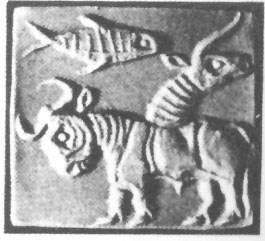 Harappa seal (h330). Seal. National Museum: 135
Harappa seal (h330). Seal. National Museum: 135 जांगड [jāṅgaḍa] ad Without definitive settlement of purchase--goods taken from a shop. जांगड [ jāṅgaḍa ] f ( H) Goods taken from a shop, to be retained or returned as may suit: also articles of apparel taken from a tailor or clothier to sell for him. 2 or जांगड वही The account or account-book of goods so taken.
![Related image]() Seal m0296. A pair of heifers (with one horn each) flanking a 'standard device' and nine leaves emerging from a stylized tree. lo 'nine' (phonetic determinant: loa 'ficus religiosa') rebus: loh 'copper, metal' PLUS खांडा [ khāṇḍā ] A jag, notch, or indentation (as upon the edge of a tool or weapon. Thus, together: लोखंडकाम [ lōkhaṇḍakāma ] n Iron work; that portion (of a building, machine &c.) which consists of iron. 2 The business of an ironsmith. An alternative reading is possible to read the hieroglyph: chain, link (a loop emanating out of the notched vessel ending in rings): dama ʻchain, ropeʼ; dhamaka 'blacksmith' (Samskritam) Hence, lōkhaṇḍa PLUS dhamaka 'iron work blacksmith or iron smith'.
Seal m0296. A pair of heifers (with one horn each) flanking a 'standard device' and nine leaves emerging from a stylized tree. lo 'nine' (phonetic determinant: loa 'ficus religiosa') rebus: loh 'copper, metal' PLUS खांडा [ khāṇḍā ] A jag, notch, or indentation (as upon the edge of a tool or weapon. Thus, together: लोखंडकाम [ lōkhaṇḍakāma ] n Iron work; that portion (of a building, machine &c.) which consists of iron. 2 The business of an ironsmith. An alternative reading is possible to read the hieroglyph: chain, link (a loop emanating out of the notched vessel ending in rings): dama ʻchain, ropeʼ; dhamaka 'blacksmith' (Samskritam) Hence, lōkhaṇḍa PLUS dhamaka 'iron work blacksmith or iron smith'.
Rings on neck, one horn on young bull reinforce the phonetics of:
Thus, the pictorial motif consisting of hieroglyph multiplex PLUS text inscription:
Pictorial: lōkhaṇḍa PLUS dhamaka 'iron work blacksmith or iron smith' PLUS कोंद kōnda ‘engraver, lapidary setting or infixing gems’
Text: kolel kaNDa ayaskANDa kancu vaThAra 'quarter of town for smithy, excellent iron, metalware, bronze'.
Thus, the message of the Mohenjo-daro seal m0296 is a reference to a quarter of town for metalwork and metalcrafts by blacksmith and engraver-lapidary setting or infixing gems.
*gōṭṭa ʻ something round ʼ. [Cf. guḍá -- 1. -- In sense ʻ fruit, kernel ʼ cert. ← Drav., cf. Tam. koṭṭai ʻ nut, kernel ʼ, Kan. goṟaṭe &c. listed DED 1722]K. goṭh f., dat. °ṭi f. ʻ chequer or chess or dice board ʼ; S. g̠oṭu m. ʻ large ball of tobacco ready for hookah ʼ, °ṭī f. ʻ small do. ʼ; P. goṭ f. ʻ spool on which gold or silver wire is wound, piece on a chequer board ʼ; N. goṭo ʻ piece ʼ, goṭi ʻ chess piece ʼ; A. goṭ ʻ a fruit, whole piece ʼ, °ṭā ʻ globular, solid ʼ, guṭi ʻ small ball, seed, kernel ʼ; B. goṭā ʻ seed, bean, whole ʼ; Or. goṭā ʻ whole, undivided ʼ, goṭi ʻ small ball, cocoon ʼ, goṭāli ʻ small round piece of chalk ʼ; Bi. goṭā ʻ seed ʼ; Mth. goṭa ʻ numerative particle ʼ; H. goṭ f. ʻ piece (at chess &c.) ʼ; G. goṭ m. ʻ cloud of smoke ʼ, °ṭɔ m. ʻ kernel of coconut, nosegay ʼ, °ṭī f. ʻ lump of silver, clot of blood ʼ, °ṭilɔ m. ʻ hard ball of cloth ʼ; M. goṭā m. ʻ roundish stone ʼ, °ṭī f. ʻ a marble ʼ, goṭuḷā ʻ spherical ʼ; M. goṭ ʻ hem of a garment, metal wristlet ʼ. (CDIAL 4271)
sangāṭh
खोंड (p. 216) [ khōṇḍa ]A variety of
*gōṭṭa -- : also Ko. gōṭu ʻ silver or gold braid ʼ.; Si. guṭiya ʻ lump, ball ʼ; -- prob. also P. goṭṭā ʻ gold or silver lace ʼ, H. goṭā m. ʻ edging of such ʼ (→ K. goṭa m. ʻ edging of gold braid ʼ, S. goṭo m. ʻ gold or silver lace ʼ) (CDIAL 4271)
kod. = place where artisans work (Gujarati) kod. = a cow-pen; a cattlepen; a byre (G.lex.) gor.a = a cow-shed; a cattleshed; gor.a orak = byre (Santali.lex.) कोंड [ kōṇḍa ] A circular hedge or field-fence. 2 A circle described around a person under adjuration. 3 The circle at marbles. 4 A circular hamlet; a division of a
Ka. kunda a pillar of bricks, etc. Tu. kunda pillar, post. Te. kunda id. Malt. kunda block, log. ? Cf. Ta. kantu pillar, post.(DEDR 1723).கற்கந்து kaṟ-kantu , n. < கல் +. Stone pillar; கற்றூண். கற்கந்தும் எய்ப்போத்தும் . . . அனை யார் (இறை. 2, உரை, 27).
खोंड A variety of जोंधळा. खोंडा khōṇḍā m A कांबळा of which one end is formed into a cowl or hood. खोंडरूं khōṇḍarūṃ n A contemptuous form of खोंडा in the sense of कांबळा-cowl. खोंडी khōṇḍī f An outspread shovelform sack (as formed temporarily out of a कांबळा, to hold or fend off grain, chaff &c.) See under खुंडी. 2 A species or variety of जोंधळा. खुंडी khuṇḍī f A cloth doubled over and sewn at one end, forming a घोंगता, खोपा, or खोळ (an open or outspread shovel-form sack). Used in exposing grain in the market. 2 A species or variety of जोंधळा.
खुडी khuḍī f A shed or thatching over a laid-up ship or boat. 2 A cow-shed, a fowl-house, a dove-cot &c.; esp. a pen or fold for calves. 3 The hole and apparatus made in a horse's stall to receive his urine. 4 A breed or stock (esp. of camels).
अखोटा [ akhōṭā ] m A groove or channel notched (as around a peg or stick) for a rope; also a sliding or running groove. 2 A projecting point, a snag. v लाग .
खांडा [ khāṇḍā ] A jag, notch, or indentation (as upon the edge of a tool or weapon.(Kashmiri) खांडा (p. 202) [ khāṇḍā ] m A kind of sword, straight, broad-bladed, two-edged, and round-ended. (Marathi) Thus, Panini: ayaskANDa 'excellent iron'.
लोखंडकाम [ lōkhaṇḍakāma ] n Iron work; that portion (of a building, machine &c.) which consists of iron. 2 The business of an ironsmith.
Hieroglyph: dama ʻ chain, rope ʼ (Si.): dāˊman1 ʻ rope ʼ RV. 2. *dāmana -- , dāmanī -- f. ʻ long rope to which calves are tethered ʼ Hariv. 3. *dāmara -- . [*dāmara -- is der. fr. n/r n. stem. -- √dā 2 ]1. Pa. dāma -- , inst. °mēna n. ʻ rope, fetter, garland ʼ, Pk. dāma -- n.; Wg. dām ʻ rope, thread, bandage ʼ; Tir. dām ʻ rope ʼ; Paš.lauṛ. dām ʻ thick thread ʼ, gul. dūm ʻ net snare ʼ (IIFL iii 3, 54 ← Ind. or Pers.); Shum. dām ʻ rope ʼ; Sh.gil. (Lor.) dōmo ʻ twine, short bit of goat's hair cord ʼ, gur. dōm m. ʻ thread ʼ (→ Ḍ. dōṅ ʻ thread ʼ); K. gu -- dômu m. ʻ cow's tethering rope ʼ; P. dã̄u, dāvã̄ m. ʻ hobble for a horse ʼ; WPah.bhad. daũ n. ʻ rope to tie cattle ʼ, bhal. daõ m., jaun. dã̄w; A. dāmā ʻ peg to tie a buffalo -- calf to ʼ; B. dām, dāmā ʻ cord ʼ; Or. duã̄ ʻ tether ʼ, dāĩ ʻ long tether to which many beasts are tied ʼ; H. dām m.f. ʻ rope, string, fetter ʼ, dāmā m. ʻ id., garland ʼ; G. dām n. ʻ tether ʼ, M. dāvẽ n.; Si. dama ʻ chain, rope ʼ, (SigGr) dam ʻ garland ʼ. -- Ext. in Paš.dar. damaṭāˊ, °ṭīˊ, nir. weg. damaṭék ʻ rope ʼ, Shum.ḍamaṭik, Woṭ. damṓṛ m., Sv. dåmoṛīˊ; -- with -- ll -- : N. dāmlo ʻ tether for cow ʼ, dã̄wali, dāũli, dāmli ʻ bird -- trap of string ʼ, dã̄wal, dāmal ʻ coeval ʼ (< ʻ tied together ʼ?); M. dã̄vlī f. ʻ small tie -- rope ʼ.2. Pk. dāvaṇa -- n., dāmaṇī -- f. ʻ tethering rope ʼ; S. ḍ̠āvaṇu, ḍ̠āṇu m. ʻ forefeet shackles ʼ, ḍ̠āviṇī, ḍ̠āṇī f. ʻ guard to support nose -- ring ʼ; L. ḍã̄vaṇ m., ḍã̄vaṇī,ḍāuṇī (Ju. ḍ̠ -- ) f. ʻ hobble ʼ, dāuṇī f. ʻ strip at foot of bed, triple cord of silk worn by women on head ʼ, awāṇ. dāvuṇ ʻ picket rope ʼ; P. dāuṇ, dauṇ, ludh. daun f. m. ʻ string for bedstead, hobble for horse ʼ, dāuṇī f. ʻ gold ornament worn on woman's forehead ʼ; Ku. dauṇo m., °ṇī f. ʻ peg for tying cattle to ʼ, gng. dɔ̃ṛ ʻ place for keeping cattle, bedding for cattle ʼ; A. dan ʻ long cord on which a net or screen is stretched, thong ʼ, danā ʻ bridle ʼ; B. dāmni ʻ rope ʼ; Or. daaṇa ʻ string at the fringe of a casting net on which pebbles are strung ʼ, dāuṇi ʻ rope for tying bullocks together when threshing ʼ; H. dāwan m. ʻ girdle ʼ, dāwanī f. ʻ rope ʼ, dã̄wanī f. ʻ a woman's orna<-> ment ʼ; G. dāmaṇ, ḍā° n. ʻ tether, hobble ʼ, dāmṇũ n. ʻ thin rope, string ʼ, dāmṇī f. ʻ rope, woman's head -- ornament ʼ; M. dāvaṇ f. ʻ picket -- rope ʼ. -- Words denoting the act of driving animals to tread out corn are poss. nomina actionis from *dāmayati 2 .3. L. ḍãvarāvaṇ, (Ju.) ḍ̠ã̄v° ʻ to hobble ʼ; A. dāmri ʻ long rope for tying several buffalo -- calves together ʼ, Or. daũ̈rā, daürā ʻ rope ʼ; Bi. daũrī ʻ rope to which threshing bullocks are tied, the act of treading out the grain ʼ, Mth. dã̄mar, daũraṛ ʻ rope to which the bullocks are tied ʼ; H. dã̄wrī f. ʻ id., rope, string ʼ, dãwrī f. ʻ the act of driving bullocks round to tread out the corn ʼ. -- X *dhāgga <-> q.v.. Brj. dã̄u m. ʻ tying ʼ.*dāmara -- : Brj. dã̄wrī f. ʻ rope ʼ.(CDIAL 6283)
Rebus: dam 'blast of furnace' (Kashmiri): dhamá in cmpds. ʻ blowing ʼ Pāṇ., dhamaka -- m. ʻ blacksmith ʼ Uṇ.com. [√dham ]Pa. dhama -- , °aka -- m. ʻ one who blows ʼ, Pk. dhamaga<-> m.; K. dam m. ʻ blast of furnace or oven, steam of stewing ʼ; -- Kho. Sh.(Lor.) dam ʻ breath, magical spell ʼ ← Pers. dam. dhamana n. ʻ blowing with bellows ʼ lex. [√dham ]K. damun m. ʻ bellows ʼ. -- Ash. domótilde; ʻ wind ʼ (→ Pr. dumūˊ), Kt. dyīmi, Wg. damútildemacr;, Bashg. damu; Paš.lauṛ. dāmāˊn, kuṛ. domón, uzb. damūn ʻ rain ʼ (< ʻ *storm ʼ → Par. dhamāˊn ʻ wind ʼ IIFL i 248): these Kaf. and Dard. forms altern. < dhmāna -- ?(CDIAL 6732) dam 1 दम् । क्षणमात्रकालः, प्राणनिरोधः, अतिधर्मबाधा, योगक्षेमनिर्वाहः, निमज्जनम् m. (sg. abl. dama 1 दम ; pl. dat. daman 1 दमन् , spelt damn in K.Pr. 46; for daman 2 see s.v.; for 3, 4 see damun 1, 2; with suff. of indef. art. damāh दमाह् q.v., s.v.), breath, vital air, life, the breath of life (K.Pr. 67, Rām. 15, 17); breath or blast (of a furnace or oven); stewing or simmering over a slow fire, braising; a moment, an instant (YZ. 1, 216, Śiv. 133, Rām. 898, 113)(Kashmiri) धमनी (p. 433) [ dhamanī ] f S A small tube through which to puff the fire. 2 Any tubular vessel of the body, as an artery, a vein, a nerve.(Marathi).![]()
![]() Compartmented seal fragment from Mohenjo-daro (MIC, pl. CLVIII:3) Pictorial-49
Compartmented seal fragment from Mohenjo-daro (MIC, pl. CLVIII:3) Pictorial-49
![Image result for offering stool vessel with ladles huntington indus seal]() m1656 Mohenjo-daro pectoral with two streams of water flowing out of pot. Hieroglyphs: overflowing pot, young bull, standard device. kaṇḍa = a pot of certain shape and size (Santali) Rebus: kaṇḍ = altar, furnace (Santali)
m1656 Mohenjo-daro pectoral with two streams of water flowing out of pot. Hieroglyphs: overflowing pot, young bull, standard device. kaṇḍa = a pot of certain shape and size (Santali) Rebus: kaṇḍ = altar, furnace (Santali)
veṛhā octopus, said to be found in the Indus (Jaṭki lexicon of A. Jukes, 1900)
வேதி² vēti, n. < vēdi. 1. Low platform within a house, for sacrifices, weddings, etc.; மணம் முதலிய சடங்கு நிகழ்த்தும் மேடை. மைந்த னைச் செம்பொன்வேதி யெறிக்குங் கிரணமணிப் பீடம தேற்றினாரே (பாரத. திரெள. 91). 2. See வேதிகை¹, 1. கீதசாலை வேதிநிறைய (பெருங். உஞ் சைக். 34, 224). 3. Outer wall of a fortification; compound wall; மதில். (சூடா.) 4. See வேதிகை¹, 3. பாத்திரவேதி, திருமஞ்சனவேதி. 5. Sacrificial pit; ஓமகுண்டம். (பிங்.) 6. The 18th nakṣatra. See கேட்டை¹, 1. (பிங்.)
வேதி&sup4; vēti
, n. < வேதி³-. Transmuting; தாழ்ந்தவற்றை யுயர்பொருளாக மாற்றுகை. குளிகை கொடு பரிசித்து வேதி செய்து (தாயு. சின்மயா. 7).வேதை² vētai , n. < bhēda. 1. Alchemy, transmutation of metals; இரசவாதம். (W.)
வேதிதம் vētitam , n. < vēdhita. (யாழ். அக.) 1. Perforating, drilling; துளைக்கை. 2. Tube; துளையுடைப்பொருள். வேதை³ vētai , n. < vēdha. 1. Drilling, boring; துளைக்கை.
mẽhi bāṭi ʻ vessel with a projecting base ʼ(Maithili) meṭṭa ‘projecting’ (Telugu)
https://www.academia.edu/8349230/Indus_writing_mlecchita_vikalpa_Meluhha_cipher_6._Meluhha_metallurgy_Tin_Road_trade_and_interaction_narratives![Image result for offering stool vessel with ladles huntington indus seal]()
![]()
![]() m1186 (DK6847) [Pleiades, scarfed, framework, ficus religiosa , scarfed
m1186 (DK6847) [Pleiades, scarfed, framework, ficus religiosa , scarfed
person, worshipper, twigs (on head), horn, markhor, human face ligatured to
markhor, stool, ladle, frame of a building]
ṭhaṭṭha -- 1 , kāra -- 1 ] 1. Pk. ṭhaṭṭhāra -- m., K. ṭhö̃ṭhur m., S. ṭhã̄ṭhāro m., P. ṭhaṭhiār, °rā m.
2. P. ludh. ṭhaṭherā m., Ku. ṭhaṭhero m., N. ṭhaṭero, Bi. ṭhaṭherā, Mth. ṭhaṭheri, H. ṭhaṭherā m.(CDIAL 5490, 5493).
![]() m300 Mohenjo-daro seal. Ligaturing components: horns of zebu, human face, tail-hood of serpent, elephant tusk, scarves on neck, bovine forelegs, feline hind legs.
m300 Mohenjo-daro seal. Ligaturing components: horns of zebu, human face, tail-hood of serpent, elephant tusk, scarves on neck, bovine forelegs, feline hind legs.
![]() The composite animal (bovid) is re-configured by Huntington. http://huntington.wmc.ohio-state.edu/public/index.cfm
The composite animal (bovid) is re-configured by Huntington. http://huntington.wmc.ohio-state.edu/public/index.cfm
![]()
Elephant, trunk of elephant: kar-ibha, ib; rebus: karba 'iron'; ib 'iron'.युवं नरा स्तुवते पज्रियाय कक्षीवते अरदतं पुरंधिम् । कारोतराच्छफादश्वस्य वृष्णः शतं कुम्भाँ असिञ्चतं सुरायाः ॥१.११६.७॥O Heroes, ye gave wisdom to Kaksivan who sprang from Pajras' line, who sang your praises.
Ye poured forth from the hoof of your strong charger a hundred jars of wine as from a strainer. (RV 1.116.7)
Kaksivan, Pajras' son, must laud that exploit of yours, Nasatyas, Heroes, ye who wander!
When from the hoof of your strong horse ye showered a hundred jars of honey for the people. (RV 1.117.6)
परी--शास m. ( √ शस्) anything cut out , an excision AV.; a kind of tongs used for lifting a kettle from the fire S3Br.
https://tinyurl.com/ycjn4ytv
शफ an eighth (because of the divided hoofs of the cow ; cf. पाद , a fourth or aṣṭau śaphāh, 'eight hoofs') RV. TS. Śatapatha Brāhmaṇa; a wooden implement formed like a claw or hook (for lifting an iron pot or pan from the fire)ब्राह्मण; लाट्यायन-श्रौत-सूत्र.
According to the R̥gveda 5.30.15, the Mahāvīra vessel was made of metal (ayasmaya) and it was called Gharma, which is also the word for the milk poured into a heated vessel. In later Vedic texts, the vessel became known as Pravargya, which is initially the name of the ritual. The Pravargya ritual is not directly mentioned in the R̥gveda. However, its name is derived from the R̥gvedic word prav r̥j mentioned in the same hymn. This word means ‘ceremonial heating and boiling’.
Thus, śaphau are two hoofs of a cow, often referred to as nandipada (Nandi's footprint) symbol.
Atharvaveda 5.14.3:
r̥ṣasyeva parīśāsam parikr̥tya pari tvacah
"Vedic people made a pair of tongs out of two objects called pariśāsas; hence, the (wooden) implement was known to them as pariśāsau. pariśāsa (single in number) is described in the Atharvaveda as an object protruding above the skin of a r̥ṣya." -- Gautam V. Vajracharya
ऋश्य or (in later texts) ऋष्य, m. the male of a species of antelope , the painted or white-footed antelope RV. viii , 4 , 10 AV. v , 14 , 3 VS. AitBr. Sus3r. (Monier-Williams)
http://crossasia-journals.ub.uni-heidelberg.de/index.php/ejvs/article/view/322
Unicorns in Ancient India and Vedic Ritual by Gautama V. Vajracharya The art of the Indus Valley civilization is famous for diminutive steatite seals representing bull like unicorns. Did such unicorns really exist in ancient India? This question may not receive scholarly attention because most of the archeologists believe that the creatures are mythical. (To my knowledge the latest scholarly work on unicorn seal is E. C. L. During Caspers, “The Indus Valley 'Unicorn' A Near Eastern Connection?” Journal of the Economic and Social History of the Orient, vol. 34:2, 1991, p. 312—350. According to her “the Indus Valley 'unicorn' is a watered-down version, often recopied, of the commonly portrayed one-horned bovine of the late Protoliterate c-d and Early Dynastic times in Mesopotamia…” If she were familiar with our new discovery that we have presented here, I believe that she would have a different view regarding the Indus unicorn.) Our recent investigation, however, indicates that a forest animal with a single horn did exist in ancient India. The name of the animal is ṛśya (ṛṣya in classical Sanskrit), which is mistakenly identified by previous scholars as a male deer or antelope thus blocking the path for further investigation. In order to explain our finding we first carefully observe the artistic representations of the unicorn bull, mainly its single horn, delineated in the seals. Then we will compare the representations with the textual descriptions of the ṛśya and its horn found in the epics and Buddhist literature. This will be followed by evidence derived from two different unexpected sources, material used for making Vedic ritual implements and the symbolic representation of the bifurcated bovine hoof in ancient Indian art. Representations of Unicorns in the Indus Seals Despite the diminutive size, most of the Indus Valley seals depict the animals naturalistically; hence, viewers have no difficulties in distinguishing various species of animals. In fact, the characteristics of various animals such as short or long bushy tails, divided hooves, dewlap, arched, twisted or spiral horns, standing posture, attitude of lifting the head, and many other features of different animals are rendered in the seals so distinctively that a markhor never looks like a deer and a water buffalo does not resemble a bull. Besides, some of the seals are so well preserved they seem as if they were chiseled only yesterday. Fig. 1 (Mohenjo-daro HR 743) is one of the well-preserved seals depicting a unicorn bull. Characteristically, the unicorn is shown here standing immediately below the inscription, facing the unidentified bulbous object. According to some archeologists this object is either a manger, incense burner, or a ritual offering stand. Characteristically, it surmounts a post, which is erected on the ground. Note the fact that delineation of the ground is non-existent in the artistic vocabulary of Indus valley art, as well as in the pre-historic art of other ancient traditions. The pointed, curvilinear single horn emerges from the head of the animal, almost making an S-curve; hence, it differs from the arched horn of a bull and other creatures. Except at the tip and root, for the most part, the horn is ribbed. These features are also seen in many other Indus seals, with fig. 2 (Harappa H-9) being another example. In both examples, an erect earlobe overlapping the other is shown behind the horn. Is it possible that the horn is also overlapped, which might be why the animal looks like a unicorn? This question has been satisfactorily answered by the finding of three-dimensional terracotta figures of the unicorn (Jonathan Mark Kenoyer, Ancient Cities of the Indus Valley Civilization. Karachi: American Institute of Pakistan Studies, 1998, p. 87.). It is true that the bovine hoof and long bushy tail of the unicorn bull remind us of similar features on a bull. However, the neck of this unicorn is much more elongated than that of a bull and bears some similarity to that of a horse or an ass. Apparently, the linear pattern we see around the shoulder of the animal (fig. 1) is a stylistic element of the Indus valley art. It may indicate fleshy but tight wrinkles of a healthy animal. The male genitalia, as usual, are shown emphatically—no doubt to indicate the procreative power of the animal. Figure 1. Indus seal showing unicorn bull Figure 2. Indus seal showing unicorn bull, Mohenjo-daro (HR 743). Copyright Harappa (H-9), after Asko Parpola, Deciphering J. M. Kenoyer, Courtesy Dept. of the Indus Script, 1994, p. 231 Archeology and Museums, Govt. or Pakistan.
![]()
![]()
Understandably, there are reasons why many scholars have difficulty accepting this animal as a real creature. First, the Indus seals depict not only real animalArt, Form and Meaning, Mumbai: Marg, 2007, pp. 46, 49.) However, because the Ṛṣyaśṛṅga was the male offspring of the rohit he inherited the single horn, a masculine feature of the ṛṣya. This was the main reason he was given the descriptive name Ṛṣyaśṛṅga, a Bahuvrīhi compound meaning “one who has the horn of a ṛśya.” Previous scholars did not give any attention to such information derived from the Mahābhārata statement. As a result, they never tried to find the ṛśya being mentioned in Vedic literature as a unicorn. The authors of the Vedic Index (vol. 2, p. 115) summarize the Vedic scholars’ study regarding the animal in the following words: “Ṛśya -- This is the correct spelling of a word that occurs in the Ṛigveda and the later literature meaning ‘stag,’ the feminine being Rohit. Apparently deer were caught in the pits (ṛśya-da). The procreative power of the stag (ārśya vṛṣṇya) was celebrated.” The earliest textual reference to ṛśya is found in the Ṛgveda 8.4.10 “O Indra, visit us like the thirsty ṛśya which comes to drink water from avapāna.” Here, the creature is described as a forest animal, which comes occasionally near the Vedic settlement to drink water from avapāna, a small tank designed for supplying water for cattle. Atharvaveda 4.4, on the other hand, repeatedly refers to ṛśya as a virile animal, which indeed corresponds with the depiction of the unicorn in the Indus seals. But our Vedic evidence, that helps us verify our view that ṛśya was a single-horned animal, comes from an unexpected source, material used for the Vedic ritual implement called parīśāsau. (Grammatically, this word is in dual form with the singular being parīśāsa). Eggeling explains the meaning of the word in a footnote to his translation of the Śatapatha Brāhmaṇa:“The ‘parīśāsau (also called ‘śaphau,’ XIV, 2, 1, 16) are two pieces of wood or laths apparently fastened together by a kind of clasp (or a cord) at one end, so as to serve the purpose of a pair of tongs (parīśāsau saṃdaṃśakarau, comm. on Kātyā. XXIV, 2, 10) for taking up the Mahāvīra pot, which must not be handled in any other way… at the end of the sacrifice, the Adhvaryu, by means of them, turns the pot upside down so as to pour the remainder of its contents into the offering spoon (see Kātyā. XXIV, 6, 17 with comm.)” (Julius Eggeling (trans.), The Śatapatha-Brāhmaṇa According to the Text of the Mādhyandina School, Delhi: Motilal Banarasidas, reprint 1972, part 5, p. 458-459)This statement is correct except for the fact that the pair of tongs was not made of wood. My view is partially based on an interesting passage from the Śatapatha Brāhmaṇa 14. 2. 54, which explains that the implement was made of a material that could handle the temperature of the heated vessel if the vessel was made of clay rather than stone. I will quote Eggeling’s translation: “If it [the Mahāvīra vessel also called Gharma] were made of wood, it would be burnt; and if of gold, it would dissolve; and if of copper, it would melt; and if of stone, it would burn the two handling-sticks [parīśāsau]; and that (Gharma) itself submitted to that (earthen vessel): therefore it is by means of an earthen one that he offers it.” This statement echoes the real history of the Vedic experience of making two important ritual objects: the Mahāvīra vessel and the handling sticks. According to the Ṛgveda 5.30.15, the vessel, at that time, was made of metal (ayasmaya) and it was called Gharma, which is also the word for the milk poured into a heated vessel. In later Vedic texts, the vessel became known as Pravargya, which is initially the name of the ritual.(There are two excellent works on the Pravargya rituals; J. A. B. van Buitenen, Pravargya, Poona: Deccan College, Postgraduate and Research Institute, 1968, and Jan E. M. Houben, The Pravargya Brahma a of the Taittirīya Āraṇyaka, an ancient commentary on the Pravargya ritual, Delhi: Motilal Banarasidas Publishers , 1991. ) The Pravargya ritual is not directly mentioned in the Ṛgveda. However, its name is derived from the Ṛgvedic word pravṛj mentioned in the same hymn. Apparently this word means “ceremonial heating and boiling.” As we know from the Śatapatha Bṛāhmaṇa 14, 2, 1, 16, quoted below, the heated vessel symbolized the solar disc and the main significance of the Pravargya ritual was to create solar heat. Keeping this in mind, the Vedic priests heated the vessel to an extreme temperature. As a result, they must have actually witnessed the disastrous event of the melting metal vessel. Therefore, beginning from the time of the Yajurveda, they gave preference to the earthen vessel.(Michael Witzel, in a response to a draft version of my work, kindly provided me with following information “The cooking pot" is the Pravargya vessel, in the Ṛgveda still made of metal, in the Yajurveda of clay -- as it is heated until it is glowing red hot. The milk then poured in virtually explodes up to the roof! In that hot state it is taken out by the śaphau.”) Such reality of Vedic experience helps us understand the choice of material for making the pair of tongs as well. Since the vessel was burning like fire, certainly, a wooden implement would not have been considered a good choice, although this is the case in contemporary Vedic rituals. Apparently, depending on the modern use of material for making such Vedic implements, Eggeling thought that the handling-sticks (or the pair of tongs) were made of wood.(For a contemporary pair of tong, made of wood, see T. N. Dharmadhikari, Yajñāyudhāni, Pune: Vaidika-Samśodhana-maṇḍalam, 1989, P. 42) There is, however, no textual reference that supports this view. On the other hand, we have good reasons to believe that Vedic priests solved the problem ingeniously by making the pair of tongs out of the ṛśyas’ horns. The main point of our argument derives from following statement from Atharvaveda 5.14.3: ṛśyasyeva parīśāsaṃ parikṛtya pari tvacaḥ / kṛtyāṃ kṛtyākṛte devā niṣkam iva prati muñcata // Whitney translates the hymn as follow: “Having cut around out of [his] skin a strip (parīśāsa), as if it were of a stag, fasten, O gods, upon the witchcraft-maker the witchcraft, like a necklace.” The word parīśāsa is translated here as a strip of skin. Bloomfield also believes that it means skin: “Cutting out from the skin (of the enemy) as if (from the skin) of an antelope, do, ye, O gods, fasten the spell upon him that prepares it, as (one fastens) an ornament!” The author translates the word parīśāsa into “the skin of the enemy.” He places the word “enemy” in parentheses to acknowledge that it was not given in the text. We have, however, difficulty accepting these translations mainly because both parīśāsam and parīśāsau derive from same root. The only difference between them is that the first is accusative singular and the second is dual, which could be either nominative or accusative. The authors were certainly familiar with this simple grammar. For some reasons, however, when they were translating the Atharva hymn, reference to parīśāsau in other Vedic texts escaped from their attention. Consequently, they did not raise an important question. If parīśāsa actually means “a strip of skin,” how would it be possible to make parīśāsau, the handling sticks, or a pair of tongs out of such material? We have modified the translation as follows: O gods, chop off the spell like the single horn (parīśāsam) of the ṛśya around its skin and fasten the spell upon him, who prepares it, as (one fastens) an ornament. Keeping aside, for a moment, the differences in the translations of parīśāsa, if we study this brief statement carefully, it clearly informs us that parīśāsa was an object that grew out of the body of the ṛśya and that it could be chopped off above the skin. What could this single object be, which is so closely associated with the ṛśya’s physique? It cannot be either the tail or the earlobe of the animals, because neither of these organs is sturdy enough to make a pair of tongs to hold the heated earthen pot. On the other hand, if we compare this Vedic information with the Mahābhārata and the Buddhist evidence that ṛṣya was a forest animal with a single horn, it becomes abundantly clear that parīśāsa was the single horn of the unicorn ṛśya. According to Sanskrit Dictionaries, khaḍga is rhinoceros’s horn; the word also means a scimitarlike knife and the rhino itself. Likewise, parīśāsa apparently was a word with double meaning: ṛśya’s horn and a weapon. Pari/parī is a prefix indicating “around” or “encircling.” The second word stands for a knife as in śāsapāṇi, “person with a knife in his hand.” Possibly, therefore, parīśāsa means not only the horn but also a sickle-shaped curvilinear knife. Except in the above given Atharvaveda statement, the word parīśāsa is always used in dual number. This observation is important, because it supports our view that ṛśya wore a single horn; but the pair of tongs had been made of two horns from two different unicorn ṛśya bulls. Logically, the horns of domesticated animals such as a bull would have been more convenient and easily available for making the handling sticks or the pair of tongs. Ironically, however, the Vedic people chose the horn of a forest animal, which could provide them with only one horn at a time. There were several reasons for this choice. First, the horns of other animals like bulls and water buffaloes are too short to reach the heated vessel in the middle of the fire. Second, they are hollow and lacking the meandering double arches that are a mandatory feature for making the tongs correctly. Pali literature tells us that just as the characteristic of a snake’s tongue is bifurcation, the main feature of the ṛśya’s horn (singular) is its curvilinearity (issasiṅgam iva viparivattāyo, uragam iva dujihvāyo, Khuddaka Nikāya 1. Jātaka 5, Record 7740).(Pali Canon Online Database, http://www.bodhgayanews.net/pali.htm) In a different sentence of the same Pali text, the ṛśya’s horn is described as āvatta or “winding,” an adjective also used in Pali literature to denote the undulating course of a river. Exactly as stated in Pali literature, the horn of the unicorn is almost always shown in the seals looking characteristically undulating like the meandering course of a river (figs. 1, 2).In order to examine the accuracy of our view, we made an image of the Vedic implement (fig. 3) placing crosswise two horns of two different unicorns, depicted in the Indus seals (Harappa H-9 and H-6). Promptly, I noticed that the image bears some similarity with Nandipada, the auspicious symbol frequently seen in ancient Indian art (fig. 4). The promptness of my observation is perhaps based on the fact that originally I was working on the relation between the Vedic word Prauṣṭhapadā and Nandipada symbol. This led me to investigate the unicorn. We will discuss the significance of Prauṣṭhapadā in detail in a different occasion. But here it is important to note that the main feature of the original Nandipada symbol of the earlier time is the circular upper part supported by two legs. In our image (fig. 3), one can clearly see the oval space, created by the inward facing tips of the S-curves of the horns, resembling the circular upper section of Nandipada, whereas the lower sections of the horns below the crossing point certainly look like the legs or the hands of the symbol. Thus, if our view that parīśāsa is the horn of a unicorn is correct the Vedic implement more or less has to look like a Nandipada symbol, which is the main point of the following discussion.
![]()
![]()
Śaphau
As Eggeling has correctly noted, the pair of tongs were also called śaphau. His view is based on the following statement from the Śatapatha Bṛāhmaṇa 14, 2, 1, 16: “You are Gāyatrī meter and you are Triṣṭubh meter” (while reading this mantras,) then he holds (two tongs) of the implement śaphau. Thus, he actually encompasses (the Pravargya vessel) with Gāyatrī and Triṣṭubh metre. “I will encompass you with heaven and earth.” Indeed, heaven and earth are (two tongs) of parīśāsau, and the sun is Pravargya.” The solar symbolism of the Pravargya vessel is explained here using śaphau and parīśāsau alternatively, thus, indicating that they are synonyms. When Vedic rituals are performed in modern time, one can expect to hear the word śaphau for the wooden implement; but parīśāsau seems to be almost forgotten. Śapha in general means a hoof. Therefore, at first glance, the word śaphau as the synonym for parīśāsau appears to be problematic, perhaps, even threatening my argument. But, actually, the nomenclature provides us further evidence that proves our view more emphatically. The dual form śaphau is used specifically for a bovine hoof. Unlike the hoof of a horse, the bovine hoof is bifurcated. Thus, a horse has four śaphas, whereas a bovine animal has eight (aṣṭau śaphāḥ). Another Sanskrit word for the bovine hoof or footprint is goṣpada. A later Vedic text called Suparṇādhyāya 1.3-4 and Paṇini’s Aṣṭādhyāyī 3.4.32 obliquely indicates that a bull’s or cow’s footprint (goṣpada) filled with rainwater predicts the end of a drought. The Vedic text refers to a story of Vālakhilyas who were so tiny that they were drowning in the water and mud settled in the footprint of a cow (goṣpada). In the legend of Garuda, this event plays an important role, because it is a predecessor of the birth of the sun bird who created severe drought. As a result, not only cows’ footprints but even oceans dried up. Sanskrit literature has an expression goṣpadapraṃ (or goṣpadapūraṃ) vṛṣṭo devaḥ, “it rained so much that the footprint of the cow was filled with water.” Above-mentioned Pāṇini’s sūtra is actually based on such expressions. In the artistic tradition of India, goṣpada, as an auspicious symbol, is more popularly known as Nandipada. Earliest epigraphic reference to Nandipada is found in a ca. second century BC stone carving representing the symbol identified by a label inscription as naṃdipaaṃ. (A. K. Coomaraswamy, Elements of Buddhist Iconography, New Delhi: Munshiram Manoharlal Publishers, 1979, P. 15.) The Sanskrit word Nandipada, as Taddhita compound, can be translated as “Nandin’s footprint.” Recently, however, a scholar has convincingly shown that Nandin is one of Śiva’s gaṇa rather than his animal vehicle, which is almost always designated in Sanskrit literature either as vṛṣa or vṛṣabha. (Gouriswar Bhattacharya, Essays on Buddhist Hindu Jain Iconography and Epigraphy, Dhaka: The International Centre for Study of Bengal Art, 2000, pp. 149-172.) Therefore, the nomenclature of the symbol can be understood properly only if we give an attention to the fact that the concept associated with the significance of a bull’s footprint is much earlier than the classical period iconography and story of Śiva and his gaṇa. In Pali and Prakrit literature, nandī or nandin simply means a happy cow or a bull. Just as Nandipada, Nandiyāvatta (Sanskrit Nandyāvarta) is another auspicious symbol, not because it is a Śaiva or Buddhist symbol, but because it is associated with annually revolving growth (āvarta) of the cattle. Calves are born in the Indian subcontinent, particularly in the northern section, as I have seen in Nepal, at the very beginning of monsoon. According to the Ṛgvedic view, which is partially still alive in Nepal, celestial water descends to the earth together with domestic and aquatic creatures.(Gautama V. Vajracharya, “The Creatures of the Rain Rivers, Cloud Lakes: Newars Saw Them, So Did Ancient India” Asianart.com, January 2009, http://www.asianart.com/articles/rainrivers/index.html#i18) Compare the word nandyāvarta with puṣkalāvarta, the monsoon cloud that returns every year with plenty (puṣkala). Evidently, the concepts related to these symbols are based on drought and rain phenomena, which are indeed the main focus of the pre-Hindu and pre-Buddhist aestivation/monsoon culture of the subcontinent. This culture believed that everything closely or remotely associated with water and rain is auspicious. Thus, ancient India was fascinated with these symbols and both men and women wore ornaments made of clay or gold, designed after these symbols not only because they are aesthetically pleasing but also because they are auspicious. For instance, a second century BC Bharhut stone sculpture (fig. 5) depicts a precious necklace adorned with two Nandipada symbols flanking the rectangular pendants in the middle. Here, again, the symbols are represented with the circular element surmounting the fishtail like legs.
![]()
This is not, however, the earliest representation of Nandipada. Punch marked coins of India, dating back to the pre-Mauryan period (before c. 321 BC), frequently depict the simple form of the original Nandipada symbol bearing similarity with cow’s footprint.(For early appearance of Nandipada symbols, see Shinji Hirano, The Ghaghara-Gandak River Region, c. 600-300 BC, Archaic Silver Punchmarked Coinage, Mumbai: IIRNS Publications, 2007, p. 138.)This symbol is often designated as taurine, which is confusing because it has multiple meanings. We know for sure that the symbol does not pertain to the Taurus zodiacal sign. Frequent appearance of frogs in Indian coins that are shown sometime together with Nandipadas as well as our current investigation on goṣpada and śaphau clearly suggests that the symbol is conceptually identical with goṣpada “cow’s footprint.” Variations of Nandipada, shown as having fishtail like legs and being situated more often in an inverted position, began to appear soon after the third century BC. But the simple original form of the symbol continued to survive in Indian numismatic tradition for many decades without being replaced by new variations. Figure 6 is a perfect example of the older version of a Nandipada symbol depicted in a Śunga period (ca. 185-75 BC.) copper coin. It is this original form of the symbol that resembles more closely with the crossed horns of the unicorns (fig. 3). Evidently, this is the reason that the Vedic people designated the pair of tongs as Śaphau.
Conclusion
Presented here are multiple sources, both visual and textual, to demonstrate that the unicorns of the Indus seals are ṛśyas: 1. The unicorn’s curvilinear horn, almost in S-curves, is emphatically delineated in many Indus seals. 2. The Mahābhārata states that just like the male animal ṛśya, the mythical figure Ṛṣyaśṛṅga had a single horn. He is mentioned in Buddhist texts as Ekaśṛṅga, or “unicorn.” 3. Vedic people made a pair of tongs out of two objects called parīśāsas; hence, the implement was known to them as parīśāsau. 4. Parīśāsa (single in number) is described in the Atharvaveda as an object protruding above the skin of a ṛśya. 5. This object cannot be other than the single horn of the male animal, because, except the horn, other organs that protrude from the body of an animal are not sturdy enough to make a pair of tongs. 6. Pali literature tells us that characteristically, a ṛśya’s horn was curvilinear. This information corresponds with the shape of the horn of the unicorn shown in the Indus seals. 7. We created an image of the Vedic ritual implement crossing two horns of the different unicorns shown in the seals. More or less, the image appears like a Nandipada symbol. 8. In fact, we know for sure that the pair of tongs did look like a Nandipada because the implement was also known as śaphau, a Vedic word for Nandipada.
More importantly, our findings indicate that Vedic Aryans were familiar with some ecological aspects of the Indus Valley civilization, such as the animal habitats that existed around them. In our earlier work, we demonstrated that the popularity of the pipal tree in the Indus seals as a most important symbol of the civilization correlates with the significance of the tree mentioned in Vedic texts as a harbinger of monsoon. Vedic word for the pipal tree is aśvattha, which was also the name of the early month of monsoon in the everyday language of ancient India, mainly in the upper Indus Valley.(Gautama V. Vajracharya, “Pipal Tree, Tonsured Monks, and Ushnisha,” in Pratapaditya Pal (ed.), Buddhist Art, Form and Meaning, Mumbai: Marg Publication, 2007, pp. 16-17.) Such correlation prods us to develop a research methodology based on the ecologically linked cultural aspects of the Indus and Vedic civilizations.
 Seal m0296. A pair of heifers (with one horn each) flanking a 'standard device' and nine leaves emerging from a stylized tree. lo 'nine' (phonetic determinant: loa 'ficus religiosa') rebus: loh 'copper, metal' PLUS खांडा [ khāṇḍā ] A jag, notch, or indentation (as upon the edge of a tool or weapon. Thus, together: लोखंडकाम [ lōkhaṇḍakāma ] n Iron work; that portion (of a building, machine &c.) which consists of iron. 2 The business of an ironsmith. An alternative reading is possible to read the hieroglyph: chain, link (a loop emanating out of the notched vessel ending in rings): dama ʻchain, ropeʼ; dhamaka 'blacksmith' (Samskritam) Hence, lōkhaṇḍa PLUS dhamaka 'iron work blacksmith or iron smith'.
Seal m0296. A pair of heifers (with one horn each) flanking a 'standard device' and nine leaves emerging from a stylized tree. lo 'nine' (phonetic determinant: loa 'ficus religiosa') rebus: loh 'copper, metal' PLUS खांडा [ khāṇḍā ] A jag, notch, or indentation (as upon the edge of a tool or weapon. Thus, together: लोखंडकाम [ lōkhaṇḍakāma ] n Iron work; that portion (of a building, machine &c.) which consists of iron. 2 The business of an ironsmith. An alternative reading is possible to read the hieroglyph: chain, link (a loop emanating out of the notched vessel ending in rings): dama ʻchain, ropeʼ; dhamaka 'blacksmith' (Samskritam) Hence, lōkhaṇḍa PLUS dhamaka 'iron work blacksmith or iron smith'.kaḍī a chain; a hook; a link (G.); kaḍum a bracelet, a ring (G.) Rebus: kaḍiyo [Hem. Des. kaḍaio = Skt. sthapati a mason] a bricklayer; a mason; kaḍiyaṇa, kaḍiyeṇa a woman of the bricklayer caste; a wife of a bricklayer (G.)
kot.iyum = a wooden circle put round the neck of an animal; kot. = neck (Gujarati.) [cf. the orthography of rings on the neck of one-horned young bull].
Rings on neck, one horn on young bull reinforce the phonetics of:
कोंद kōnda ‘young bull' Rebus: कोंद kōnda ‘engraver, lapidary setting or infixing gems’ (Marathi)
The standard held on a post over which the entire hieroglyhph multiplex is superscripted may be a stylized rendering of the 'lathe-cum-portable furnace' device that frequently occurs in front of the one-horned young bull: saghaḍī, śaghaḍi = a pot for holding fire (G.) sãghāṛɔ m. ‘lathe’ (G.)
Variant rebus readings are suggested in the context of the metalwork:
Rebus: san:gatarāśū = stone cutter (Sindhi.) jangaḍ iyo ‘military guard who accompanies treasure into the treasury’; san:ghāḍiyo, a worker on a lathe (Gujarati.) sanghar 'fortification' (Pashto) sanghAta 'collection' (Pali) sanghAta 'adamantine glue' (Samskritam). The last semantics indicates that the blacksmith had competence in working with cementite or metal alloys.
The text of the inscription includes 'fish' hieroglyph:
The first hieroglyph on the text read from r:
kole.l 'temple' rebus: kole.l 'smithy'
kaNDa 'arrow' rebus: khaNDa 'excellent iron'
aya 'fish' rebus: aya, ayas 'iron, metal' (Gujarati.Rigveda)
खांडा [ khāṇḍā ] A jag, notch, or indentation (as upon the edge of a tool or weapon.(Kashmiri) खांडा (p. 202) [ khāṇḍā ] m A kind of sword, straight, broad-bladed, two-edged, and round-ended. (Marathi) Thus, Panini: ayaskANDa 'excellent iron'. khāṇḍā derived from lōkhaṇḍakāma can thus be translated as 'metalware, tools, pots and pans'.kanac 'corner' rebus: kancu 'bronze' PLUS vaTTa 'circle' Ara 'spoke' Together vaThAra 'quarter of town'
Thus, the pictorial motif consisting of hieroglyph multiplex PLUS text inscription:
Pictorial: lōkhaṇḍa PLUS dhamaka 'iron work blacksmith or iron smith' PLUS कोंद kōnda ‘engraver, lapidary setting or infixing gems’
Text: kolel kaNDa ayaskANDa kancu vaThAra 'quarter of town for smithy, excellent iron, metalware, bronze'.
Thus, the message of the Mohenjo-daro seal m0296 is a reference to a quarter of town for metalwork and metalcrafts by blacksmith and engraver-lapidary setting or infixing gems.
lo 'nine' (Santali); no 'nine' (Bengali); on-patu (Tamil). loa 'species of fig tree, ficus glomerata, the fruit of ficus glomerata (Santali) Rebus: lo 'iron' (Assamese, Bengali); loa 'iron' (Gypsy); lauha 'made of copper or iron', metal, iron (Skt.); lohakaara 'coppersmith, ironsmith' (Pali); lohaara 'blacksmith' (Pt.); lohaLa id. (Oriya); loha 'metal, esp. copper or bronze' (Pali); copper (VS); loho, lo 'metal, ore, iron' (Si.); loha luTi 'iron utensils and implements' (Santali) loa 'iron' (Mu.)Re(B),,(B) {N} ``^iron''. Pl. <-le>(Munda etyma)
dol 'likeness, picture, form' (Santali). Rebus: dul 'cast iron' (Santali) dul ‘to cast metal in a mould’ (Santali) dul meṛeḍ cast iron (Mundari. Santali)
kōḍu horn (Kannada. Tulu. Tamil)खोंड [khōṇḍa] m A young bull, a bullcalf. (Marathi) Rebus: कोंड [kōṇḍa] A circular hamlet; a division of a मौजा or village, composed generally of the huts of one caste. खोट [khōṭa] Alloyed--a metal (Marathi).
*gōṭṭa ʻ something round ʼ. [Cf. guḍá -- 1. -- In sense ʻ fruit, kernel ʼ cert. ← Drav., cf. Tam. koṭṭai ʻ nut, kernel ʼ, Kan. goṟaṭe &c. listed DED 1722]K. goṭh f., dat. °ṭi f. ʻ chequer or chess or dice board ʼ; S. g̠oṭu m. ʻ large ball of tobacco ready for hookah ʼ, °ṭī f. ʻ small do. ʼ; P. goṭ f. ʻ spool on which gold or silver wire is wound, piece on a chequer board ʼ; N. goṭo ʻ piece ʼ, goṭi ʻ chess piece ʼ; A. goṭ ʻ a fruit, whole piece ʼ, °ṭā ʻ globular, solid ʼ, guṭi ʻ small ball, seed, kernel ʼ; B. goṭā ʻ seed, bean, whole ʼ; Or. goṭā ʻ whole, undivided ʼ, goṭi ʻ small ball, cocoon ʼ, goṭāli ʻ small round piece of chalk ʼ; Bi. goṭā ʻ seed ʼ; Mth. goṭa ʻ numerative particle ʼ; H. goṭ f. ʻ piece (at chess &c.) ʼ; G. goṭ m. ʻ cloud of smoke ʼ, °ṭɔ m. ʻ kernel of coconut, nosegay ʼ, °ṭī f. ʻ lump of silver, clot of blood ʼ, °ṭilɔ m. ʻ hard ball of cloth ʼ; M. goṭā m. ʻ roundish stone ʼ, °ṭī f. ʻ a marble ʼ, goṭuḷā ʻ spherical ʼ; M. goṭ ʻ hem of a garment, metal wristlet ʼ. (CDIAL 4271)
sangāṭh संगाठ् 'assembly, collection'. Rebus 4: sãgaḍa 'double-canoe, catamaran'.
Hieroglyph: one-horned young bull: खोंड (p. 216) [ khōṇḍa ] m A young bull, a bullcalf. Rebus: कोंद kōnda ‘engraver, lapidary setting or infixing gems’ (Marathi)
Hieroglyph: one-horned young bull: खोंड (p. 216) [ khōṇḍa ] m A young bull, a bullcalf. Rebus: कोंद kōnda ‘engraver, lapidary setting or infixing gems’ (Marathi)
Hieroglyph: one-horned young bull: खोंड (p. 216) [ khōṇḍa ] m A young bull, a bullcalf.
Rebus: कोंद kōnda ‘engraver, lapidary setting or infixing gems’ (Marathi) खोदगिरी [ khōdagirī ] f Sculpture, carving, engraving.
ko_d.iya, ko_d.e = young bull; ko_d.elu = plump young bull; ko_d.e = a. male as in: ko_d.e du_d.a = bull calf; young, youthful (Telugu) खोंड [ khōṇḍa ] m A young bull, a bullcalf.
ko_d.iya, ko_d.e = young bull; ko_d.elu = plump young bull; ko_d.e = a. male as in: ko_d.e du_d.a = bull calf; young, youthful (Telugu) खोंड [ khōṇḍa ] m A young bull, a bullcalf.
खोंड (p. 216) [ khōṇḍa ]A variety of जोंधळा .खोंडरूं (p. 216) [ khōṇḍarūṃ ] n A contemptuous form of खोंडा in the sense of कांबळा -cowl.खोंडा (p. 216) [ khōṇḍā ] m A कांबळा of which one end is formed into a cowl or hood. 2 fig. A hollow amidst hills; a deep or a dark and retiring spot; a dell. 3 (also खोंडी & खोंडें ) A variety of जोंधळा .खोंडी (p. 216) [ khōṇḍī ] f An outspread shovelform sack (as formed temporarily out of a कांबळा , to hold or fend off grain, chaff &c.)
*gōṭṭa -- : also Ko. gōṭu ʻ silver or gold braid ʼ.; Si. guṭiya ʻ lump, ball ʼ; -- prob. also P. goṭṭā ʻ gold or silver lace ʼ, H. goṭā m. ʻ edging of such ʼ (→ K. goṭa m. ʻ edging of gold braid ʼ, S. goṭo m. ʻ gold or silver lace ʼ) (CDIAL 4271) Ko. ko·ṇṭḷ pocket in outside edge of cloak. Ka. gōṭu border or hem of a garment; fringe, edging, trimming. Tu. gōṭu embroidery, lace. Te. gō̃ṭu an ornamental appendage to the border of a cloth, fringe, hem, edging. / Cf. Mar. goṭ hem of garment; H. goṭā edging of gold lace. (DEDR 2201)
Ko. ko·ṇṭḷ pocket in outside edge of cloak. Ka. gōṭu border or hem of a garment; fringe, edging, trimming. Tu. gōṭu embroidery, lace. Te. gō̃ṭu an ornamental appendage to the border of a cloth, fringe, hem, edging. / Cf. Mar. goṭ hem of garment; H. goṭā edging of gold lace. (DEDR 2201)
Rebus signifier of the rings on neck: A ghanjah or ganja (Arabic: غنجه ), also known as kotiya in India, is a large wooden trading dhow, a traditional Arabic sailing vessel. Thus, the rebus reading could be: kotiya 'a ghanjah dhow seafaring vessel'.
kod. 'one horn'; kot.iyum [kot., kot.i_ neck] a wooden circle put round the neck of an animal (G.)kamarasa_la = waist-zone, waist-band, belt (Te.)kot.iyum [kot., kot.i_ neck] a wooden circle put round the neck of an animal (G.) [cf. the orthography of rings on the neck of one-horned young bull]. Te. kōḍiya, kōḍe young bull; adj. male (e.g. kōḍe dūḍa bull calf), young, youthful; kōḍekã̄ḍu a young man. Kol. (Haig) kōḍē bull. Nk. khoṛe male calf. Konḍa kōḍi cow; kōṛe young bullock. Pe. kōḍi cow. Manḍ.kūḍi id. Kui kōḍi id., ox. Kuwi (F.) kōdi cow; (S.) kajja kōḍi bull; (Su. P.) kōḍi cow.(DEDR 2199). Ka. gōnde bull, ox. Te. gōda ox. Kol. (SR.) kondā bull; (Kin.) kōnda bullock. Nk. (Ch.) kōnda id. Pa. kōnda bison. Ga. (Oll.) kōnde cow; (S.) kōndē bullock. Go. (Tr.) kōnḍā, (other dialects) kōnda bullock, ox (DEDR 2216). खोंड khōṇḍa m A young bull, a bullcalf. kōnda bullock (Kol.Nk.); bison (Pa.)(DEDR 2216). Te. kōḍiya, kōḍe young bull; adj. male (e.g. kōḍe dūḍa bull calf), young, youthful; kōḍekã̄ḍu a young man. Kol. (Haig) kōḍē bull. Nk. khoṛe male calf. Konḍa kōḍi cow; kōṛe young bullock. Pe. kōḍi cow. Manḍ.kūḍi id. Kui kōḍi id., ox. Kuwi (F.) kōdi cow; (S.) kajja kōḍi bull; (Su. P.) kōḍi cow (DEDR 2199)
Ta. kōṭu (in cpds. kōṭṭu-) horn, tusk, branch of tree, cluster, bunch, coil of hair, line, diagram, bank of stream or pool; kuvaṭu branch of a tree; kōṭṭāṉ, kōṭṭuvāṉ rock horned-owl (cf. 1657 Ta. kuṭiñai). Ko. ko·ṛ (obl.ko·ṭ-) horns (one horn is kob), half of hair on each side of parting, side in game, log, section of bamboo used as fuel, line marked out. Ka. kōḍu horn, tusk, branch of a tree; kōr̤ horn. Tu. kōḍů, kōḍu horn. Te. kōḍu rivulet, branch of a river. Pa. kōḍ (pl. kōḍul) horn. Ga. (Oll.) kōr (pl. kōrgul) id. Go. (Tr.) kōr (obl. kōt-, pl. kōhk) horn of cattle or wild animals, branch of a tree; (W. Ph. A. Ch.) kōr (pl. kōhk), (S.) kōr (pl. kōhku), (Ma.) kōr̥u (pl. kōẖku) horn; (M.) kohk branch (Voc. 980); (LuS.) kogoo a horn. Kui kōju (pl. kōska) horn, antler.(DEDR 2200)
खोट (p. 121) khōṭa f A mass of metal (unwrought or of old metal melted down); an ingot or wedge. खोटीचा Composed or made of खोट, as खोटीचें भांडें.
kohk (Go.), gopka_ = branches (Kui), kob = branch (Ko.) gorka, gohka spear (Go.) gorka (Go)(DEDR 2126).
Rebus: koṭ 'artisan's workshop'.(Kuwi) koḍ = place where artisans work (G.lex.) kō̃da कोँद । कुलालादिकन्दुः f. a kiln; a potter's kiln (Rām. 1446; H. xi, 11); a brick-kiln (Śiv. 133); a lime-kiln. -bal -बल् । कुलालादिकन्दुस्थानम् m. the place where a kiln is erected, a brick or potter's kiln (Gr.Gr. 165)(Kashmiri)
kod. = place where artisans work (Gujarati) kod. = a cow-pen; a cattlepen; a byre (G.lex.) gor.a = a cow-shed; a cattleshed; gor.a orak = byre (Santali.lex.) कोंड [ kōṇḍa ] A circular hedge or field-fence. 2 A circle described around a person under adjuration. 3 The circle at marbles. 4 A circular hamlet; a division of a मौजा or village, composed generally of the huts of one caste.कोंडडाव (p. 180) [ kōṇḍaḍāva ] m Ring taw; that form of marble-playing in which lines are drawn and divisions made:--as disting. from अगळडाव The play with holes.कोंडवाड [ kōṇḍavāḍa ] n f C (कोंडणें & वाडा ) A pen or fold for cattle.कोंडाळें (p. 180) [ kōṇḍāḷēṃ ] n (कुंडली S) A ring or circularly inclosed space. 2 fig. A circle made by persons sitting round.
कोंडण kōṇḍaṇa, 'cattlepen',
khū̃ṭ 'zebu'
Allograph: kunta 'lance, spear' (Kannada)
kundau, kundhi corner (Santali) kuṇḍa corner (S.): khoṇḍ square (Santali) *khuṇṭa2 ʻ corner ʼ. 2. *kuṇṭa-- 2 . [Cf. *khōñca -- ] 1. Phal. khun ʻ corner ʼ; H. khū̃ṭ m. ʻ corner, direction ʼ (→ P. khũṭ f. ʻ corner, side ʼ); G. khū̃ṭṛī f. ʻ angle ʼ. <-> X kōṇa -- : G. khuṇ f., khū˘ṇɔ m. ʻ corner ʼ. 2. S. kuṇḍa f. ʻ corner ʼ; P. kū̃ṭ f. ʻ corner, side ʼ (← H.).(CDIAL 3898).
Rebus: khū̃ṭ ‘community, guild’ (Mu.)
Rebus: kunda1 m. ʻ a turner's lathe ʼ lex. [Cf. *cunda -- 1 ] N. kũdnu ʻ to shape smoothly, smoothe, carve, hew ʼ, kũduwā ʻ smoothly shaped ʼ; A. kund ʻ lathe ʼ, kundiba ʻ to turn and smooth in a lathe ʼ, kundowā ʻ smoothed and rounded ʼ; B. kũd ʻ lathe ʼ, kũdā, kõdā ʻ to turn in a lathe ʼ; Or. kū˘nda ʻ lathe ʼ, kũdibā, kū̃d° ʻ to turn ʼ (→ Drav. Kur. kū̃d ʻ lathe ʼ); Bi.kund ʻ brassfounder's lathe ʼ; H. kunnā ʻ to shape on a lathe ʼ, kuniyā m. ʻ turner ʼ, kunwā m. (CDIAL 3295). kundakara m. ʻ turner ʼ W. [Cf. *cundakāra -- : kunda -- 1 , kará -- 1 ] A. kundār, B. kũdār, °ri, Or. kundāru; H. kũderā m. ʻ one who works a lathe, one who scrapes ʼ, °rī f., kũdernā ʻ to scrape, plane, round on a lathe ʼ.(CDIAL 3297). Ta. kuntaṉam interspace for setting gems in a jewel; fine gold (< Te.). Ka. kundaṇa setting a precious stone in fine gold; fine gold; kundana fine gold.Tu. kundaṇa pure gold. Te. kundanamu fine gold used in very thin foils in setting precious stones; setting precious stones with fine gold. (DEDR 1725).
Ka. kunda a pillar of bricks, etc. Tu. kunda pillar, post. Te. kunda id. Malt. kunda block, log. ? Cf. Ta. kantu pillar, post.(DEDR 1723).
Rebus: कोंद kōnda ‘engraver, lapidary setting or infixing gems’ (Marathi) Grierson takes the word कन्दुः (Skt.) to be a cognate of kaṇḍa 'pot' rebus: kaṇḍa 'fire altar' (Santali) कोंदण kōndaṇa n (कोंदणें) Setting or infixing of gems. 2 Beaten or drawn gold used in the operation. 3 The socket of a gem. कोंदणपट्टी kōndaṇapaṭṭī f The strip of beaten or drawn gold used in setting gems. कोंदणें kōndaṇēṃ v c To stuff or cram in. कोंदणें kōndaṇēṃ v i To be stuffed, obstructed, blocked up: also to be filled more comprehensively or freely; as a house or room with smoke; the heavens with thunder or a loud sound, or darkness; a person with rapture or joy &c. Ex. नादें अंबर कोंदलें ॥. Also ब्रम्हानंदें कोंदले ॥. Also to fill or pervade; as तों चंद्र गेला मावळोनि ॥ काज्हरा गगनीं कोंदला ॥. खोदकाम khōdakāma n Sculpture; carved work or work for the carver. खोदगिरी khōdagirī f Sculpture, carving, engraving: also sculptured or carved work. खोदणावळ khōdaṇāvaḷa f (खोदणें) The price or cost of sculpture or carving. खोदणी khōdaṇī f (Verbal of खोदणें) Digging, engraving &c. 2 fig. An exacting of money by importunity. v लाव, मांड. 3 An instrument to scoop out and cut flowers and figures from paper. 4 A goldsmith's die. खोदणें khōdaṇēṃ v c & i ( H) To dig. 2 To engrave. खोद खोदून विचारणें or -पुसणें To question minutely and searchingly, to probe. खोंदळणें khōndaḷaṇēṃ v c & i See खंवदळणें. खोदाई khōdāī f ( H) Price or cost of digging or of sculpture or carving. खोदींव khōdīṃva p of खोदणें Dug. 2 Engraved, carved, sculptured.
Thus, the yung bullock or young ox glyph seems to be an allograph of 'rim-of-jar' glyph in Indus Script corpora. When two bullocks are juxtaposed, the semantics of pairing point to dol 'likeness, pair'(Kashmiri); rebus: dul 'cast iron'(Santali) Thus, the pair of young bullocks or oxen are read rebus: dul kō̃da 'two bullocks'; rebus: casting furnace or kiln'.
koḍiyum ‘heifer’ (G.). Rebus: koṭ ‘workshop’ (Kuwi) koṭe = forge (Santali)kōḍiya, kōḍe = young bull (G.)Rebus: ācāri koṭṭya ‘smithy’ (Tu.)
खांडा [ khāṇḍā ] A jag, notch, or indentation (as upon the edge of a tool or weapon.(Kashmiri) खांडा (p. 202) [ khāṇḍā ] m A kind of sword, straight, broad-bladed, two-edged, and round-ended. (Marathi) Thus, Panini: ayaskANDa 'excellent iron'.
लोखंडकाम [ lōkhaṇḍakāma ] n Iron work; that portion (of a building, machine &c.) which consists of iron. 2 The business of an ironsmith.
Rebus: dam 'blast of furnace' (Kashmiri): dhamá in cmpds. ʻ blowing ʼ Pāṇ., dhamaka -- m. ʻ blacksmith ʼ Uṇ.com. [√

The seal is re-used which is seen by the remnants of an en-face standing male figure behind the left attacking man. The tail of the lion is hold by a second man with an pickaxe in his left hand.
Or. ḍaṅgara; Bi. ḍã̄gar ʻ old worn -- out beast, dead cattle ʼ, dhūr
The bull next to leaf-less tree branches: dhangar 'smith'.
kuṭi ‘tree’; kuṭhi ‘smelter furnace’
Pk. ḍhaṁkhara -- m.n. ʻ branch without leaves or fruit ʼ (CDIAL 5524)
Rebus: ḍān:ro = a term of contempt for a blacksmith (N.)(CDIAL 5524). ṭhākur = blacksmith (Mth.) (CDIAL 5488).
*ḍaṅgara1 ʻ cattle ʼ. 2. *daṅgara -- . [Same as ḍaṅ- gara -- 2 s.v. *ḍagga -- 2 as a pejorative term for cattle] 1. K.
ḍangur m. ʻ bullock ʼ, L. ḍaṅgur, (Ju.) ḍ̠ãgar m. ʻ horned cattle ʼ; P. ḍaṅgar m. ʻ cattle ʼ (CDIAL 5526)
ḍã̄gar ʻ cattle in general ʼ; Bhoj. ḍāṅgar ʻ cattle ʼ; H. ḍã̄gar, ḍã̄grā m. ʻ horned
cattle ʼ. 2. H. dã̄gar m. = prec. Ku. ḍã̄go ʻ lean (e.g. of oxen) ʼ; N. ḍã̄go ʻ male (of
animals) ʼ; N. ḍĩgo, ḍiṅo ʻ abusive word for a cow ʼ; L. (Shahpur) ḍhag̠g̠ā ʻ small
weak ox ʼ, ḍhag̠g̠ī f. ʻ cow ʼ; S. ḍhaṅgaru m. ʻ lean emaciated beast ʼ; 10. S.
ḍhiṅgaru m. ʻ lean emaciated beast ʼ.CDIAL 5524A †*ḍagga -- 3 ʻ cattle ʼ. 2. †*ḍhagga -- 2. [Cf. *ḍaṅgara -- 1, *daṅgara --
]1. WPah.kṭg. ḍɔggɔ m. ʻ a head of cattle ʼ, ḍɔgge m.pl. ʻ cattle ʼ, sat. (LSI ix 4, 667) ḍōgai ʻ cattle ʼ. 2. S.kcch. ḍhago
m. ʻ ox ʼ, L(Shahpur) ḍhaggā m. ʻ small weak ox ʼ, ḍhaggī f. ʻ cow ʼ, Garh. ḍhã̄gu ʻ old bull ʼ.
Lion and bull cylinder seal.
(CDIAL 5524)
Lion and bull cylinder seal.
Gilgamesh and Enkidu (note Enkidu's apelike face in this unusual depiction). Cylinder seal from Ur, 3rd millennium BC, height 1-1/2 inches.
koDe 'heifer'; koDu 'horn'; koDiyum 'rings on neck'; rebus: '(guild, khu~t.), workshop'; koT 'forge'; ari 'lion' (Akkadian); rebus: ara 'copper'. The coin is a hieroglyptic message: copper workshop (mint)
"Syrians called Leo Aryo; the Jews, Arye; meaning a Lion. Ari or Aryeh, is the Hebrew for"lion", cognate with Akkadian aria, Aramaic arya. Aryeh in Sanskrit (a PIE, Proto-Indo-European, language) means "noble" and in Hebrew means "lion". Ari was used in Hebrew as an honorific for an important man. The Hebrew name Ari-el translates to "lion of God"...The original word in Vedic Language for Lion is 'Hari' [10] which is phonically similar to ari." http://en.wikipedia.org/wiki/Ari_(name)#Hebrewaruu = lion (As god of devastation, Nergal is called A-ri-a) (Akkadian) .Rebus: Aru ‘copper’ (Akkadian) ara, era ‘copper’ (Pali. Pkt.)
Bull throwing lion. Green stone. Khafaje, Uruk (ca. 3200 - 3000 BC). Frankfort, Henri: Stratified Cylinder Seals from the Diyala Region. Oriental Institute Publications 72. Chicago: University of Chicago Press, no. 36.
 Compartmented seal fragment from Mohenjo-daro (MIC, pl. CLVIII:3) Pictorial-49
Compartmented seal fragment from Mohenjo-daro (MIC, pl. CLVIII:3) Pictorial-49The messages conveyed by pictorial glyphs are all related to the repertoire of a smithy:
Rings on neck of one-horned heifer:
One horn is koḍ
Rings on neck are koṭiyum
kammarsāla 'pannier' (Telugu)
Rebus: koṭ 'artisan's workshop' (Kuwi) koḍ = place where artisans work (G.lex.) karmāraśāla = workshop of blacksmith (Skt.)
• san:ghāḍo, saghaḍī (G.) = firepan; saghaḍī, śaghaḍi = a pot for holding fire (G.)[cula_ sagaḍi_ portable hearth (G.)] aguḍe = brazier (Tu.)
• san:gaḍa, ‘lathe, portable furnace’; rebus: battle; jangaḍ iyo ‘military guard who accompanies treasure into the treasury’; san:ghāḍiyo, a worker on a lathe (G.) The dotted circles on the bottom portion of the device connote ghangar ghongor; rebus: kangar ‘portable furnace’.
• lo ‘iron’ (Assamese, Bengali); loa ‘iron’ (Gypsy) Glyph: lo = nine (Santali); no = nine (B.) on-patu = nine (Ta.)
baṭa = quail; rebus: baṭa = kiln (Santali); baṭa = a kind of iron (G.)
ayo, hako 'fish'; a~s = scales of fish (Santali); rebus: aya = iron (G.); ayah, ayas = metal (Skt.)
eṛaka 'upraised arm' (Ta.); rebus: eraka = copper (Ka.)
• ḍhagarām pl. the buttocks; the hips (G.lex.) Rebus: ḍhā~gar., dhā~gar blacksmith; digger of wells (H.)
• svastika pewter (Kannada); jasta = zinc (Hindi) yasada (Jaina Pkt.)
• ḍhompo = knot on a string (Santali) ḍhompo = ingot (Santali)
’Overflowing waterpot’ hieroglyphs
One unique hieroglyph which is evidenced in Mesopotamia and also in Sarasvati-Sindhu civilization relates to the semantics of an ‘overflowing pot’, read rebus as metalware.
Meluhha glosses: <lo->(B) {V} ``(pot, etc.) to ^overflow''. See <lo-> `to be left over'. @B24310. #20851. Re<lo->(B) {V} ``(pot, etc.) to ^overflow''. See <lo-> `to be left over'. (Munda etyma)Rebus: loh 'copper' (Sanskrit) <lua>(B),,<loa>(B) {N} ``^iron''. Pl. <-le>. @B23760. #21231.<lowa>(F) {N} ``^iron''. *Loan. @N501. #21131. (Munda)
காண்டம்² kāṇṭam, n. < காண்டம்² kāṇṭam n. < kāṇḍa. 1. Water; sacred water; நீர். துருத்திவா யதுக்கிய குங்குமக் காண் டமும் (கல்லா. 49, 16).. 1. Water; sacred water; நீர். துருத்திவா யதுக்கிய குங்குமக் காண் டமும் (கல்லா. 49, 16) (Tamil) Rebus: khāṇḍa 'tools, weapons, vessels' (Marathi)
lo ‘overflowing’ PLUS kand 'pot' Rebus: lōkhaṇḍa लोहोलोखंड
[lōhōlōkhaṇḍa] n (लोह & लोखंड) Iron tools, vessels, or articles in general. (Marathi)
kárṇikā f. ʻround protuberanceʼ Suśr.(CDIAL 2849); kanka ‘rim of jar’ (Santali) Rebus: kárṇi 'supercargo' (Marathi) kárṇika ‘engraver, scribe, accountant’.
kōnda 'young bull' rebus: ‘engraver', sāṅgaḍa f A body formed of two or more (fruits, animals, men) linked or joined together. Rebus: jangaḍiyo ‘military guard who accompanies treasure into the treasury’; jāṅgaḍa f (Hindi) Goods taken from a shop, to be retained or returned.
Thus, the pectoral signifies a lōhōlōkhaṇḍa kárṇika kōnda jangaḍiyo (Artisan) maker of metal tools, scribe, engraver, military guard accompanying treasure into the treasury.
Mohenjo-daro seal m297a: Harappa h1018a: copper plate The hieroglyphs are explained as fortified enclosures of mleccha smithy guild workshops. veṛhā 'octopus, said to be found in the Indus' (Jaṭki lexicon of A. Jukes, 1900)
veḍh n.f. ʻringʼ, m. ʻcircumferenceʼ(Marathi)
vēṣṭá m. ʻ band, noose ʼ Kauś., ʻ enclosure ʼ lex., °aka- m. ʻ fence ʼ, n. ʻ turban ʼ lex. [√vēṣṭ ] M. veṭh, vẽṭh, veṭ, vẽṭ m.f. ʻ roll, turn of a rope ʼ; Si. veṭya ʻ enclosure ʼ; -- Pa. sīsa -- vēṭha -- m. ʻ head -- wrap ʼ,vēṭhaka -- ʻ surrounding ʼ; Pk. vēḍha -- m. ʻ wrap ʼ; S. veṛhu m. ʻ encircling ʼ; L. veṛh, vehṛ m. ʻ fencing, enclosure in jungle with a hedge, (Ju.) blockade ʼ, veṛhā, vehṛā m. ʻ courtyard, (Ju.) enclosure containing many houses ʼ; P. veṛhā, be° m. ʻ enclosure, courtyard ʼ; Ku. beṛo ʻ circle or band (of people) ʼ, beṛi ʻ fetter ʼ; N. berh, ber ʻ wrapping ʼ, ber -- bār ʻ wrapping up ʼ; A.ber ʻ wall of house, circumference of anything ʼ; B. beṛ ʻ roll, turn, fence, enclosure ʼ, beṛā ʻ fence, hedge ʼ; Or. beṛha ʻ girth, fence round young trees ʼ, beṛā ʻ wall of house ʼ; Mth. beṛ ʻ hedge, wall ʼ, beṛhī ʻ granary ʼ; H. beṛh, beṛ, beṛhā, beṛā m. ʻ enclosure, cattle surrounded and carried off by force ʼ, beṛī f. ʻ ring on ankle ʼ; G. veḍh m. ʻ finger -- ring ʼ, veḍhɔ m. ʻ circular log, joint of the fingers ʼ; M. veḍh n.f. ʻ ring ʼ, m. ʻ circumference ʼ; Si. veḷu ʻ twisted string, bandage ʼ.
Addenda: vēṣṭá -- : WPah.kṭg. beṛɔ m. ʻ palace ʼ, J. beṛā m. ʻ id., esp. the female apartments ʼ, kul. beṛā ʻ building with a courtyard ʼ; A. also berā ʻ fence, enclosure ʼ (CDIAL 12130).வேதி² vēti, n. < vēdi. 1. Low platform within a house, for sacrifices, weddings, etc.; மணம் முதலிய சடங்கு நிகழ்த்தும் மேடை. மைந்த னைச் செம்பொன்வேதி யெறிக்குங் கிரணமணிப் பீடம தேற்றினாரே (பாரத. திரெள. 91). 2. See வேதிகை¹, 1. கீதசாலை வேதிநிறைய (பெருங். உஞ் சைக். 34, 224). 3. Outer wall of a fortification; compound wall; மதில். (சூடா.) 4. See வேதிகை¹, 3. பாத்திரவேதி, திருமஞ்சனவேதி. 5. Sacrificial pit; ஓமகுண்டம். (பிங்.) 6. The 18th nakṣatra. See கேட்டை¹, 1. (பிங்.)
வேதி&sup4; vēti
, n. < வேதி³-. Transmuting; தாழ்ந்தவற்றை யுயர்பொருளாக மாற்றுகை. குளிகை கொடு பரிசித்து வேதி செய்து (தாயு. சின்மயா. 7).வேதை² vētai , n. < bhēda. 1. Alchemy, transmutation of metals; இரசவாதம். (W.)
வேதிதம் vētitam , n. < vēdhita. (யாழ். அக.) 1. Perforating, drilling; துளைக்கை. 2. Tube; துளையுடைப்பொருள். வேதை³ vētai , n. < vēdha. 1. Drilling, boring; துளைக்கை.
..
Rebus: beṛɔ m. ʻpalaceʼ, beṛā m. id. beṛā ʻbuilding with a courtyardʼ (Western Pahari) vāṛo m. ʻ cattle enclosure ʼ (Sindhi) மேடை mēṭai, n. [T. mēḍa.] 1. Platform, raised floor; தளமுயர்ந்த இடப்பகுதி. 2. Artificial mound; செய்குன்று. (W .)
veṭh, vẽṭh, veṭ, vẽṭ m.f. ʻroll, turn of a ropeʼ (Marathi) bẽḍhnā, bẽdhnā ʻto plait, braid, fold (Hindi) baṭṇī ʻ twisting, twist (of a cord) ʼ (Kumaoni) vaṭaṇu, srk. °ṭiṇu ʻ to twist, plait, wring ʼ(Sindhi) baṭnā ʻ to be twisted ʼ (Hindi) meḍhā m. ʻ curl, snarl, twist or tangle in cord or thread ʼ (Marathi)(CDIAL 10312) meḍhi, miḍhī, meṇḍhī = a plait in a woman’s hair; a plaited or twisted strand of hair (Punjabi) [dial., cp. Prk. měṇṭha & miṇṭha: Pischel, Prk. Gr. § 293. The Dhtm (156) gives a root meṇḍ (meḍ) in meaning of "koṭilla," i. e. crookedness. (Pali)
Glyph ‘spear’: మేడెము [ mēḍemu ] or మేడియము mēḍemu. [Tel.] n. A spear or dagger. ఈటె, బాకు. The rim of a bell-shaped earring, set with ems.రాళ్లుచెక్కినమికీ అంచుయొక్క పనితరము. "క ఓడితినన్నన్ వారక మేడెముపొడుతురె." BD. vi. 116.
meḍ ‘body’ (Munda)
mēḍhi -- m. ʻ post on threshing floor (Prakrit) meḍhā m. ʻ post, forked stake ʼ(Marathi)
mẽhi bāṭi ʻ vessel with a projecting base ʼ(Maithili) meṭṭa ‘projecting’ (Telugu)
https://www.academia.edu/2144061/An_Indus_Seal_Spirit_of_a_Civilisation Indus seal: Spirit of a civilisation by Patricia Duf, 2011 Mohenjo-daro seal DK 6847 m1186 Islamabad Museum (NMP 50.295). Found in the DK area of Mohenjo-daro and reported by Mackay in 1938. Meausres 4.06x3.95 cm and is 0.8 cm thick; it has a pierced, rounded boss which is vertically grooved (HARP) and dates from between 2100-1750 BCE. The animal shown is an anthropoid Markhot, with distinctive corkscrew horns splayed about a heavyset human face.
Detail of the seal. (ladles, rimless pot, worshipper, kneeling) http://huntingtonarchive.osu.edu/resources/downloads/webPresentations/harappanSeals.pdf
Brief memoranda:
baṭa = rimless pot (Kannada) Rebus: baṭa = a kind of iron (Gujarati)
muka ‘ladle’ (Tamil)(DEDR 4887) Rebus: mū̃h ‘ingot’ (Santali) PLUS dula 'pair' Rebus: dul 'cast metal'. (See two ladles). Thus, the offering on the stool denotes: a metal ingot.
The ‘offering’ (and production of metal ingot) is on a fire-altar: kaṇḍo ‘stool, seat’ Rebus: kāṇḍa ‘metalware’kaṇḍa ‘fire-altar’
7)#-*-,-2(R1)+1*(WCR](aO@N_aY($4%.4(
,
,
Huntington, JC, 1988, The human figure on Indus seals: A new interpretation SSAAAS
The standing person within the rimless pot, decoated with ficus glomerata leaves is: karã̄ n. pl. wristlets, bangles Rebus: khār खार् 'blacksmith';
K. kŏnḍ m. ʻ metal or earthenware vessel, deep still spring ʼ, kọ̆nḍu m. ʻ large cooking pot ʼ, kunāla m. ʻ earthenware vessel with wide top and narrow base ʼ; S. kunu m. ʻ whirlpool ʼ, °no m. ʻ earthen churning pot ʼ, °nī f. ʻ earthen cooking pot ʼ, °niṛo m.; kuṇḍá1 n. (RV. in cmpd.) ʻ bowl, waterpot ʼ KātyŚr., ʻ basin of water, pit ʼ MBh. (semant. cf. kumbhá -- 1 ), °ḍaka -- m.n. ʻ pot ʼ Kathās., °ḍī -- f. Pāṇ., °ḍikā -- f. Up. 2. *gōṇḍa -- . [← Drav., e.g. Tam. kuṭam, Kan. guṇḍi, EWA i 226 with other ʻ pot ʼ words s.v. kuṭa -- 1 ]1. Pa. kuṇḍi -- , °ḍikā -- f. ʻ pot ʼ; Pk. kuṁḍa -- , koṁ° n. ʻ pot, pool ʼ, kuṁḍī -- , °ḍiyā -- f. ʻ pot ʼ; Kt. kuṇi ʻ pot ʼ, Wg. kuṇḍäˊi; Pr. künǰúdotdot; ʻ water jar ʼ; Paš. weg. kuṛã̄ ʻ clay pot ʼ < *kũṛā IIFL iii 3, 98 (or poss. < kuṭa -- 1 ), lauṛ. kuṇḍalīˊ ʻ bucket ʼ; Gaw. kuṇḍuṛīˊ ʻ milk bowl, bucket ʼ; Kal. kuṇḍṓk ʻ wooden milk bowl ʼ; Kho. kúṇḍuk, °ug ʻ milk bowl ʼ, (Lor.) ʻ a kind of platter ʼ; Bshk. kūnḗċ ʻ jar ʼ (+?); L. kunnã̄ m. ʻ tub, well ʼ, °nī f. ʻ wide -- mouthed earthen cooking pot ʼ, kunāl m. ʻ large shallow earthen vessel ʼ; P. kū̃ḍā m. ʻ cooking pot ʼ (← H.), kunāl, °lā m., °lī f., kuṇḍālā m. ʻ dish ʼ; WPah. cam. kuṇḍ ʻ pool ʼ, bhal. kunnu n. ʻ cistern for washing clothes in ʼ; Ku. kuno ʻ cooking pot ʼ, kuni, °nelo ʻ copper vessel ʼ; B. kũṛ ʻ small morass, low plot of riceland ʼ, kũṛi ʻ earthen pot, pipe -- bowl ʼ; Or. kuṇḍa ʻ earthen vessel ʼ, °ḍā ʻ large do. ʼ, °ḍi ʻ stone pot ʼ; Bi. kū̃ṛ ʻ iron or earthen vessel, cavity in sugar mill ʼ, kū̃ṛā ʻ earthen vessel for grain ʼ; Mth. kũṛ ʻ pot ʼ, kū̃ṛā ʻ churn ʼ; Bhoj. kũṛī ʻ vessel to draw water in ʼ; H. kū̃ḍ f. ʻ tub ʼ, kū̃ṛā m. ʻ small tub ʼ, kū̃ḍā m. ʻ earthen vessel to knead bread in ʼ, kū̃ṛī f. ʻ stone cup ʼ; G. kũḍ m. ʻ basin ʼ, kũḍī f. ʻ water jar ʼ; M. kũḍ n. ʻ pool, well ʼ, kũḍā m. ʻ large openmouthed jar ʼ, °ḍī f. ʻ small do. ʼ; Si. ken̆ḍiya, keḍ° ʻ pot, drinking vessel ʼ.2. N. gũṛ ʻ nest ʼ (or ← Drav. Kan. gūḍu ʻ nest ʼ, &c.: see kulāˊya -- ); H. gõṛā m. ʻ reservoir used in irrigation ʼ.*gōkuṇḍikā -- , taílakuṇḍa -- , *madhukuṇḍikā -- , *rakṣākuṇḍaka -- ; -- kuṇḍa -- 2 ?Addenda: kuṇḍa -- 1 : S.kcch. kūṇḍho m. ʻ flower -- pot ʼ, kūnnī f. ʻ small earthen pot ʼ; WPah.kṭg. kv́ṇḍh m. ʻ pit or vessel used for an oblation with fire into which barley etc. is thrown ʼ; J. kũḍ m. ʻ pool, deep hole in a stream ʼ; Brj. kū̃ṛo m., °ṛī f. ʻ pot ʼ.
 m1186 (DK6847) [Pleiades, scarfed, framework, ficus religiosa , scarfed
m1186 (DK6847) [Pleiades, scarfed, framework, ficus religiosa , scarfed person, worshipper, twigs (on head), horn, markhor, human face ligatured to
markhor, stool, ladle, frame of a building]
Hieroglyph:
[Pleiades, scarfed, framework, scarfed person, worshipper, markhor, ficus religiosa] Brief memoranda:
The bottom register has hieroglyphs of: worshipper, ram, ficus, buffal-horned person: bhaTa 'worshipper' Rebus: bhaTa 'furnace' meDha 'ram' Rebus: meD 'iron', loa 'ficus' Rebus: loh 'copper, metal' taTThAr 'buffalo horn'
Rebus: ṭhaṭherā 'brass worker' (Punjabi) Thus, the message of this portion of the epigraph is: brass worker furnaces of loh 'copper' and meD 'iron'
The top register has scarfed, pleiades: Hieroglyph: dhatu 'scarf' Rebus: dhatu 'mineral ore' bahulA 'Pleiades' Rebus 1:bagalo 'Arab merchant vessel, boat' Rebus 2: bāhula 'armour for the arms'
Hieroglyph: worshipper: bhaṭā G. bhuvɔ m. ʻ worshipper in a temple ʼ rather < bhr̥ta --(CDIAL 9554) Yājñ.com., Rebus: bhaṭā ‘kiln, furnace’
Hieroglyph: ram, markhor: Dm. mraṅ m. ‘markhor’ Wkh. merg f. ‘ibex’ (CDIAL 9885) Tor. miṇḍ ‘ram’, miṇḍā́l ‘markhor’ (CDIAL 10310) Rebus: meḍ(Ho.); mẽṛhet ‘iron’ (Munda.Ho.)
Hieroglyph: standing person with buffalo horn: taTThAr 'buffalo horn' Rebus: taTTAr 'brass worker' Ta. taṭṭāṉ gold or silver smith; fem. taṭṭātti. Ma. taṭṭu a blow, knock; taṭṭuka to tap, dash, hit, strike against, knock; taṭṭān goldsmith; fem. taṭṭātti; taṭṭāranwasherma(DEDR 3039) *ṭhaṭṭhakāra- brassworker;(CDIAL 5490) *ṭhaṭṭh ʻ strike ʼ. [Onom.?]
N. ṭhaṭāunu ʻ to strike, beat ʼ, ṭhaṭāi ʻ striking ʼ, ṭhaṭāk -- ṭhuṭuk ʻ noise of beating ʼ; H. ṭhaṭhānā ʻ to beat ʼ, ṭhaṭhāī f. ʻ noise of beating ʼ. ṭhaṭṭhakāra ʻ brass worker ʼ. 2. *ṭhaṭṭhakara -- . [*2. P. ludh. ṭhaṭherā m., Ku. ṭhaṭhero m., N. ṭhaṭero, Bi. ṭhaṭherā, Mth. ṭhaṭheri, H. ṭhaṭherā m.(CDIAL 5490, 5493).
Hieroglyph: loa ‘ficus’ Rebus: lo ‘copper’ Hieroglyph: loa 'ficus religiosa' Rebus: lo, loh 'copper, metal' (Samskritam)Rebus: lo 'copper' lōhá ʻ red, copper -- coloured ʼ ŚrS., ʻ made of copper ʼ ŚBr., m.n. ʻ copper ʼ VS., ʻ iron ʼ MBh. [*rudh -- ] Pa. lōha -- m. ʻ metal, esp. copper or bronze ʼ; Pk. lōha -- m. ʻ iron ʼ, Gy. pal. li°, lihi, obl. elhás, as. loa JGLS new ser. ii 258; Wg. (Lumsden) "loa"ʻ steel ʼ; Kho. loh ʻ copper ʼ; S. lohu m. ʻ iron ʼ, L. lohā m., awāṇ. lōˋā, P. lohā m. (→ K.rām. ḍoḍ. lohā), WPah.bhad. lɔ̃un., bhal. lòtilde; n., pāḍ. jaun. lōh, paṅ. luhā, cur. cam. lohā, Ku. luwā, N. lohu, °hā, A. lo, B. lo, no, Or. lohā, luhā, Mth. loh, Bhoj. lohā, Aw.lakh. lōh, H. loh, lohā m., G. M. loh n.; Si. loho, lō ʻ metal, ore, iron ʼ; Md. ratu -- lō ʻ copper ʼ. WPah.kṭg. (kc.) lóɔ ʻ iron ʼ, J. lohā m., Garh. loho; Md. lō ʻ metal ʼ.(CDIAL 11158)
Hieroglyph: Te. pilaka a tuft or knot of hair. Konḍa pilka, pilika pigtail, dangling ends of hair. Kuwi (F.) pilka lovelock (worn curled under the ear by males).(DEDR 4179) Rebus: pĩṛulo ʻ calf of leg, thigh ʼ; A. pirā ʻ severed leg of an animal with flesh still attached ʼ, pīri ʻ lump of earth taken with a plant for transplanting ʼ;pī˜ṛī ʻ platform of lingam ʼ; Mth. pĩṛ, pĩṛā ʻ lump ʼ(CDIAL 8168)
Brief memoranda:
baṭa = rimless pot (Kannada) Rebus: baṭa = a kind of iron (Gujarati)
muka ‘ladle’ (Tamil)(DEDR 4887) Rebus: mū̃h ‘ingot’ (Santali) PLUS dula 'pair' Rebus: dul 'cast metal'. (See two ladles). Thus, the offering on the stool denotes: a metal ingot.
bagala ‘pleiades’ Rebus: bagalo = an Arabian merchant vessel (G.) bagala = an Arab boat of a particular description (Ka.); bagalā (M.); bagarige, bagarage = a kind of vessel (Ka.)
m0448 (Framework, tiger, scarfed-horned person with bracelets on arms, worshipper, twig, horn, markhor, stool, ladle) The offering on the offering platform is:
muka ‘ladle’ (Tamil)(DEDR 4887) Rebus: mū̃h ‘ingot’ (Santali) PLUS dula 'pair' Rebus: dul 'cast metal'. (See two ladles). Thus, the offering on the stool denotes: a metal ingot. (See embedded image enhancement and interpretation of Huntington).
h097 Text 4251 h097 Pict-95: Seven robed figures (with stylized twigs on their head and pig-tails) standing in a row.
Mohenjo-daro tablet. Excavation No. HR 4161, National Museum of India, New Delhi.
Seal m 1186 Mohenjo-daro
See decipherment at: http://bharatkalyan97.blogspot.in/2012/04/what-is-offering-on-seal-m1186-it-is.html
Decipherment: ḍabu ‘an iron spoon’ (Santali) Rebus: ḍab, ḍhimba, ḍhompo ‘lump (ingot?)’, clot, make a lump or clot, coagulate, fuse, melt together (Santali) ḍabe, ḍabea wide horns (Santali) Rebus: ḍhābā workplace (P.)
The stool on which the bowl is placed is also a hieroglyph read rebus:
Kur. kaṇḍō a stool. Malt. kanḍo stool, seat. (DEDR 1179) Rebus: kaṇḍ 'stone (ore)' as in: ayaskāṇḍ'excellent iron' (Panini)
dhaṭu m. (also dhaṭhu) m. ‘scarf’ (WPah.) (CDIAL 6707) Allograph: ḍato = claws of crab (Santali) Rebus: dhātu = mineral (Skt.), dhatu id. (Santali)
See the human face ligatured to a ram's body (an indication of the hieroglyphic nature of the orthographic composition):
mũh 'face' (Santali). Rebus: mũh metal ingot (Santali) mũhã̄ = the quantity of iron produced at one time in a native smelting furnace of the Kolhes; iron produced by the Kolhes and formed like a four-cornered piece a little pointed at each end; mūhā mẽṛhẽt = iron smelted by the Kolhes and formed into an equilateral lump a little pointed at each end; kolhe tehen mẽṛhẽtko mūhā akata = the Kolhes have to-day produced pig iron (Santali.lex.)
miṇḍāl 'markhor' (Tor.wali) meḍho 'a ram, a sheep' (G.)(CDIAL 10120)mēṇḍhaʻramʼ(CDIAL 9606).मेंढा [mēṇḍhā] m (मेष S through H) A male sheep, a ram or tup. मेंढका or क्या [ mēṇḍhakā or kyā ] a (मेंढा) A shepherd (Marathi) Rebus: meḍ 'iron' (Ho.) mēṇḍh 'gold' as in: मेंढसर [ mēṇḍhasara ] m A bracelet of gold thread. (Marathi)
मेढ [mēḍha] f A forked stake. Used as a post. Hence a short post generally whether forked or not. Pr. हातीं लागली चेड आणि धर मांडवाची मेढ.
m1186 (DK6847) [Pleiades, scarfed, framework, ficus religiosa , scarfed person, worshipper, twigs (on head), horn, markhor, human face ligatured to markhor, stool, ladle, frame of a building]
Brief memoranda:
bhaṭā G. bhuvɔ m. ʻ worshipper in a temple ʼ rather < bhr̥ta --(CDIAL 9554) Yājñ.com., Rebus: bhaṭā ‘kiln, furnace’
bhaṭā G. bhuvɔ m. ʻ worshipper in a temple ʼ rather < bhr̥ta --(CDIAL 9554) Yājñ.com., Rebus: bhaṭā ‘kiln, furnace’
mū̃h ‘human face’ Rebus: mū̃h ‘ingot’ (See human face ligatured to a markhor: Seal m1186) PLUS Dm. mraṅ m. ‘markhor’ Wkh. merg f. ‘ibex’ (CDIAL 9885) Tor. miṇḍ ‘ram’, miṇḍā́l ‘markhor’ (CDIAL 10310) Rebus: meḍ(Ho.); mẽṛhet ‘iron’ (Munda.Ho.)
lo, no ‘nine’ phonetic reinforcement of: loa ‘ficus’ Rebus: lo ‘copper’
dhaṭu m. (also dhaṭhu) m. ‘scarf’ (Western Pahari) (CDIAL 6707) Rebus: dhatu ‘minerals’ (Santali)
maṇḍa m. ʻ ornament ʼ Rebus: meḍ (Ho.); mẽṛhet ‘iron’ (Munda.Ho.)
A group of six or seven women wearing twigs may not represent Pleiades, bagaḷā). The groups of such glyphs occur on four inscribed objects of Indus writing. (See four pictorial compositions on: m1186A, h097, m0442At m0442Bt). Glyph (seven women): bahula_ = Pleiades (Skt.)bagaḷā = name of a certain godess (Te.) bagaḷā ,bagaḷe, vagalā (Ka.); baka , bagaḷlā , vagaḷā (Te.) bakkula = a demon, uttering horrible cries, a form assumed by the Yakkha Ajakalāpaka, to terrify the Buddha (Pali.lex.) bahulā f. pl. the Pleiades VarBr̥S., likā -- f. pl. lex. [bahulá -- ] Kal. bahul the Pleiades , Kho. ból, (Lor.) boul, bolh, Sh. (Lor.) b*lle (CDIAL 9195) bahulegal. = the Pleiades or Kṛittikā-s (Ka.lex.) bahula_ (VarBr.S.); bahul (Kal.) six presiding female deities: vahulā the six presiding female deities of the Pleiades (Skt.); vākulai id. (Ta.)(Ta.lex.) Pleiades: bahulikā pl. pleiades; bahula born under the pleiades; the pleiades (Skt.lex.) bahule, bahulegal. the pleiades or kr.ttikās (Ka.)(Ka.lex.) Image: female deities of the pleiades: vākulēyan- < va_kulēya Skanda (Ta.lex.) பாகுளி pākuḷi, n. perh. bāhulī. Full moon in the month of Puraṭṭāci; புரட்டாசி மாதத்துப் பெளர்ணமி. அதைப் பாகுளி யென்று (விநாயகபு. 37, 81). Glyph (twig on head on seven women): adaru ‘twig’; rebus: aduru ‘native metal’. Thus, the seven women ligatured with twigs on their heads can be read as: bahulā + adaru; rebus: bangala ‘goldsmith’s portable furnace’ + aduru ‘native metal’. bāhulēya Kārttikēya, son of S'iva; bāhula the month kārttika (Skt.Ka.)(Ka.lex.) வாகுலை vākulai, n. < Vahulā. The six presiding female deities of the Pleiades. Rebus: bagalo = an Arabian merchant vessel (G.lex.) bagala = an Arab boat of a particular description (Ka.); bagalā (M.); bagarige, bagarage = a kind of vessel (Ka.) bagalo = an Arabian merchant vessel (G.lex.) cf. m1429 seal. बहुल Born under the Pleiades; P.IV.3.33. An epithet of fire. -ला 1 A cow; कस्मात् समाने बहुलाप्रदाने सद्भिः प्रशस्तं कपिलाप्रदानम् Mb.13.77.9. The Pleiades (pl.) -लम् 1 The sky. बहुलिका (pl.) The Pleiades. बाहुल a. Manifold. -लः Fire; शीतरुजं समये च परस्मिन् बाहुलतो रसिका शमयन्ती Rām. Ch.4.99. -2 The month Kārtika. -लम् 1 Manifoldness. बाहुलेयः An epithet of Kārtikeya.बाहुल्यम् 1 Abundance, plenty, copiousness. -2 Manifoldness, multiplicity, variety. -3 The usual course or common order of things. (बाहुल्यात्, -ल्येन 1 usually, commonly. -2 in all probability.) बाह्लिः N. of a country (Balkh). -Comp. -ज, -जात a. bred in the Balkh country, of the Balkh breed.बाह्लकाः बाह्लिकाः बाह्लीकाः m. (pl.) N. of a people.-कम् 1 Saffron; ... प्रियाङ्गसंगव्यालुप्तस्तनतटबाह्लिक- श्रियो$पि दृश्यन्ते बहिरबलाः Rām. Ch.7.64. Amarakosha makes references to the Saffron of Bahlika and Kashmira countries (Amarkosha, p 159, Amarsimha.)
m1177, m1175, m300 Mohenjo-daro seal. Ligaturing components: horns of zebu, human face, tail-hood of serpent, elephant tusk (hand), scarves on neck, bovine forelegs, feline hind legs.
 m300 Mohenjo-daro seal. Ligaturing components: horns of zebu, human face, tail-hood of serpent, elephant tusk, scarves on neck, bovine forelegs, feline hind legs.
m300 Mohenjo-daro seal. Ligaturing components: horns of zebu, human face, tail-hood of serpent, elephant tusk, scarves on neck, bovine forelegs, feline hind legs. paṭa ‘hood of snake’. Rebus: padm ‘tempered, sharpness (metal)’. nāga 'serpent' Rebus: nāga 'lead (alloy)'
mũh 'face' Rebus: mũhe 'ingot'. khū̃ṭ ‘zebu’.khū̃ṭ ‘community, guild’ (Munda)
ibha 'elephant' Rebus: ib 'iron'. Ibbo ‘merchant’ (Gujarati).
ḍhangar ‘bull’ Rebus: dhangar ‘blacksmith’ (Maithili) ḍangar ‘blacksmith’ (Hindi)
kol ‘tiger’ Rebus: kol ‘working in iron’.
dhaṭu m. (also dhaṭhu) m. ‘scarf’ (WPah.) Rebus: dhatu ‘mineral (ore)’
Rebus reading of the ‘face’ glyph: mũhe ‘face’ (Santali) mũh opening or hole (in a stove for stoking (Bi.); ingot (Santali) mũh metal ingot (Santali) mũhã̄ = the quantity of iron produced at one time in a native smelting furnace of the Kolhes; iron produced by the Kolhes and formed like a four-cornered piece a little pointed at each end; mūhā mẽṛhẽt = iron smelted by the Kolhes and formed into an equilateral lump a little pointed at each of four ends; kolhe tehen mẽṛhẽt ko mūhā akata = the Kolhes have to-day produced pig iron (Santali.lex.) kaula mengro ‘blacksmith’ (Gypsy) mleccha-mukha (Skt.) = milakkhu ‘copper’ (Pali) The Sanskrit loss mleccha-mukha should literally mean: copper-ingot absorbing the Santali gloss, mũh, as a suffix.
The 'ram' glyph shows the animal with curved, long horns and sometimes also gets ligatured with a human face on some Indus script inscriptions. The human face is also read rebus in mleccha (meluhha): mũhe ‘face’ (Santali); rebus:mũh ingot (Santali); opening or hole (in a stove for stoking (Bi.)mũhã̄ = the quantity of iron produced at one time in a native smelting furnace of the Kolhes; iron produced by the Kolhes and formed like a four-cornered piece a little pointed at each end; mūhā mẽṛhẽt = iron smelted by the Kolhes and formed into an equilateral lump a little pointed at each of four ends; kolhe tehen mẽṛhẽt ko mūhā akata = the Kolhes have to-day produced pig iron (Santali.lex.) kaula mengro ‘blacksmith’ (Gypsy) mleccha-mukha (Skt.) = milakkhu ‘copper’ (Pali) The Sanskrit loss mleccha-mukha should literally mean: copper-ingot absorbing the Santali gloss, mu~h, as a suffix. See used in cmpds. (Telugu): మ్లేచ్ఛముఖము mlēchha-mukhamu. n. Copper, రాగి. మ్లేచ్ఛము mlēchhamu. n. Cinnabar. ఇంగిలీకము.
Thus, a 'ram' glyph ligatured with 'human face' glyph reads: mũh meḍh 'ram face'; rebus: (metal) ingot merchant. It is notable that meḍ, meḍho has two rebus meanings: 1. iron (metal); 2. merchant.

Source: .(Dennys Frenez & Massimo Vidale, 2012, South Asian Studies, Vol. 28, No. 2, September 2012, p.115. http://bharatkalyan97.blogspot.in/2015/08/ancient-near-east-figurines-cylinder.html
Hieroglyph: karabha 'trunk of elephant' (Pali) 2803 karin m. ʻ elephant ʼ. [See karabhá -- ]Pa. karin -- m., Pk. kari -- , °iṇa -- m., °iṇī -- , °iṇiyā -- f.; <-> Si. kiriyā ← Pa.(CDIAL 2803)
Rebus: karba, ajirda karba 'iron' (Tulu) (Note: cognate of ajirda is ayas 'metal', aduru 'native metal').
The 'ram' glyph shows the animal with curved, long horns and sometimes also gets ligatured with a human face on some Indus script inscriptions. The human face is also read rebus in mleccha (meluhha): mũhe ‘face’ (Santali); rebus:mũh ingot (Santali); opening or hole (in a stove for stoking (Bi.)mũhã̄ = the quantity of iron produced at one time in a native smelting furnace of the Kolhes; iron produced by the Kolhes and formed like a four-cornered piece a little pointed at each end; mūhā mẽṛhẽt = iron smelted by the Kolhes and formed into an equilateral lump a little pointed at each of four ends; kolhe tehen mẽṛhẽt ko mūhā akata = the Kolhes have to-day produced pig iron (Santali.lex.) kaula mengro ‘blacksmith’ (Gypsy) mleccha-mukha (Skt.) = milakkhu ‘copper’ (Pali) The Sanskrit loss mleccha-mukha should literally mean: copper-ingot absorbing the Santali gloss, mu~h, as a suffix. See used in cmpds. (Telugu): మ్లేచ్ఛముఖము mlēchha-mukhamu. n. Copper, రాగి. మ్లేచ్ఛము mlēchhamu. n. Cinnabar. ఇంగిలీకము.
Thus, a 'ram' glyph ligatured with 'human face' glyph reads: mũh meḍh 'ram face'; rebus: (metal) ingot merchant. It is notable that meḍ, meḍho has two rebus meanings: 1. iron (metal); 2. merchant.
Ye poured forth from the hoof of your strong charger a hundred jars of wine as from a strainer. (RV 1.116.7)
तद्वां नरा शंस्यं पज्रियेण कक्षीवता नासत्या परिज्मन् ।
शफादश्वस्य वाजिनो जनाय शतं कुम्भाँ असिञ्चतं मधूनाम् ॥ऋ. १.११७.६॥Kaksivan, Pajras' son, must laud that exploit of yours, Nasatyas, Heroes, ye who wander!
When from the hoof of your strong horse ye showered a hundred jars of honey for the people. (RV 1.117.6)
परी--शास m. ( √ शस्) anything cut out , an excision AV.; a kind of tongs used for lifting a kettle from the fire S3Br.
https://tinyurl.com/ycjn4ytv
शफ an eighth (because of the divided hoofs of the cow ; cf. पाद , a fourth or aṣṭau śaphāh, 'eight hoofs') RV. TS. Śatapatha Brāhmaṇa; a wooden implement formed like a claw or hook (for lifting an iron pot or pan from the fire)ब्राह्मण; लाट्यायन-श्रौत-सूत्र.
According to the R̥gveda 5.30.15, the Mahāvīra vessel was made of metal (ayasmaya) and it was called Gharma, which is also the word for the milk poured into a heated vessel. In later Vedic texts, the vessel became known as Pravargya, which is initially the name of the ritual. The Pravargya ritual is not directly mentioned in the R̥gveda. However, its name is derived from the R̥gvedic word prav r̥j mentioned in the same hymn. This word means ‘ceremonial heating and boiling’.
Thus, śaphau are two hoofs of a cow, often referred to as nandipada (Nandi's footprint) symbol.
Atharvaveda 5.14.3:
r̥ṣasyeva parīśāsam parikr̥tya pari tvacah
kr̥tyām kr̥tyākr̥te deva niṣkam iva pratimumuñcata
Translation: O gods, chop off the spell like the single horn (parīśāsam)of the r̥ṣya around its skin and fasten the spell upon him, who prepares it, as (one fastens) an ornament.
Śatapatha Brāhmaṇa 14, 2, 1, 16 is cited to describe the pair of tongs: “You are Gāyatrī metre and you are Triṣṭubh metre” (while reading this mantras,) then he holds (two tongs) of the implement śaphau. Thus, he actually encompasses (the Pravargya vessel) with Gāyatrī and Triṣṭubh metre. “I will encompass you with heaven and earth.” Indeed, heaven and earth are (two tongs) of pariśāsau, and the sun is Pravargya.”
"Vedic people made a pair of tongs out of two objects called pariśāsas; hence, the (wooden) implement was known to them as pariśāsau. pariśāsa (single in number) is described in the Atharvaveda as an object protruding above the skin of a r̥ṣya." -- Gautam V. Vajracharya
ऋश्य or (in later texts) ऋष्य, m. the male of a species of antelope , the painted or white-footed antelope RV. viii , 4 , 10 AV. v , 14 , 3 VS. AitBr. Sus3r. (Monier-Williams)
Unicorns in Ancient India and Vedic Ritual
Gautama V. Vajracharya in: EJVS, Volume 17 (2010), Issue 2
Abstract
The art of the Indus Valley civilization is famous for diminutive steatite seals representing bull like unicorns. Did such unicorns really exist in ancient India? This question may not receive scholarly attention because most of the archeologists believe that the creatures are mythical. Our recent investigation, however, indicates that a forest animal with a single horn did exist in ancient India. The name of the animal is ṛśya (ṛṣya in classical Sanskrit), which is mistakenly identified by previous scholars as a male deer or antelope thus blocking the path for further investigation. In order to explain our finding we first carefully observe the artistic representations of the unicorn bull, mainly its single horn, delineated in the seals. Then we will compare the representations with the textual descriptions of the ṛśya and its horn found in the epics and Buddhist literature. This will be followed by evidence derived from two different unexpected sources, material used for making Vedic ritual implements and the symbolic representation of the bifurcated bovine hoof in ancient Indian art.
http://crossasia-journals.ub.uni-heidelberg.de/index.php/ejvs/article/view/322
Unicorns in Ancient India and Vedic Ritual by Gautama V. Vajracharya The art of the Indus Valley civilization is famous for diminutive steatite seals representing bull like unicorns. Did such unicorns really exist in ancient India? This question may not receive scholarly attention because most of the archeologists believe that the creatures are mythical. (To my knowledge the latest scholarly work on unicorn seal is E. C. L. During Caspers, “The Indus Valley 'Unicorn' A Near Eastern Connection?” Journal of the Economic and Social History of the Orient, vol. 34:2, 1991, p. 312—350. According to her “the Indus Valley 'unicorn' is a watered-down version, often recopied, of the commonly portrayed one-horned bovine of the late Protoliterate c-d and Early Dynastic times in Mesopotamia…” If she were familiar with our new discovery that we have presented here, I believe that she would have a different view regarding the Indus unicorn.) Our recent investigation, however, indicates that a forest animal with a single horn did exist in ancient India. The name of the animal is ṛśya (ṛṣya in classical Sanskrit), which is mistakenly identified by previous scholars as a male deer or antelope thus blocking the path for further investigation. In order to explain our finding we first carefully observe the artistic representations of the unicorn bull, mainly its single horn, delineated in the seals. Then we will compare the representations with the textual descriptions of the ṛśya and its horn found in the epics and Buddhist literature. This will be followed by evidence derived from two different unexpected sources, material used for making Vedic ritual implements and the symbolic representation of the bifurcated bovine hoof in ancient Indian art. Representations of Unicorns in the Indus Seals Despite the diminutive size, most of the Indus Valley seals depict the animals naturalistically; hence, viewers have no difficulties in distinguishing various species of animals. In fact, the characteristics of various animals such as short or long bushy tails, divided hooves, dewlap, arched, twisted or spiral horns, standing posture, attitude of lifting the head, and many other features of different animals are rendered in the seals so distinctively that a markhor never looks like a deer and a water buffalo does not resemble a bull. Besides, some of the seals are so well preserved they seem as if they were chiseled only yesterday. Fig. 1 (Mohenjo-daro HR 743) is one of the well-preserved seals depicting a unicorn bull. Characteristically, the unicorn is shown here standing immediately below the inscription, facing the unidentified bulbous object. According to some archeologists this object is either a manger, incense burner, or a ritual offering stand. Characteristically, it surmounts a post, which is erected on the ground. Note the fact that delineation of the ground is non-existent in the artistic vocabulary of Indus valley art, as well as in the pre-historic art of other ancient traditions. The pointed, curvilinear single horn emerges from the head of the animal, almost making an S-curve; hence, it differs from the arched horn of a bull and other creatures. Except at the tip and root, for the most part, the horn is ribbed. These features are also seen in many other Indus seals, with fig. 2 (Harappa H-9) being another example. In both examples, an erect earlobe overlapping the other is shown behind the horn. Is it possible that the horn is also overlapped, which might be why the animal looks like a unicorn? This question has been satisfactorily answered by the finding of three-dimensional terracotta figures of the unicorn (Jonathan Mark Kenoyer, Ancient Cities of the Indus Valley Civilization. Karachi: American Institute of Pakistan Studies, 1998, p. 87.). It is true that the bovine hoof and long bushy tail of the unicorn bull remind us of similar features on a bull. However, the neck of this unicorn is much more elongated than that of a bull and bears some similarity to that of a horse or an ass. Apparently, the linear pattern we see around the shoulder of the animal (fig. 1) is a stylistic element of the Indus valley art. It may indicate fleshy but tight wrinkles of a healthy animal. The male genitalia, as usual, are shown emphatically—no doubt to indicate the procreative power of the animal. Figure 1. Indus seal showing unicorn bull Figure 2. Indus seal showing unicorn bull, Mohenjo-daro (HR 743). Copyright Harappa (H-9), after Asko Parpola, Deciphering J. M. Kenoyer, Courtesy Dept. of the Indus Script, 1994, p. 231 Archeology and Museums, Govt. or Pakistan.
Understandably, there are reasons why many scholars have difficulty accepting this animal as a real creature. First, the Indus seals depict not only real animalArt, Form and Meaning, Mumbai: Marg, 2007, pp. 46, 49.) However, because the Ṛṣyaśṛṅga was the male offspring of the rohit he inherited the single horn, a masculine feature of the ṛṣya. This was the main reason he was given the descriptive name Ṛṣyaśṛṅga, a Bahuvrīhi compound meaning “one who has the horn of a ṛśya.” Previous scholars did not give any attention to such information derived from the Mahābhārata statement. As a result, they never tried to find the ṛśya being mentioned in Vedic literature as a unicorn. The authors of the Vedic Index (vol. 2, p. 115) summarize the Vedic scholars’ study regarding the animal in the following words: “Ṛśya -- This is the correct spelling of a word that occurs in the Ṛigveda and the later literature meaning ‘stag,’ the feminine being Rohit. Apparently deer were caught in the pits (ṛśya-da). The procreative power of the stag (ārśya vṛṣṇya) was celebrated.” The earliest textual reference to ṛśya is found in the Ṛgveda 8.4.10 “O Indra, visit us like the thirsty ṛśya which comes to drink water from avapāna.” Here, the creature is described as a forest animal, which comes occasionally near the Vedic settlement to drink water from avapāna, a small tank designed for supplying water for cattle. Atharvaveda 4.4, on the other hand, repeatedly refers to ṛśya as a virile animal, which indeed corresponds with the depiction of the unicorn in the Indus seals. But our Vedic evidence, that helps us verify our view that ṛśya was a single-horned animal, comes from an unexpected source, material used for the Vedic ritual implement called parīśāsau. (Grammatically, this word is in dual form with the singular being parīśāsa). Eggeling explains the meaning of the word in a footnote to his translation of the Śatapatha Brāhmaṇa:“The ‘parīśāsau (also called ‘śaphau,’ XIV, 2, 1, 16) are two pieces of wood or laths apparently fastened together by a kind of clasp (or a cord) at one end, so as to serve the purpose of a pair of tongs (parīśāsau saṃdaṃśakarau, comm. on Kātyā. XXIV, 2, 10) for taking up the Mahāvīra pot, which must not be handled in any other way… at the end of the sacrifice, the Adhvaryu, by means of them, turns the pot upside down so as to pour the remainder of its contents into the offering spoon (see Kātyā. XXIV, 6, 17 with comm.)” (Julius Eggeling (trans.), The Śatapatha-Brāhmaṇa According to the Text of the Mādhyandina School, Delhi: Motilal Banarasidas, reprint 1972, part 5, p. 458-459)This statement is correct except for the fact that the pair of tongs was not made of wood. My view is partially based on an interesting passage from the Śatapatha Brāhmaṇa 14. 2. 54, which explains that the implement was made of a material that could handle the temperature of the heated vessel if the vessel was made of clay rather than stone. I will quote Eggeling’s translation: “If it [the Mahāvīra vessel also called Gharma] were made of wood, it would be burnt; and if of gold, it would dissolve; and if of copper, it would melt; and if of stone, it would burn the two handling-sticks [parīśāsau]; and that (Gharma) itself submitted to that (earthen vessel): therefore it is by means of an earthen one that he offers it.” This statement echoes the real history of the Vedic experience of making two important ritual objects: the Mahāvīra vessel and the handling sticks. According to the Ṛgveda 5.30.15, the vessel, at that time, was made of metal (ayasmaya) and it was called Gharma, which is also the word for the milk poured into a heated vessel. In later Vedic texts, the vessel became known as Pravargya, which is initially the name of the ritual.(There are two excellent works on the Pravargya rituals; J. A. B. van Buitenen, Pravargya, Poona: Deccan College, Postgraduate and Research Institute, 1968, and Jan E. M. Houben, The Pravargya Brahma a of the Taittirīya Āraṇyaka, an ancient commentary on the Pravargya ritual, Delhi: Motilal Banarasidas Publishers , 1991. ) The Pravargya ritual is not directly mentioned in the Ṛgveda. However, its name is derived from the Ṛgvedic word pravṛj mentioned in the same hymn. Apparently this word means “ceremonial heating and boiling.” As we know from the Śatapatha Bṛāhmaṇa 14, 2, 1, 16, quoted below, the heated vessel symbolized the solar disc and the main significance of the Pravargya ritual was to create solar heat. Keeping this in mind, the Vedic priests heated the vessel to an extreme temperature. As a result, they must have actually witnessed the disastrous event of the melting metal vessel. Therefore, beginning from the time of the Yajurveda, they gave preference to the earthen vessel.(Michael Witzel, in a response to a draft version of my work, kindly provided me with following information “The cooking pot" is the Pravargya vessel, in the Ṛgveda still made of metal, in the Yajurveda of clay -- as it is heated until it is glowing red hot. The milk then poured in virtually explodes up to the roof! In that hot state it is taken out by the śaphau.”) Such reality of Vedic experience helps us understand the choice of material for making the pair of tongs as well. Since the vessel was burning like fire, certainly, a wooden implement would not have been considered a good choice, although this is the case in contemporary Vedic rituals. Apparently, depending on the modern use of material for making such Vedic implements, Eggeling thought that the handling-sticks (or the pair of tongs) were made of wood.(For a contemporary pair of tong, made of wood, see T. N. Dharmadhikari, Yajñāyudhāni, Pune: Vaidika-Samśodhana-maṇḍalam, 1989, P. 42) There is, however, no textual reference that supports this view. On the other hand, we have good reasons to believe that Vedic priests solved the problem ingeniously by making the pair of tongs out of the ṛśyas’ horns. The main point of our argument derives from following statement from Atharvaveda 5.14.3: ṛśyasyeva parīśāsaṃ parikṛtya pari tvacaḥ / kṛtyāṃ kṛtyākṛte devā niṣkam iva prati muñcata // Whitney translates the hymn as follow: “Having cut around out of [his] skin a strip (parīśāsa), as if it were of a stag, fasten, O gods, upon the witchcraft-maker the witchcraft, like a necklace.” The word parīśāsa is translated here as a strip of skin. Bloomfield also believes that it means skin: “Cutting out from the skin (of the enemy) as if (from the skin) of an antelope, do, ye, O gods, fasten the spell upon him that prepares it, as (one fastens) an ornament!” The author translates the word parīśāsa into “the skin of the enemy.” He places the word “enemy” in parentheses to acknowledge that it was not given in the text. We have, however, difficulty accepting these translations mainly because both parīśāsam and parīśāsau derive from same root. The only difference between them is that the first is accusative singular and the second is dual, which could be either nominative or accusative. The authors were certainly familiar with this simple grammar. For some reasons, however, when they were translating the Atharva hymn, reference to parīśāsau in other Vedic texts escaped from their attention. Consequently, they did not raise an important question. If parīśāsa actually means “a strip of skin,” how would it be possible to make parīśāsau, the handling sticks, or a pair of tongs out of such material? We have modified the translation as follows: O gods, chop off the spell like the single horn (parīśāsam) of the ṛśya around its skin and fasten the spell upon him, who prepares it, as (one fastens) an ornament. Keeping aside, for a moment, the differences in the translations of parīśāsa, if we study this brief statement carefully, it clearly informs us that parīśāsa was an object that grew out of the body of the ṛśya and that it could be chopped off above the skin. What could this single object be, which is so closely associated with the ṛśya’s physique? It cannot be either the tail or the earlobe of the animals, because neither of these organs is sturdy enough to make a pair of tongs to hold the heated earthen pot. On the other hand, if we compare this Vedic information with the Mahābhārata and the Buddhist evidence that ṛṣya was a forest animal with a single horn, it becomes abundantly clear that parīśāsa was the single horn of the unicorn ṛśya. According to Sanskrit Dictionaries, khaḍga is rhinoceros’s horn; the word also means a scimitarlike knife and the rhino itself. Likewise, parīśāsa apparently was a word with double meaning: ṛśya’s horn and a weapon. Pari/parī is a prefix indicating “around” or “encircling.” The second word stands for a knife as in śāsapāṇi, “person with a knife in his hand.” Possibly, therefore, parīśāsa means not only the horn but also a sickle-shaped curvilinear knife. Except in the above given Atharvaveda statement, the word parīśāsa is always used in dual number. This observation is important, because it supports our view that ṛśya wore a single horn; but the pair of tongs had been made of two horns from two different unicorn ṛśya bulls. Logically, the horns of domesticated animals such as a bull would have been more convenient and easily available for making the handling sticks or the pair of tongs. Ironically, however, the Vedic people chose the horn of a forest animal, which could provide them with only one horn at a time. There were several reasons for this choice. First, the horns of other animals like bulls and water buffaloes are too short to reach the heated vessel in the middle of the fire. Second, they are hollow and lacking the meandering double arches that are a mandatory feature for making the tongs correctly. Pali literature tells us that just as the characteristic of a snake’s tongue is bifurcation, the main feature of the ṛśya’s horn (singular) is its curvilinearity (issasiṅgam iva viparivattāyo, uragam iva dujihvāyo, Khuddaka Nikāya 1. Jātaka 5, Record 7740).(Pali Canon Online Database, http://www.bodhgayanews.net/pali.htm) In a different sentence of the same Pali text, the ṛśya’s horn is described as āvatta or “winding,” an adjective also used in Pali literature to denote the undulating course of a river. Exactly as stated in Pali literature, the horn of the unicorn is almost always shown in the seals looking characteristically undulating like the meandering course of a river (figs. 1, 2).In order to examine the accuracy of our view, we made an image of the Vedic implement (fig. 3) placing crosswise two horns of two different unicorns, depicted in the Indus seals (Harappa H-9 and H-6). Promptly, I noticed that the image bears some similarity with Nandipada, the auspicious symbol frequently seen in ancient Indian art (fig. 4). The promptness of my observation is perhaps based on the fact that originally I was working on the relation between the Vedic word Prauṣṭhapadā and Nandipada symbol. This led me to investigate the unicorn. We will discuss the significance of Prauṣṭhapadā in detail in a different occasion. But here it is important to note that the main feature of the original Nandipada symbol of the earlier time is the circular upper part supported by two legs. In our image (fig. 3), one can clearly see the oval space, created by the inward facing tips of the S-curves of the horns, resembling the circular upper section of Nandipada, whereas the lower sections of the horns below the crossing point certainly look like the legs or the hands of the symbol. Thus, if our view that parīśāsa is the horn of a unicorn is correct the Vedic implement more or less has to look like a Nandipada symbol, which is the main point of the following discussion.
Śaphau
As Eggeling has correctly noted, the pair of tongs were also called śaphau. His view is based on the following statement from the Śatapatha Bṛāhmaṇa 14, 2, 1, 16: “You are Gāyatrī meter and you are Triṣṭubh meter” (while reading this mantras,) then he holds (two tongs) of the implement śaphau. Thus, he actually encompasses (the Pravargya vessel) with Gāyatrī and Triṣṭubh metre. “I will encompass you with heaven and earth.” Indeed, heaven and earth are (two tongs) of parīśāsau, and the sun is Pravargya.” The solar symbolism of the Pravargya vessel is explained here using śaphau and parīśāsau alternatively, thus, indicating that they are synonyms. When Vedic rituals are performed in modern time, one can expect to hear the word śaphau for the wooden implement; but parīśāsau seems to be almost forgotten. Śapha in general means a hoof. Therefore, at first glance, the word śaphau as the synonym for parīśāsau appears to be problematic, perhaps, even threatening my argument. But, actually, the nomenclature provides us further evidence that proves our view more emphatically. The dual form śaphau is used specifically for a bovine hoof. Unlike the hoof of a horse, the bovine hoof is bifurcated. Thus, a horse has four śaphas, whereas a bovine animal has eight (aṣṭau śaphāḥ). Another Sanskrit word for the bovine hoof or footprint is goṣpada. A later Vedic text called Suparṇādhyāya 1.3-4 and Paṇini’s Aṣṭādhyāyī 3.4.32 obliquely indicates that a bull’s or cow’s footprint (goṣpada) filled with rainwater predicts the end of a drought. The Vedic text refers to a story of Vālakhilyas who were so tiny that they were drowning in the water and mud settled in the footprint of a cow (goṣpada). In the legend of Garuda, this event plays an important role, because it is a predecessor of the birth of the sun bird who created severe drought. As a result, not only cows’ footprints but even oceans dried up. Sanskrit literature has an expression goṣpadapraṃ (or goṣpadapūraṃ) vṛṣṭo devaḥ, “it rained so much that the footprint of the cow was filled with water.” Above-mentioned Pāṇini’s sūtra is actually based on such expressions. In the artistic tradition of India, goṣpada, as an auspicious symbol, is more popularly known as Nandipada. Earliest epigraphic reference to Nandipada is found in a ca. second century BC stone carving representing the symbol identified by a label inscription as naṃdipaaṃ. (A. K. Coomaraswamy, Elements of Buddhist Iconography, New Delhi: Munshiram Manoharlal Publishers, 1979, P. 15.) The Sanskrit word Nandipada, as Taddhita compound, can be translated as “Nandin’s footprint.” Recently, however, a scholar has convincingly shown that Nandin is one of Śiva’s gaṇa rather than his animal vehicle, which is almost always designated in Sanskrit literature either as vṛṣa or vṛṣabha. (Gouriswar Bhattacharya, Essays on Buddhist Hindu Jain Iconography and Epigraphy, Dhaka: The International Centre for Study of Bengal Art, 2000, pp. 149-172.) Therefore, the nomenclature of the symbol can be understood properly only if we give an attention to the fact that the concept associated with the significance of a bull’s footprint is much earlier than the classical period iconography and story of Śiva and his gaṇa. In Pali and Prakrit literature, nandī or nandin simply means a happy cow or a bull. Just as Nandipada, Nandiyāvatta (Sanskrit Nandyāvarta) is another auspicious symbol, not because it is a Śaiva or Buddhist symbol, but because it is associated with annually revolving growth (āvarta) of the cattle. Calves are born in the Indian subcontinent, particularly in the northern section, as I have seen in Nepal, at the very beginning of monsoon. According to the Ṛgvedic view, which is partially still alive in Nepal, celestial water descends to the earth together with domestic and aquatic creatures.(Gautama V. Vajracharya, “The Creatures of the Rain Rivers, Cloud Lakes: Newars Saw Them, So Did Ancient India” Asianart.com, January 2009, http://www.asianart.com/articles/rainrivers/index.html#i18) Compare the word nandyāvarta with puṣkalāvarta, the monsoon cloud that returns every year with plenty (puṣkala). Evidently, the concepts related to these symbols are based on drought and rain phenomena, which are indeed the main focus of the pre-Hindu and pre-Buddhist aestivation/monsoon culture of the subcontinent. This culture believed that everything closely or remotely associated with water and rain is auspicious. Thus, ancient India was fascinated with these symbols and both men and women wore ornaments made of clay or gold, designed after these symbols not only because they are aesthetically pleasing but also because they are auspicious. For instance, a second century BC Bharhut stone sculpture (fig. 5) depicts a precious necklace adorned with two Nandipada symbols flanking the rectangular pendants in the middle. Here, again, the symbols are represented with the circular element surmounting the fishtail like legs.
This is not, however, the earliest representation of Nandipada. Punch marked coins of India, dating back to the pre-Mauryan period (before c. 321 BC), frequently depict the simple form of the original Nandipada symbol bearing similarity with cow’s footprint.(For early appearance of Nandipada symbols, see Shinji Hirano, The Ghaghara-Gandak River Region, c. 600-300 BC, Archaic Silver Punchmarked Coinage, Mumbai: IIRNS Publications, 2007, p. 138.)This symbol is often designated as taurine, which is confusing because it has multiple meanings. We know for sure that the symbol does not pertain to the Taurus zodiacal sign. Frequent appearance of frogs in Indian coins that are shown sometime together with Nandipadas as well as our current investigation on goṣpada and śaphau clearly suggests that the symbol is conceptually identical with goṣpada “cow’s footprint.” Variations of Nandipada, shown as having fishtail like legs and being situated more often in an inverted position, began to appear soon after the third century BC. But the simple original form of the symbol continued to survive in Indian numismatic tradition for many decades without being replaced by new variations. Figure 6 is a perfect example of the older version of a Nandipada symbol depicted in a Śunga period (ca. 185-75 BC.) copper coin. It is this original form of the symbol that resembles more closely with the crossed horns of the unicorns (fig. 3). Evidently, this is the reason that the Vedic people designated the pair of tongs as Śaphau.
Conclusion
Presented here are multiple sources, both visual and textual, to demonstrate that the unicorns of the Indus seals are ṛśyas: 1. The unicorn’s curvilinear horn, almost in S-curves, is emphatically delineated in many Indus seals. 2. The Mahābhārata states that just like the male animal ṛśya, the mythical figure Ṛṣyaśṛṅga had a single horn. He is mentioned in Buddhist texts as Ekaśṛṅga, or “unicorn.” 3. Vedic people made a pair of tongs out of two objects called parīśāsas; hence, the implement was known to them as parīśāsau. 4. Parīśāsa (single in number) is described in the Atharvaveda as an object protruding above the skin of a ṛśya. 5. This object cannot be other than the single horn of the male animal, because, except the horn, other organs that protrude from the body of an animal are not sturdy enough to make a pair of tongs. 6. Pali literature tells us that characteristically, a ṛśya’s horn was curvilinear. This information corresponds with the shape of the horn of the unicorn shown in the Indus seals. 7. We created an image of the Vedic ritual implement crossing two horns of the different unicorns shown in the seals. More or less, the image appears like a Nandipada symbol. 8. In fact, we know for sure that the pair of tongs did look like a Nandipada because the implement was also known as śaphau, a Vedic word for Nandipada.
More importantly, our findings indicate that Vedic Aryans were familiar with some ecological aspects of the Indus Valley civilization, such as the animal habitats that existed around them. In our earlier work, we demonstrated that the popularity of the pipal tree in the Indus seals as a most important symbol of the civilization correlates with the significance of the tree mentioned in Vedic texts as a harbinger of monsoon. Vedic word for the pipal tree is aśvattha, which was also the name of the early month of monsoon in the everyday language of ancient India, mainly in the upper Indus Valley.(Gautama V. Vajracharya, “Pipal Tree, Tonsured Monks, and Ushnisha,” in Pratapaditya Pal (ed.), Buddhist Art, Form and Meaning, Mumbai: Marg Publication, 2007, pp. 16-17.) Such correlation prods us to develop a research methodology based on the ecologically linked cultural aspects of the Indus and Vedic civilizations.




















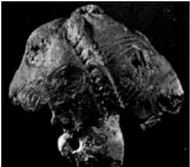










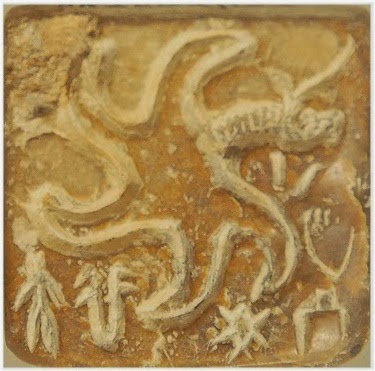









 Figure 15.Serpent hood atop tree branches. Sanchi sculptural frieze.
Figure 15.Serpent hood atop tree branches. Sanchi sculptural frieze.  Fig. 2
Fig. 2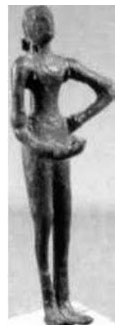 Fig.3
Fig.3 Fig. 4
Fig. 4 Fig.5
Fig.5 Fig.6
Fig.6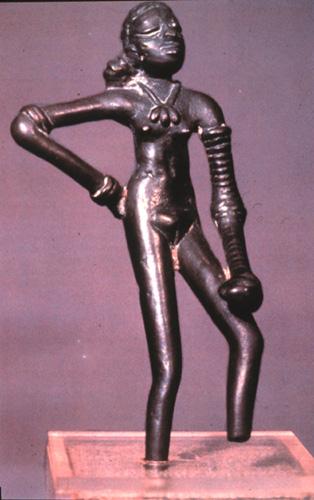 Fig.7
Fig.7
 Fig. 10
Fig. 10

 Santali glosses.
Santali glosses. Figure 12. Siddhivinayaka Ganapati. Wears a hooded snake as belt.
Figure 12. Siddhivinayaka Ganapati. Wears a hooded snake as belt. Figure 14. Cobra hood seen on the sculpture, on the left shoulder of .Gaṇeśa.
Figure 14. Cobra hood seen on the sculpture, on the left shoulder of .Gaṇeśa.




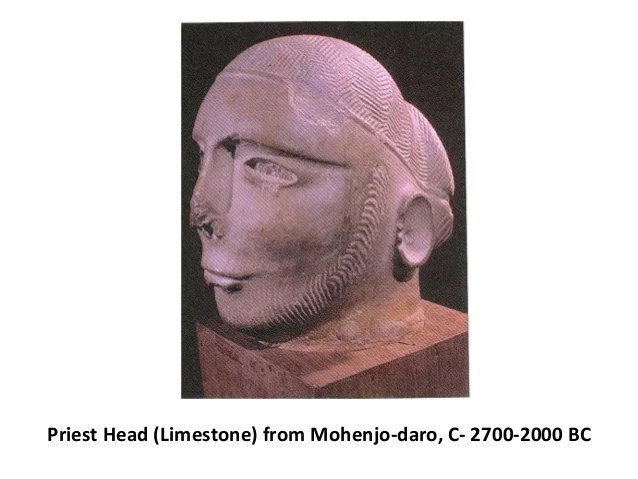






















































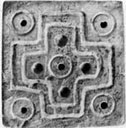


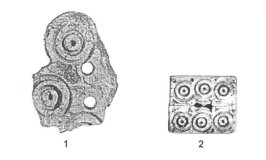 Artifacts from Jiroft.
Artifacts from Jiroft.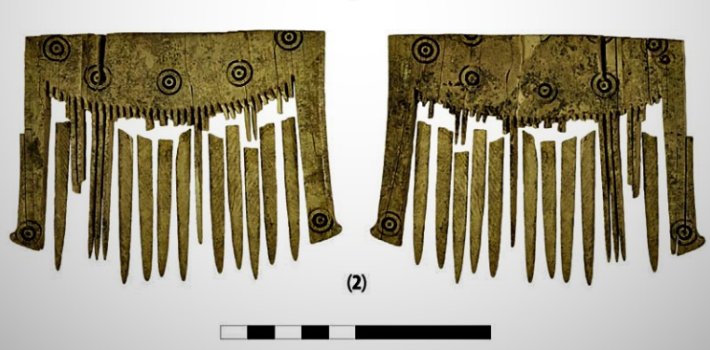
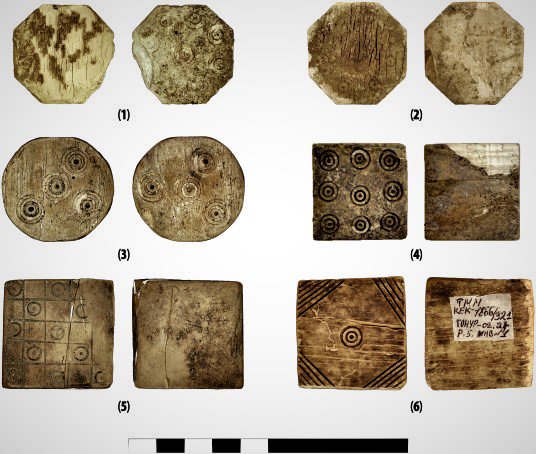
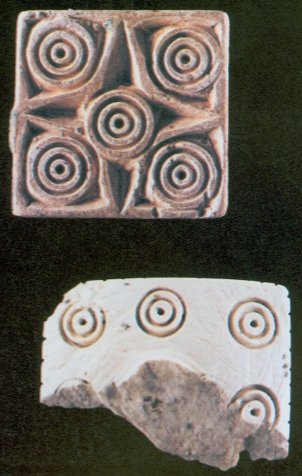
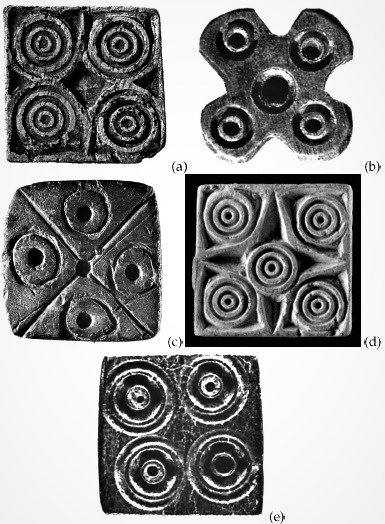
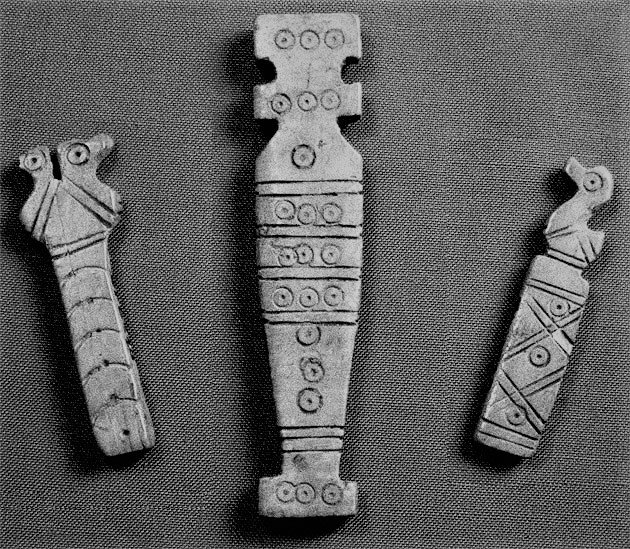
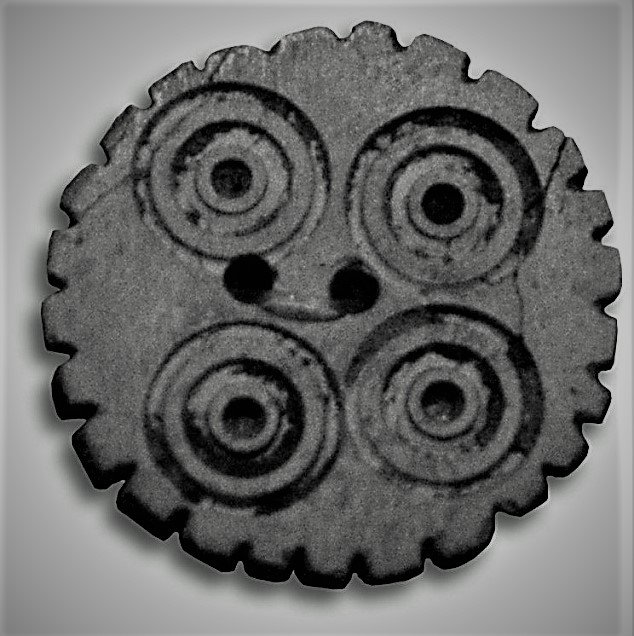
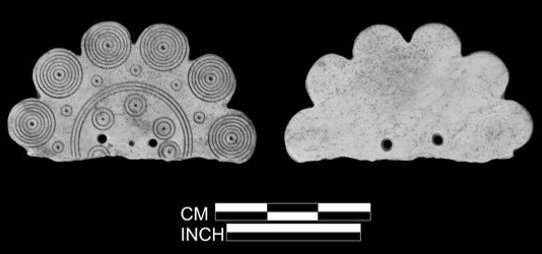

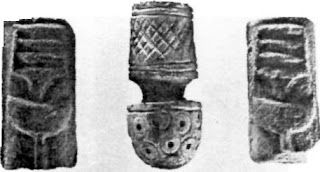
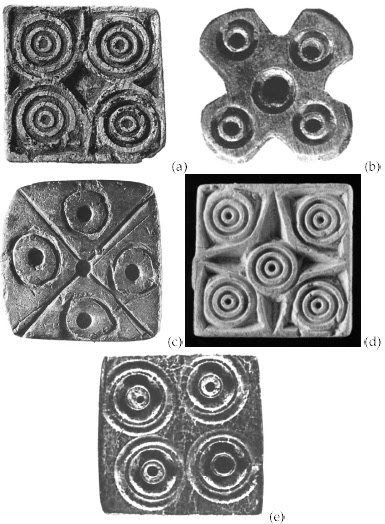

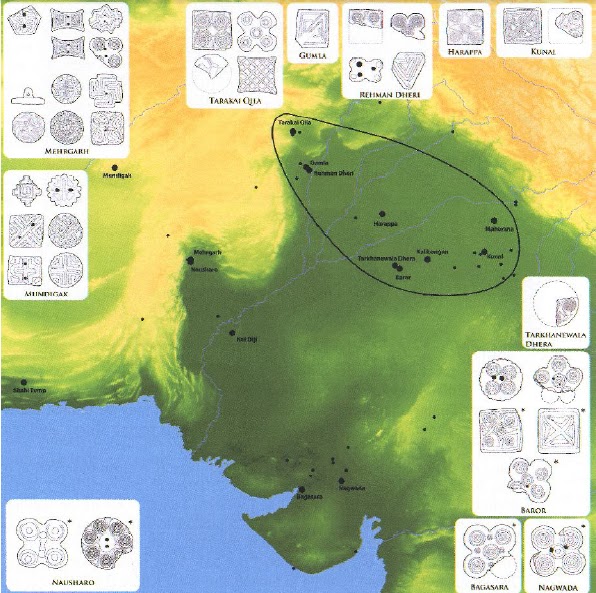



 Mohenjo-daro (Ashmolean Museum), Harappa dice.. दाय 1 [p=
Mohenjo-daro (Ashmolean Museum), Harappa dice.. दाय 1 [p= 
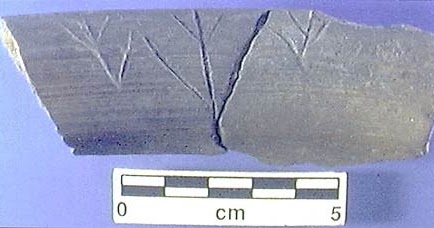
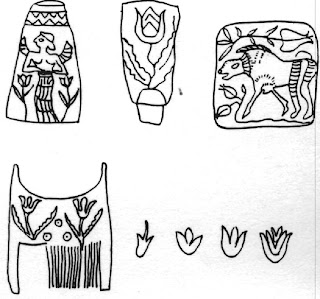

--510x286.jpg) Found in a tomb in Tell Abraq
Found in a tomb in Tell Abraq

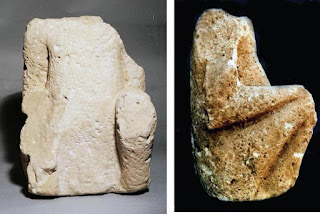 Dholavira. Stone statue.
Dholavira. Stone statue. 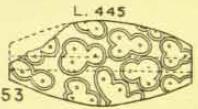
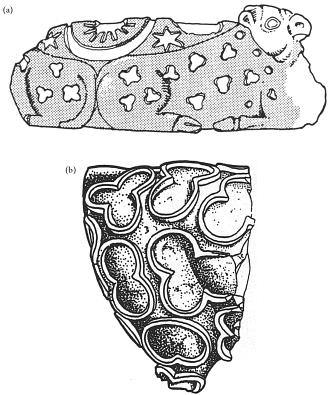
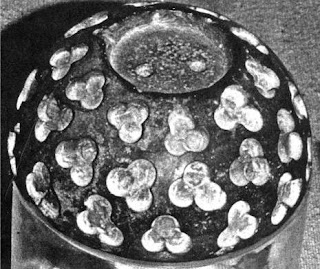










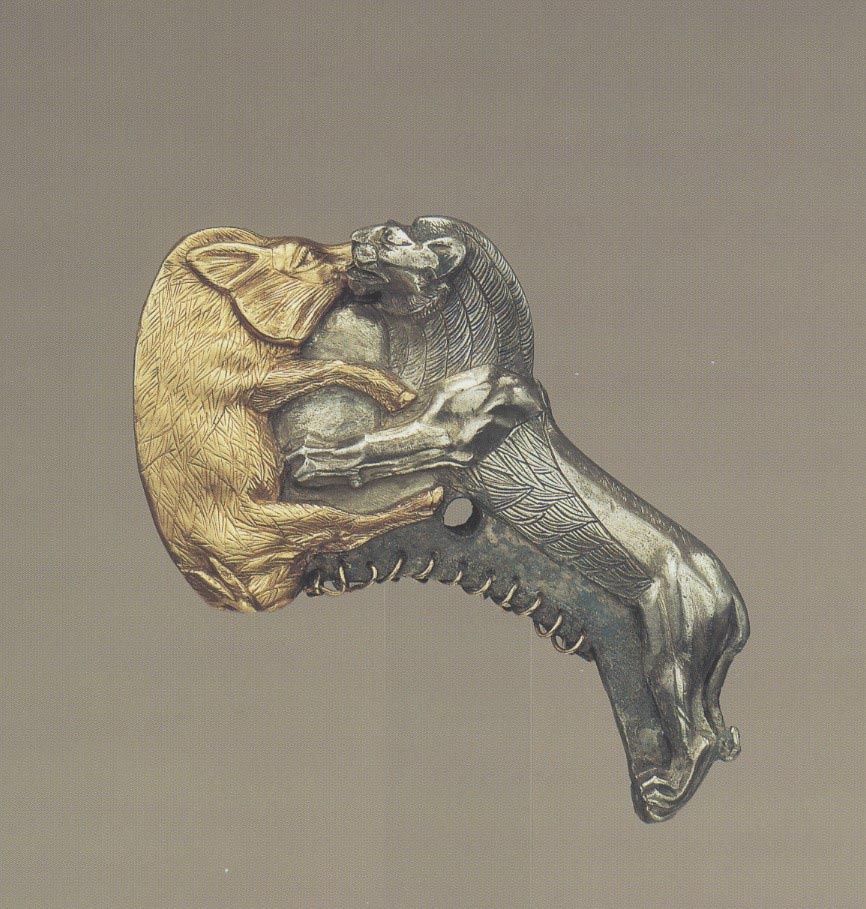






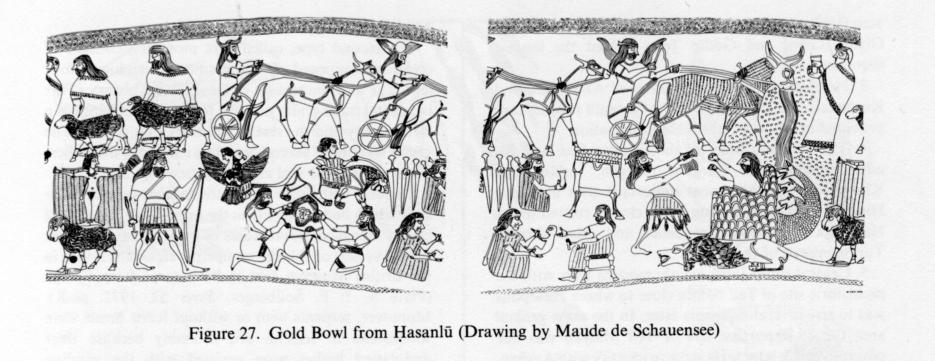



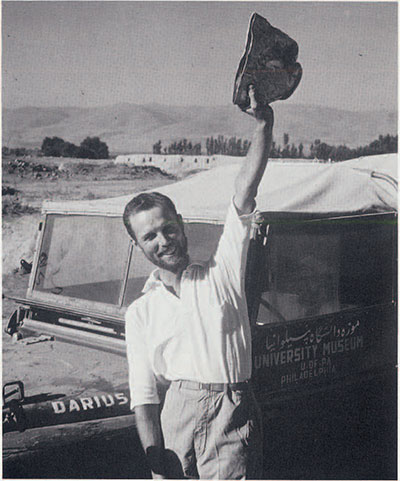
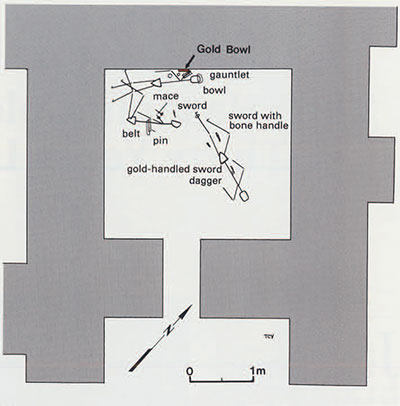
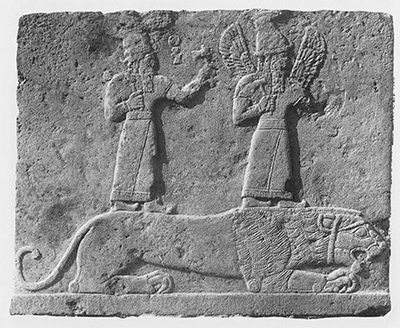
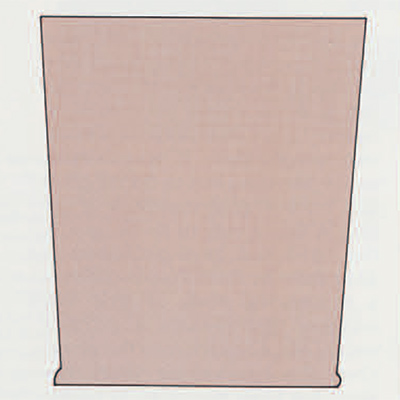
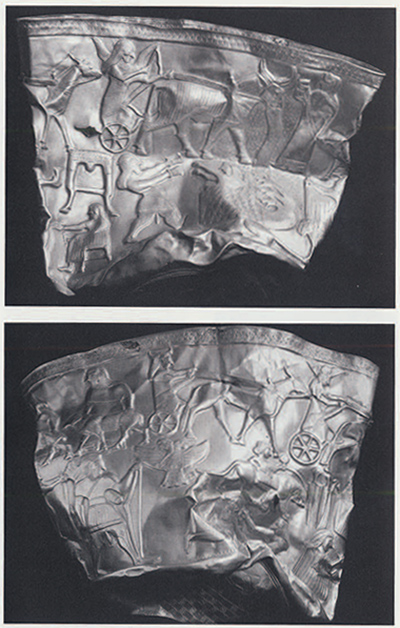
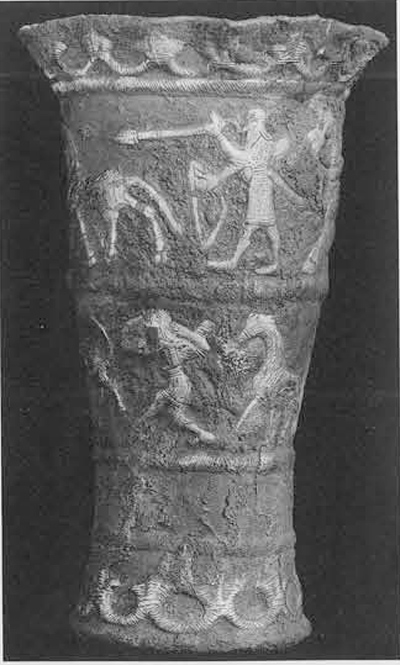
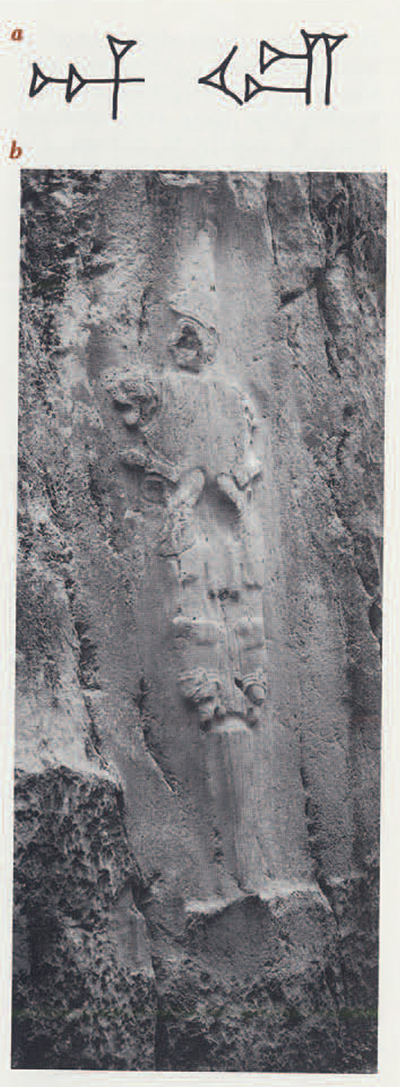
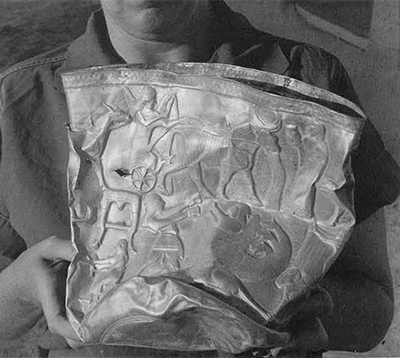
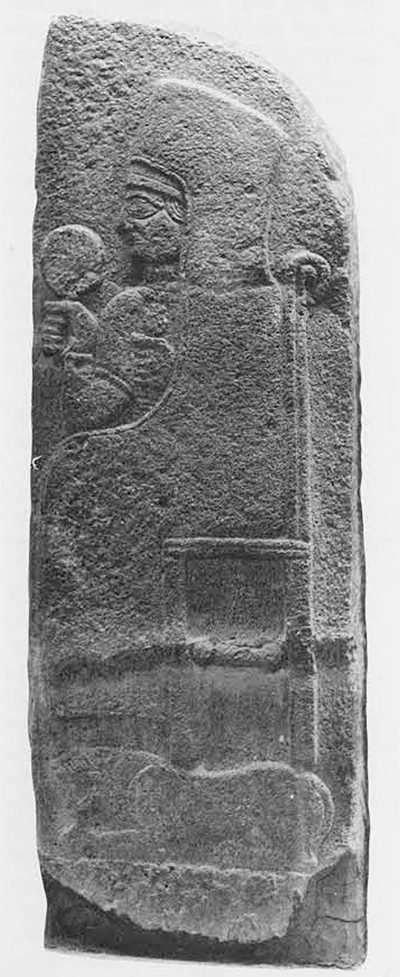

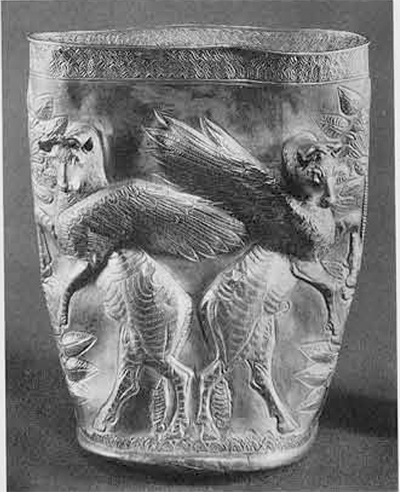
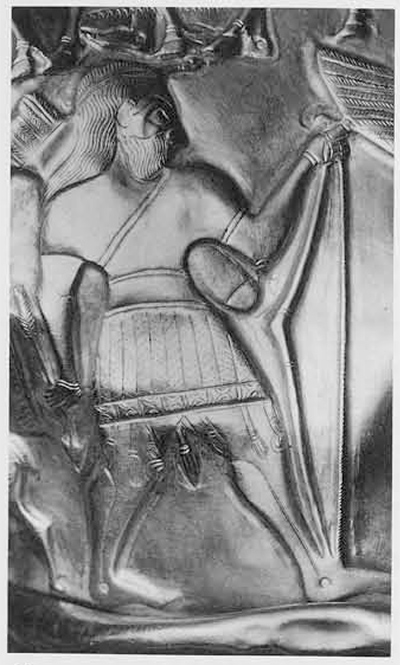
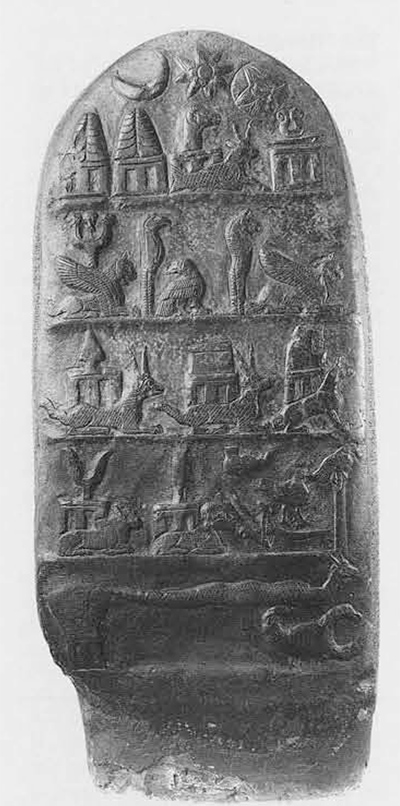
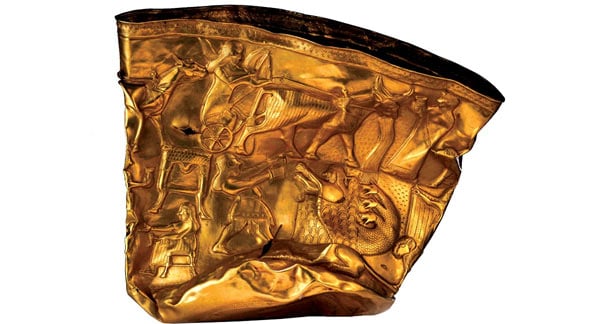

























































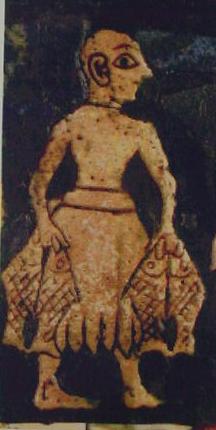



















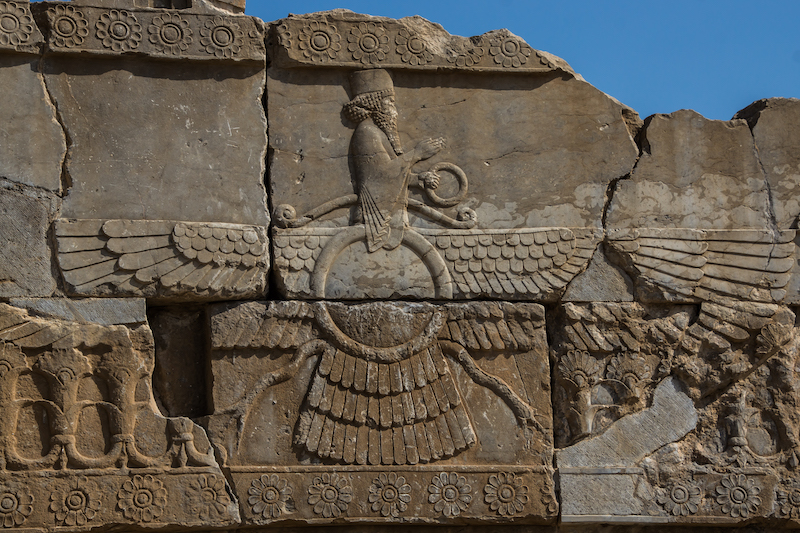










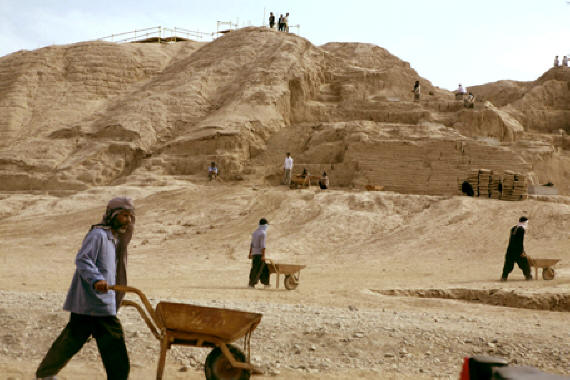
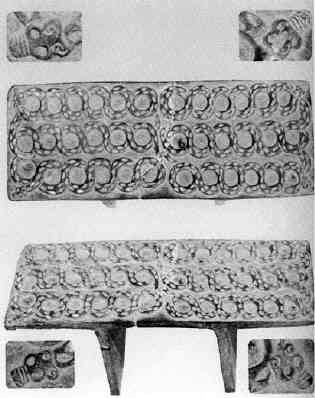
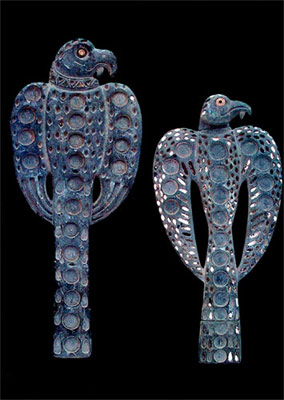







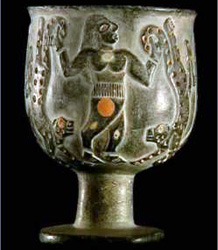











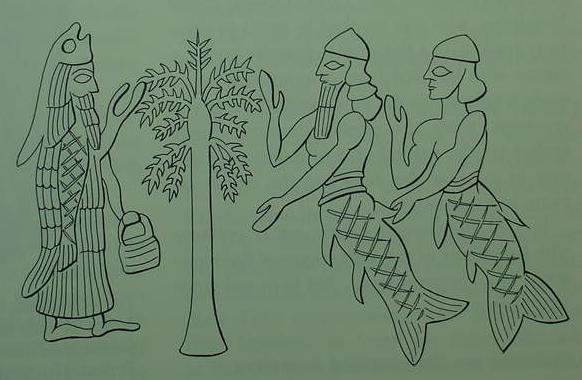
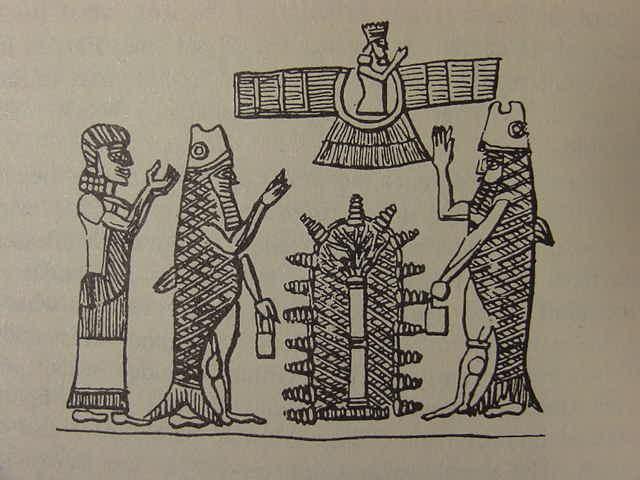












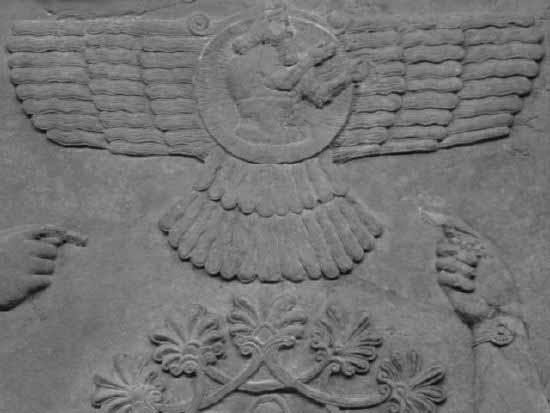
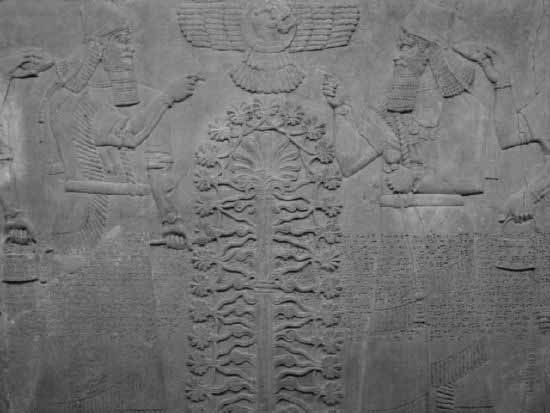
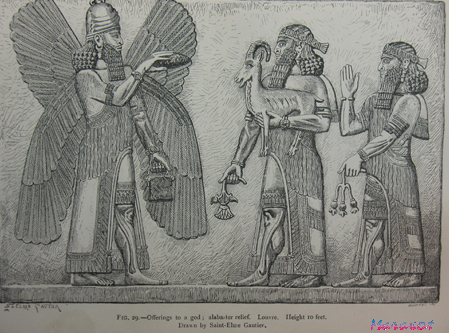











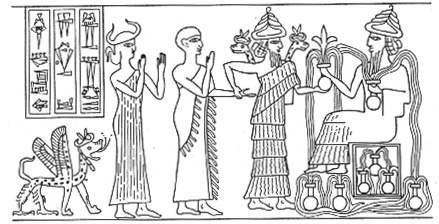


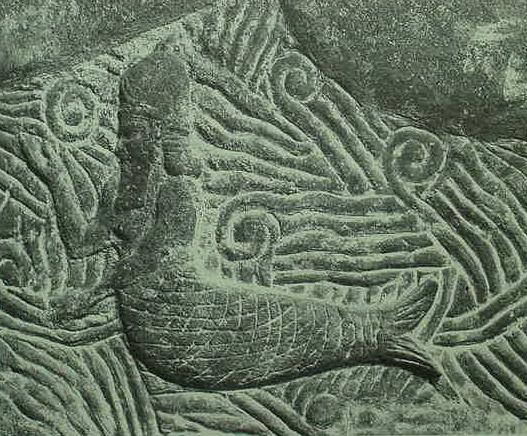




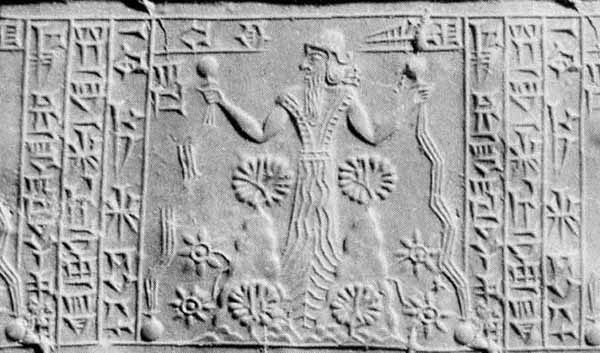


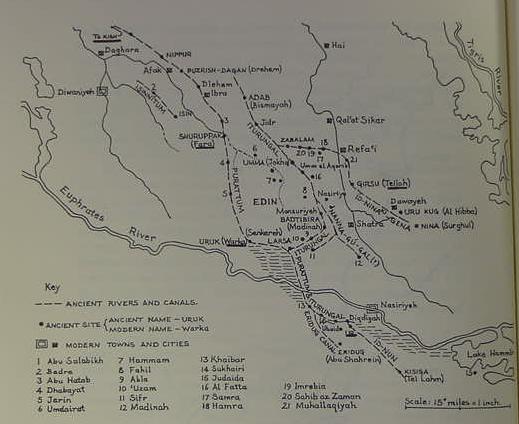


 Gudea. Overflowing pot. Sumer.
Gudea. Overflowing pot. Sumer.
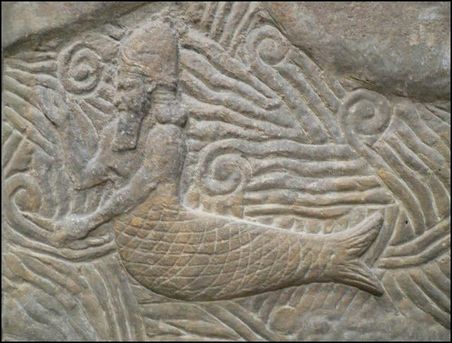 Sumerian relief. Louvre.
Sumerian relief. Louvre. 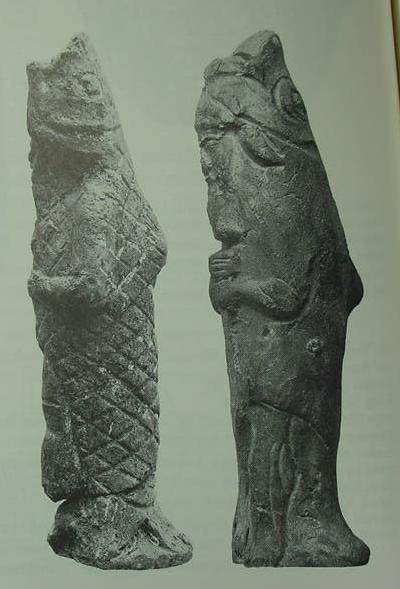











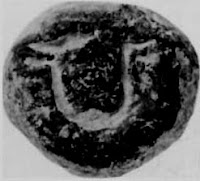



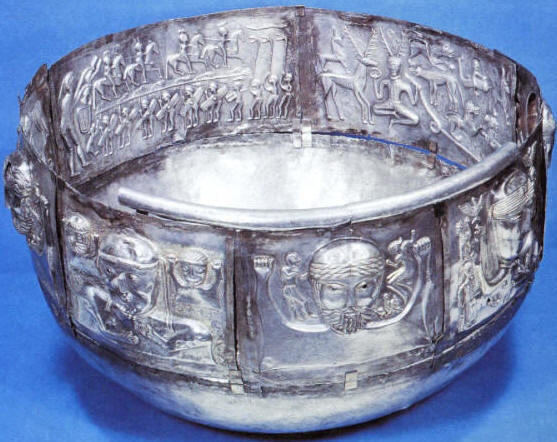
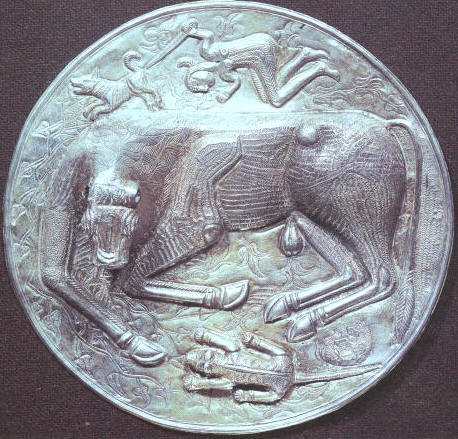
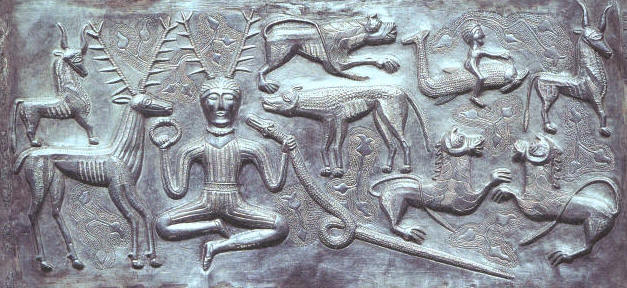






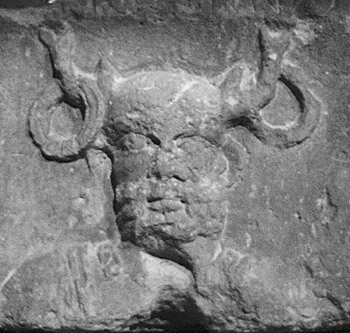 K(C)ernunnos is shown seated in penance (comparable to the sitting posture of the seated person on the Mohenjo-daro seal m0304).
K(C)ernunnos is shown seated in penance (comparable to the sitting posture of the seated person on the Mohenjo-daro seal m0304). 
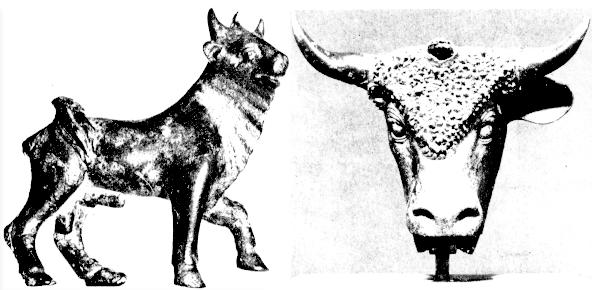


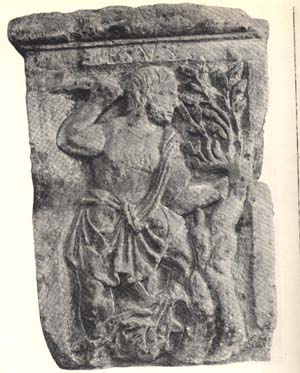 "
"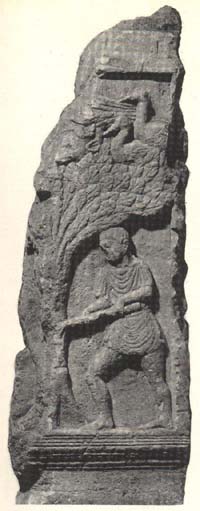 (Mac Cana, page 35)
(Mac Cana, page 35)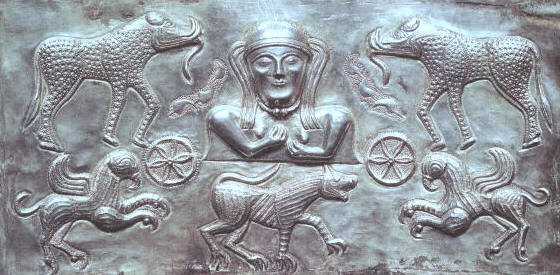 Plate B "This plate shows an antithetical arrangement of animals around a bust of a goddess. The goddess is presented in the center with a six-spoked rosette wheel on either side of her. She is flanked by two elephants confronting each other. Below them are two griffins arranged in the same antithetical manner and a hound is placed in the lower center of the plate, between these two griffins. The goddess seems almost identical with the goddess on
Plate B "This plate shows an antithetical arrangement of animals around a bust of a goddess. The goddess is presented in the center with a six-spoked rosette wheel on either side of her. She is flanked by two elephants confronting each other. Below them are two griffins arranged in the same antithetical manner and a hound is placed in the lower center of the plate, between these two griffins. The goddess seems almost identical with the goddess on 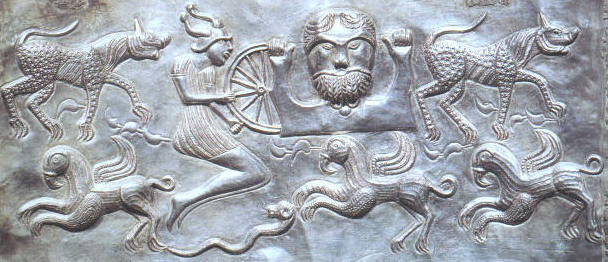 Plate C "This plate shows an intriguing iconography of two deities with a broken wheel: in the center of the plate, a bust of a bearded deity is depicted with a half-shaped wheel on his right side and a full-length leaping figure is holding the rim of the wheel from the right. Under this leaping figure, a horned serpent is presented. The rest of animals are placed clockwise around this group of two deities: in the upper part of the plate, two identical beasts are depicted on either side of the group, both facing the left side of the deities and in the lower part, three griffins are depicted in parallel, all facing the right side of the deities. The space between the upper and lower group of the animals is filled with some botanical patterns which are usually identified as ivy tendrils.
Plate C "This plate shows an intriguing iconography of two deities with a broken wheel: in the center of the plate, a bust of a bearded deity is depicted with a half-shaped wheel on his right side and a full-length leaping figure is holding the rim of the wheel from the right. Under this leaping figure, a horned serpent is presented. The rest of animals are placed clockwise around this group of two deities: in the upper part of the plate, two identical beasts are depicted on either side of the group, both facing the left side of the deities and in the lower part, three griffins are depicted in parallel, all facing the right side of the deities. The space between the upper and lower group of the animals is filled with some botanical patterns which are usually identified as ivy tendrils.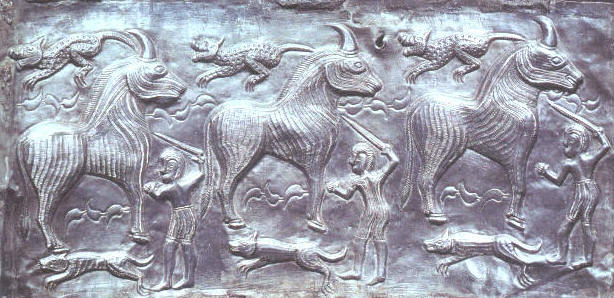 Plate D "On the lower right side of each bull, a man is standing in the posture of attacking the bull with a sword. Under the feet of each bull, by the side of each man, a dog is depicted as running toward the left while a cat-like creature is running in the same direction over the back of the bull. These cats as well as the dogs have the same hanging feet. As shown in other plates, the spaces between each figure are filled with tear-drop shaped leaves."
Plate D "On the lower right side of each bull, a man is standing in the posture of attacking the bull with a sword. Under the feet of each bull, by the side of each man, a dog is depicted as running toward the left while a cat-like creature is running in the same direction over the back of the bull. These cats as well as the dogs have the same hanging feet. As shown in other plates, the spaces between each figure are filled with tear-drop shaped leaves."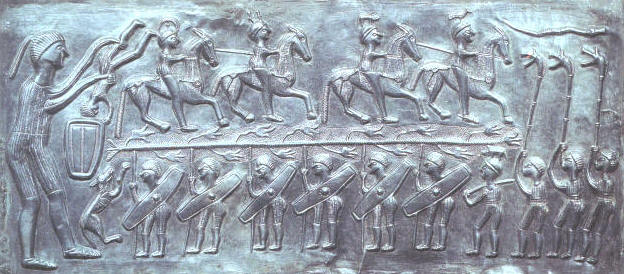
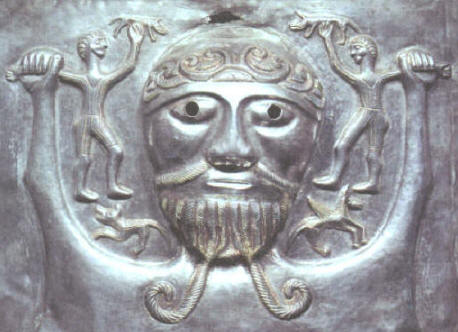 Outer plate a "On plate (a), a bearded god holds a small man in each hand over his shoulders. He is in so-called "orans position"with his arms raised. Like another male god on
Outer plate a "On plate (a), a bearded god holds a small man in each hand over his shoulders. He is in so-called "orans position"with his arms raised. Like another male god on 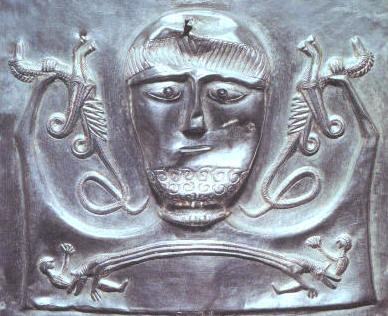 Outer plate b "Plate (b) shows a male deity holding two sea horses or dragons. These two animals have the mixed characters of horse and dragon; they have a long, serpentine body of a dragon and a horse-like head and two front legs. Their ribs are prominently fluted and the tails and wings are swirled. Below the god is a double-headed monster attacking small figures of fallen men...as early as 1913, Hubert suggested that this scene should be related to the sea or water since the god holds the sea horses. "
Outer plate b "Plate (b) shows a male deity holding two sea horses or dragons. These two animals have the mixed characters of horse and dragon; they have a long, serpentine body of a dragon and a horse-like head and two front legs. Their ribs are prominently fluted and the tails and wings are swirled. Below the god is a double-headed monster attacking small figures of fallen men...as early as 1913, Hubert suggested that this scene should be related to the sea or water since the god holds the sea horses. "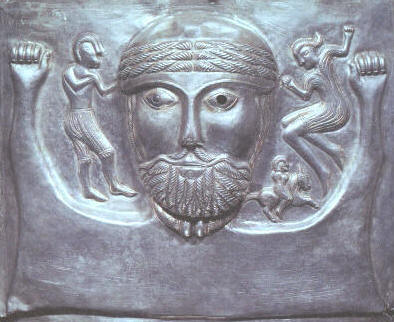 Outer plate c '"This plates shows a deity with his upraised hands in "orans position" as the other male gods on the outer plates. However, unlike the others, his hands are empty. He has a boxing man at his right and on the left is a leaping figure with a small horse rider below it. The leaping figure is similar to the one on the
Outer plate c '"This plates shows a deity with his upraised hands in "orans position" as the other male gods on the outer plates. However, unlike the others, his hands are empty. He has a boxing man at his right and on the left is a leaping figure with a small horse rider below it. The leaping figure is similar to the one on the 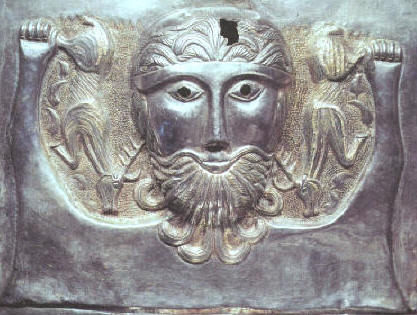 Outer plate d "The iconographic details of this plate are comparatively clear: a bearded god is holding two stags in each hand. Stylistically, this plate share some characteristics with the
Outer plate d "The iconographic details of this plate are comparatively clear: a bearded god is holding two stags in each hand. Stylistically, this plate share some characteristics with the 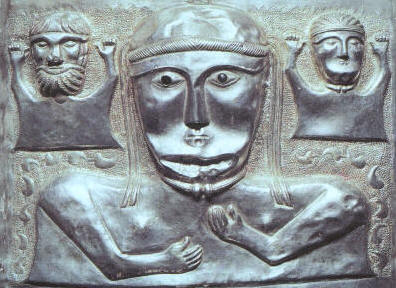 Outer plate e "Plate (e) shows a bust of a goddess in the center and the smaller busts of two male gods on her shoulders. She wears a torque and has a typical mask-like face with her small mouth and T-shaped eye brows and nose. The bearded deity on her right shoulder is almost identical with the central god on the inner
Outer plate e "Plate (e) shows a bust of a goddess in the center and the smaller busts of two male gods on her shoulders. She wears a torque and has a typical mask-like face with her small mouth and T-shaped eye brows and nose. The bearded deity on her right shoulder is almost identical with the central god on the inner 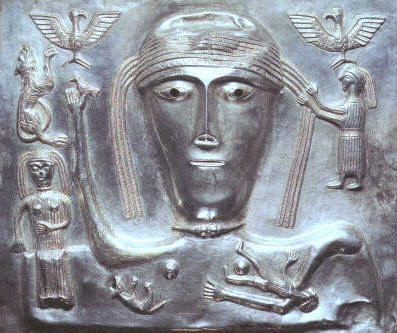 Outer plate f "Plate (f) shows an interesting iconography. The central goddess holds a small bird in her upraised right hand while her left arm is placed across her chest. Crossed over her left arm is lying a small man and on the opposite side to the man is a dog upside down. Some have suggested that the goddess is cradling the two figures on her chest. But this would hardly be the case because the figures are depicted as fallen rather than cradled.(Davison: 498) The goddess has two birds of prey - which may be eagles or ravens - on either side of her head. On her right shoulder is seated a small female figure, over whose head is a lion-like animal runs. On the left side, another small figure is holding the hair of the goddess as if plaiting her hair. Olmsted notes that the small bird in her right hand is same as that on the helmet on
Outer plate f "Plate (f) shows an interesting iconography. The central goddess holds a small bird in her upraised right hand while her left arm is placed across her chest. Crossed over her left arm is lying a small man and on the opposite side to the man is a dog upside down. Some have suggested that the goddess is cradling the two figures on her chest. But this would hardly be the case because the figures are depicted as fallen rather than cradled.(Davison: 498) The goddess has two birds of prey - which may be eagles or ravens - on either side of her head. On her right shoulder is seated a small female figure, over whose head is a lion-like animal runs. On the left side, another small figure is holding the hair of the goddess as if plaiting her hair. Olmsted notes that the small bird in her right hand is same as that on the helmet on 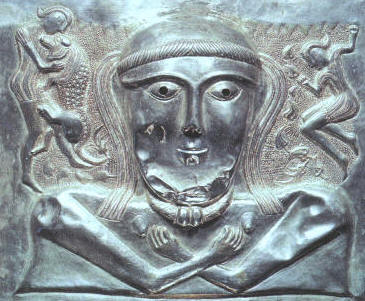 Outer plate g ".The goddess is crossing her arms on the chest. On her right shoulder is a man struggling with a lion and on the left is a leaping figure who is almost identical with the one on
Outer plate g ".The goddess is crossing her arms on the chest. On her right shoulder is a man struggling with a lion and on the left is a leaping figure who is almost identical with the one on 













